Allison Collection Photos
December, 1942
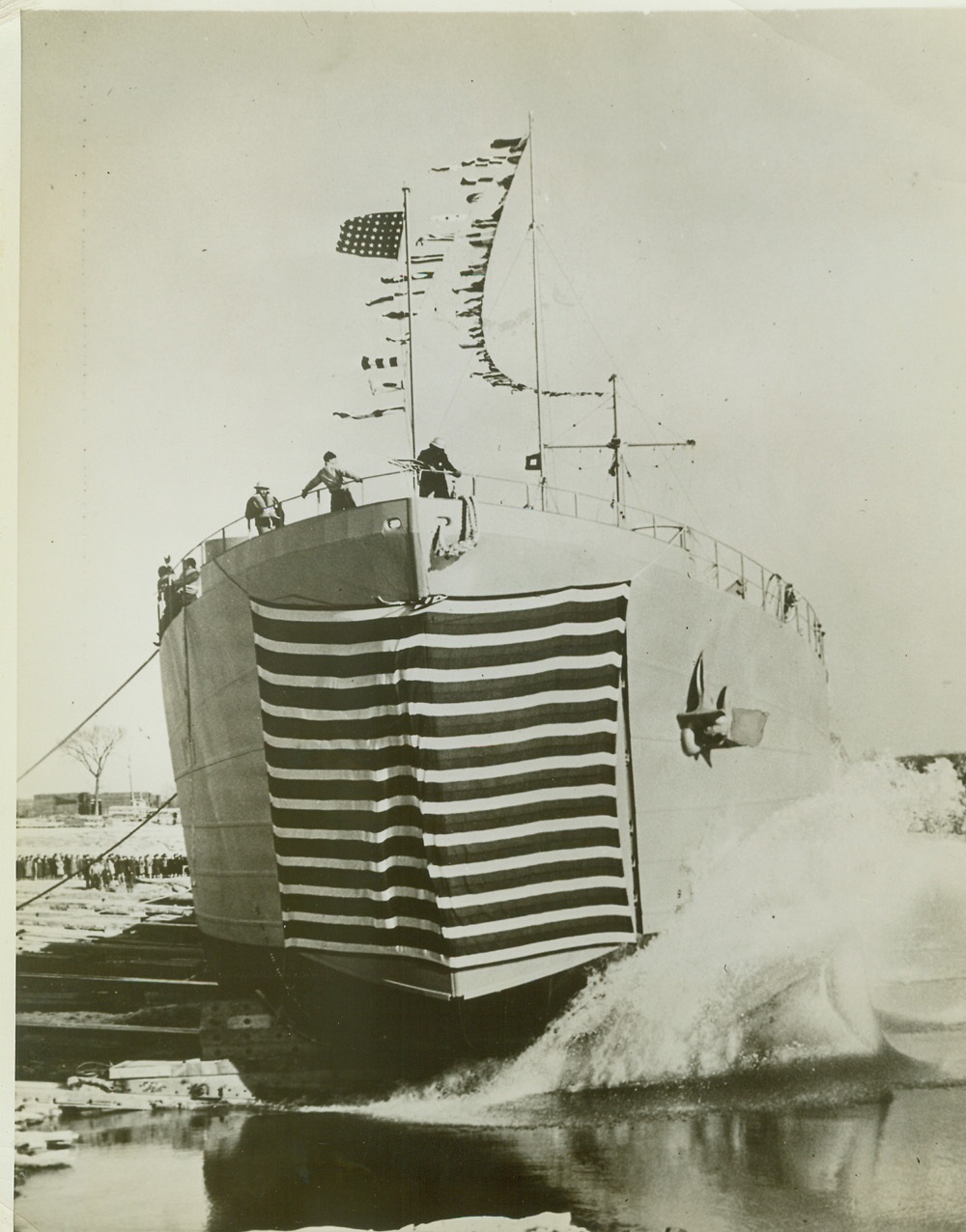
Tank Landing Vessel Launched by Woman Welder, 12/13/1942. SENECA, ILL. – A new tank landing vessel being launched at Seneca, Ill. plant of Chicago Bridge and Iron Co. in honor of the many women workers who helped build the ship Mrs. Harriet Williamson a welder for the company performed the christening ceremony. Credit: (ACME);
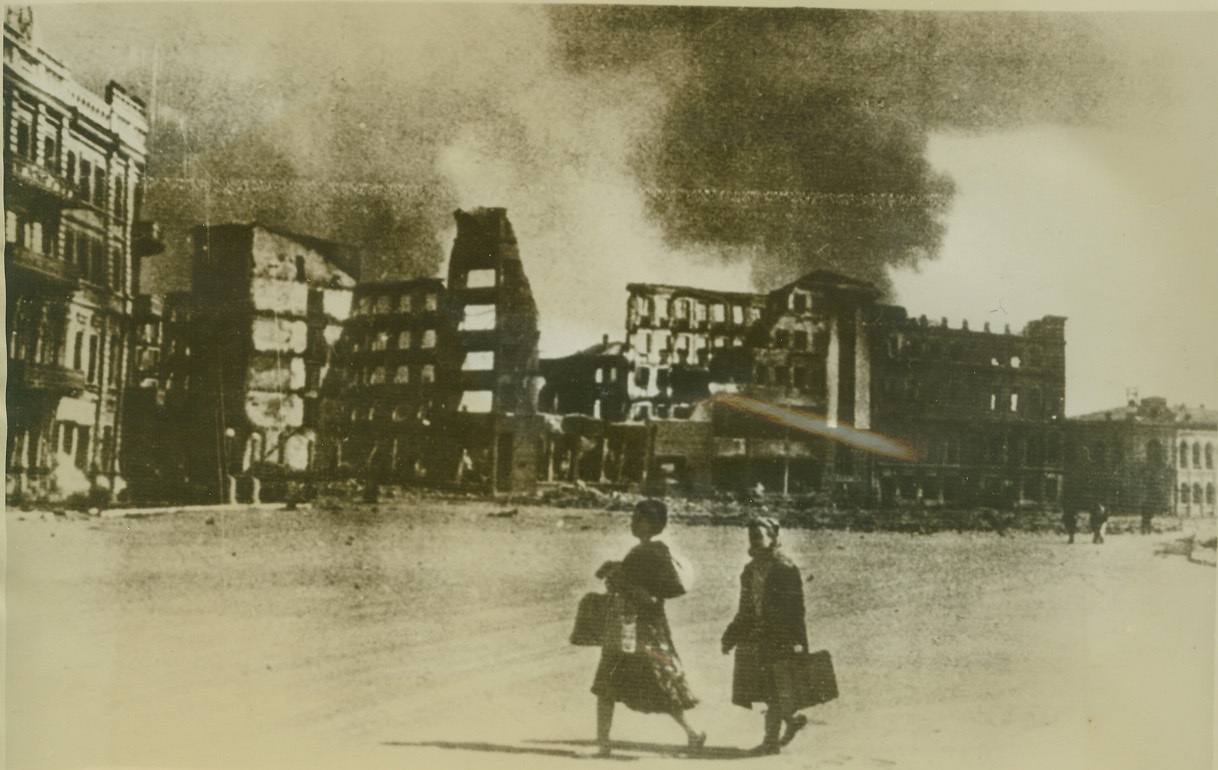
First Glimpse Inside Stalingrad, 12/14/1942. Stalingrad, Russia – For many months a lack of photographers shrouded the bloody battle for Stalingrad in half-mystery. This is one of the first pictures to be issued showing the inside of the besieged Russian stronghold with its blazing, debris-strewn streets. Russian women are shown carrying supplies to grim defenders who now have reversed their roles and are attacking the Nazis. Credit: (ACME);

Mortar Fire for Japs, 12/15/1942.
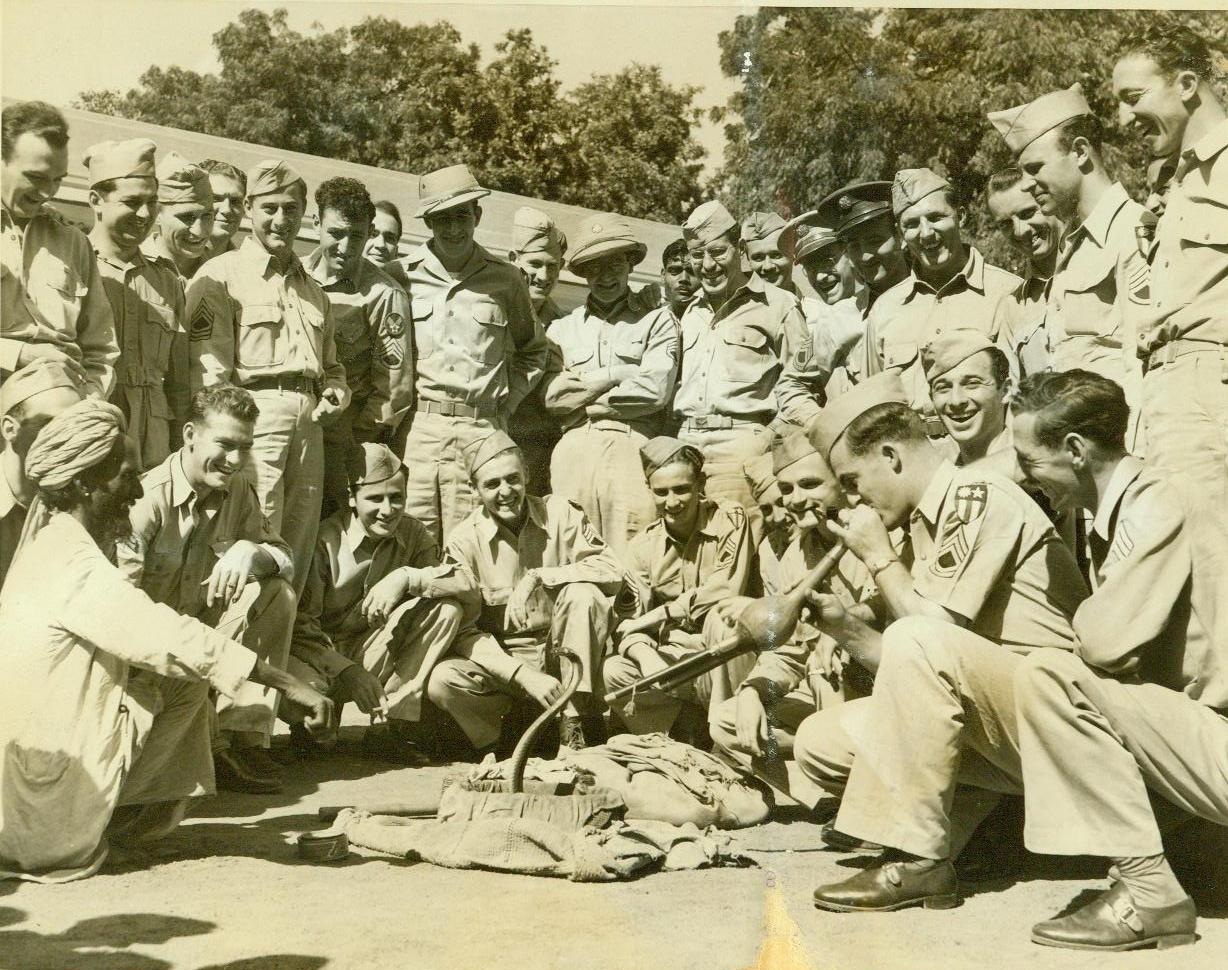
”MUSIC HATH CHARMS -!”, 12/17/1942. INDIA – A crowd of American soldiers stationed in India, watch a buddy, Sgt. John Stafford, of West Point, Miss., (in front, second from right), tackle the ticklish job of charming a hooded cobra. The native snake charmer, (left, front), stands by in case Johnny runs out of wind. Credit: ACME;
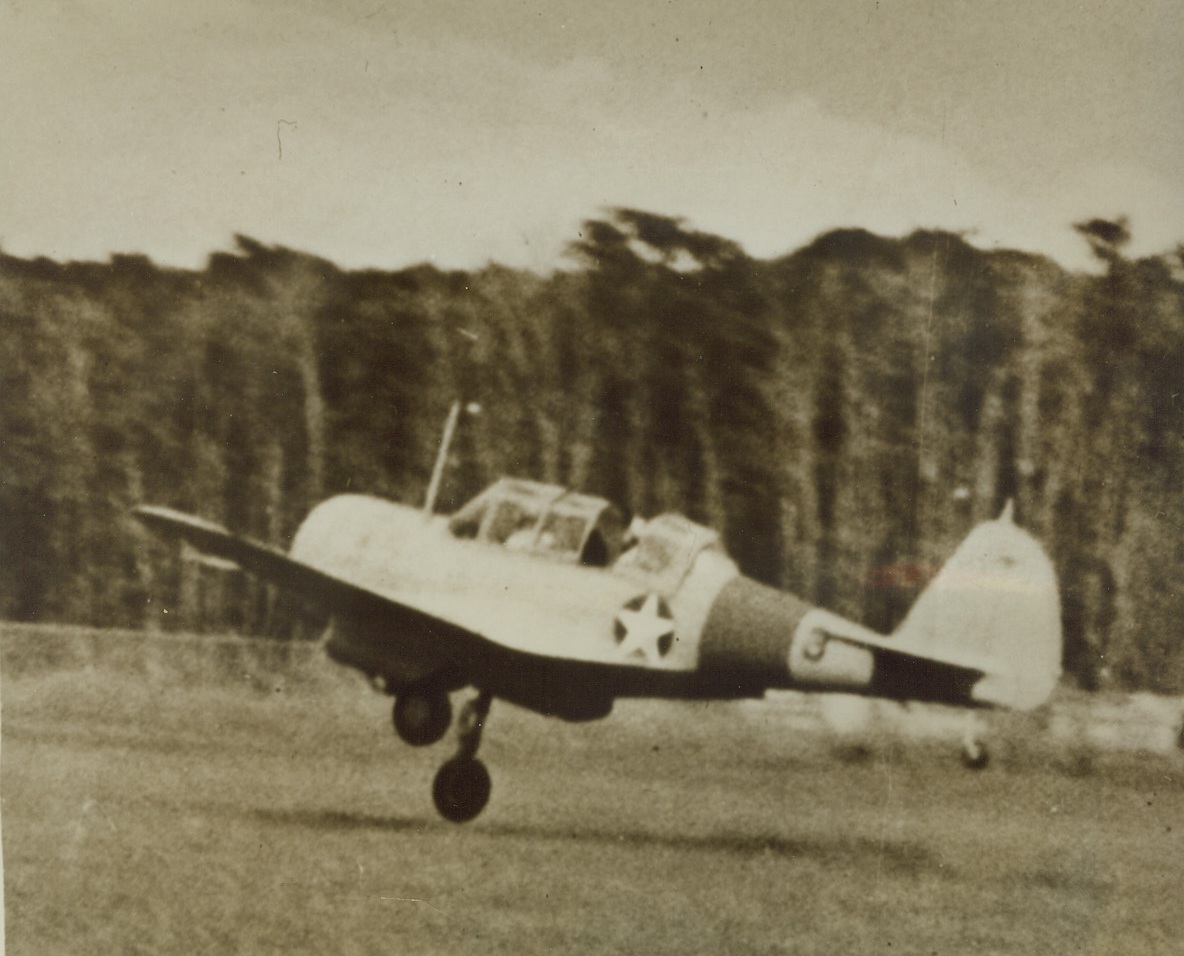
TICKLISH LANDING, 12/18/1942. Not even a tight rope walker would want to tackle the problem of this U.S. Navy SNC pilot who has one wheel down and the other up. Unable to stay in the air indefinitely, nor to release his jammed landing gear, he had no choice but to come down and make the best of a precarious job. Credit: Official U.S. Navy photo from Acme;
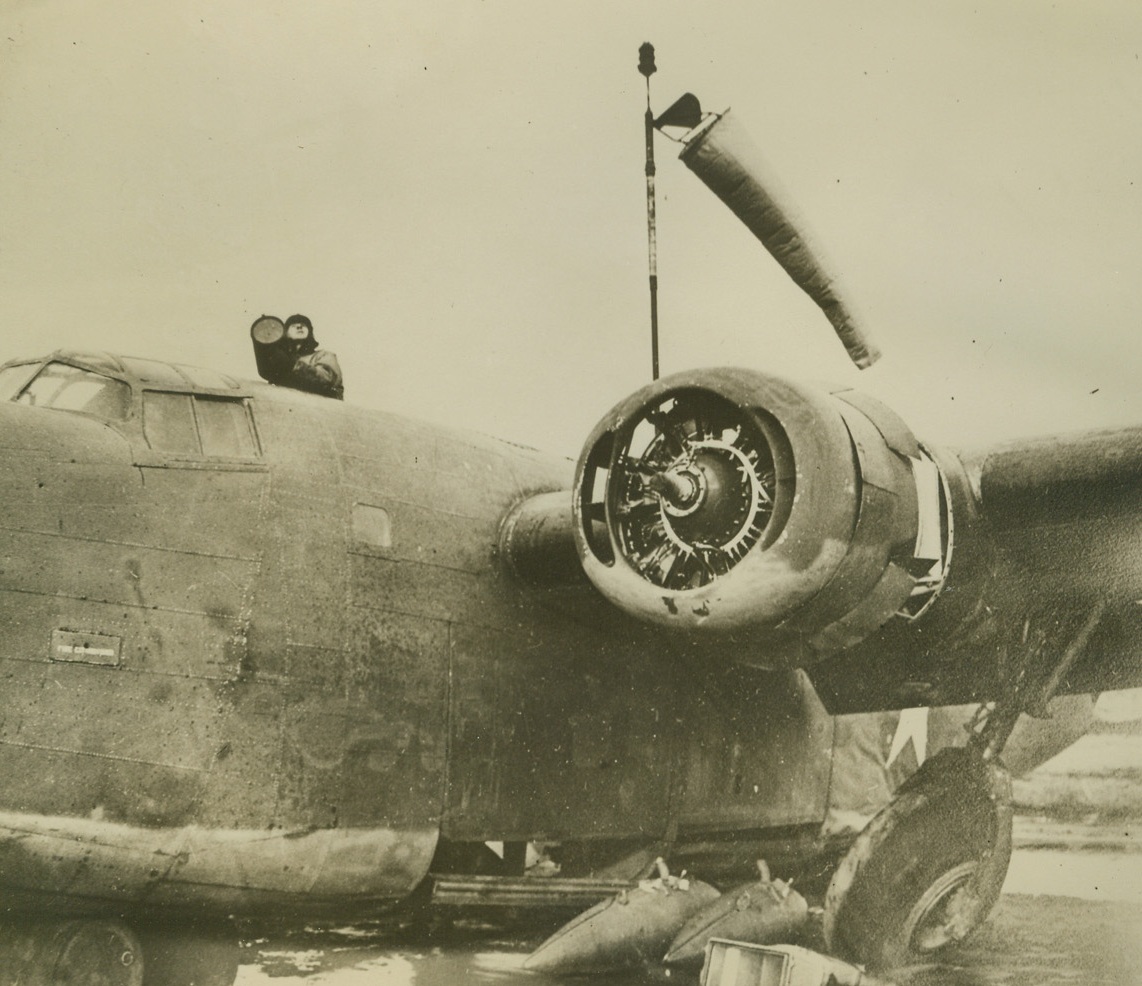
JUNKED BOMBER SERVES AS ALEUTIAN CONTROL TOWER, 12/18/1942. ALEUTIANS—Salvaged after a crash in the Aleutians, this B-24 bomber now serves as a control tower for the airfield where Lt. Col. John Chennault, son of Brig. General Claire L. Chennault, leader of the Flying Tigers, heads his own group of sky-fighters. The control man stands where a gun turret formerly was, and the wind indicator air sock waves from a staff amidships. Credit: Acme;
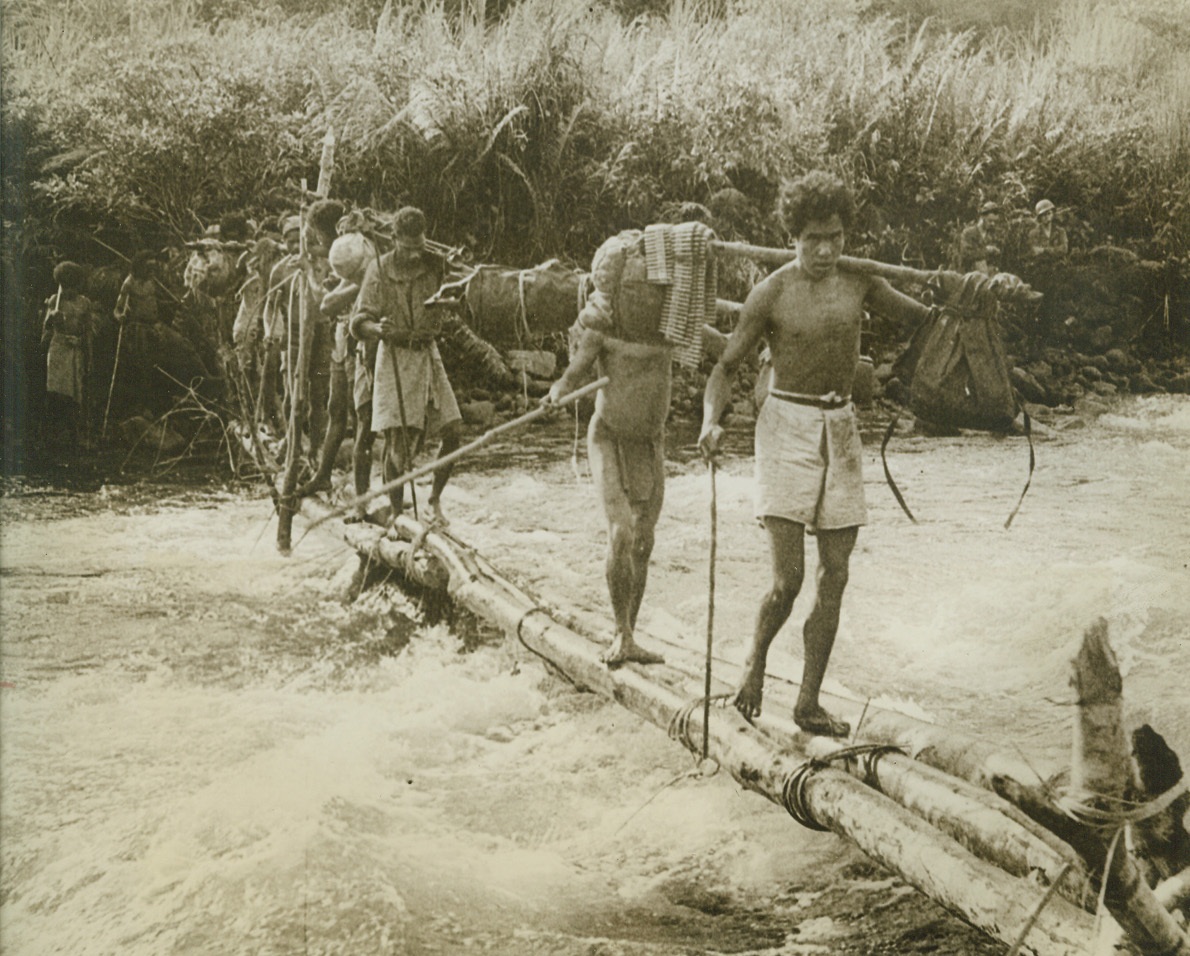
PRECARIOUS CROSSING, 12/19/1942. NEW GUINEA—Sure-footed natives carry equipment and ammunition across a bridge, set up over rushing waters by American troops, in theheart of the New Guinea jungle. After being flown across New Guinea, American and Australian troops had to hike through jungles for six days before they were able to engage the Japs at Buna. Recent reports from Buna indicate heavy fighting in that area, while United Nations bombers carry out raids on enemy installations on Timor Island. Credit: Acme;
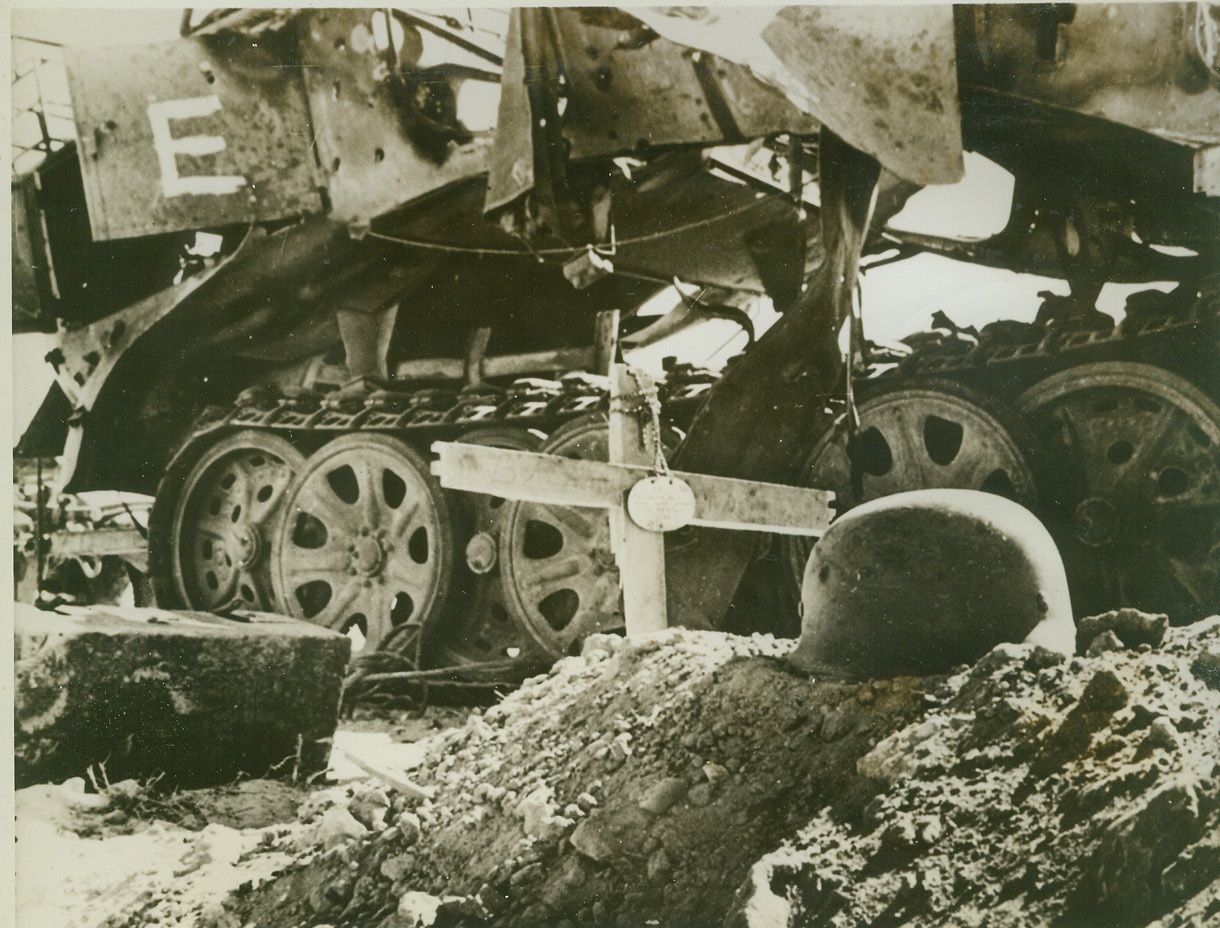
“E” FOR “EXTERMINATION”, 12/2/1942. WESTERN DESERT – The “E” (upper left in photo) painted on this shattered German tank was put there by Allied sappers to signify that it has been “exterminated” completely and that it contains no dangerous explosive charges to act as a booby trap against the Allies. The grave marked with a cross made of box wood marks the “extermination” of a member of the Nazi tank crew. Note dog tag hanging from cross and German helmet. Rommel’s Axis forces, after fleeing from Egypt, are being menaced from front and rear by United Nation’s columns and may be forced into a “Dunkirk” evacuation near Tripoli. (Passed by censors.) Credit: ACME;
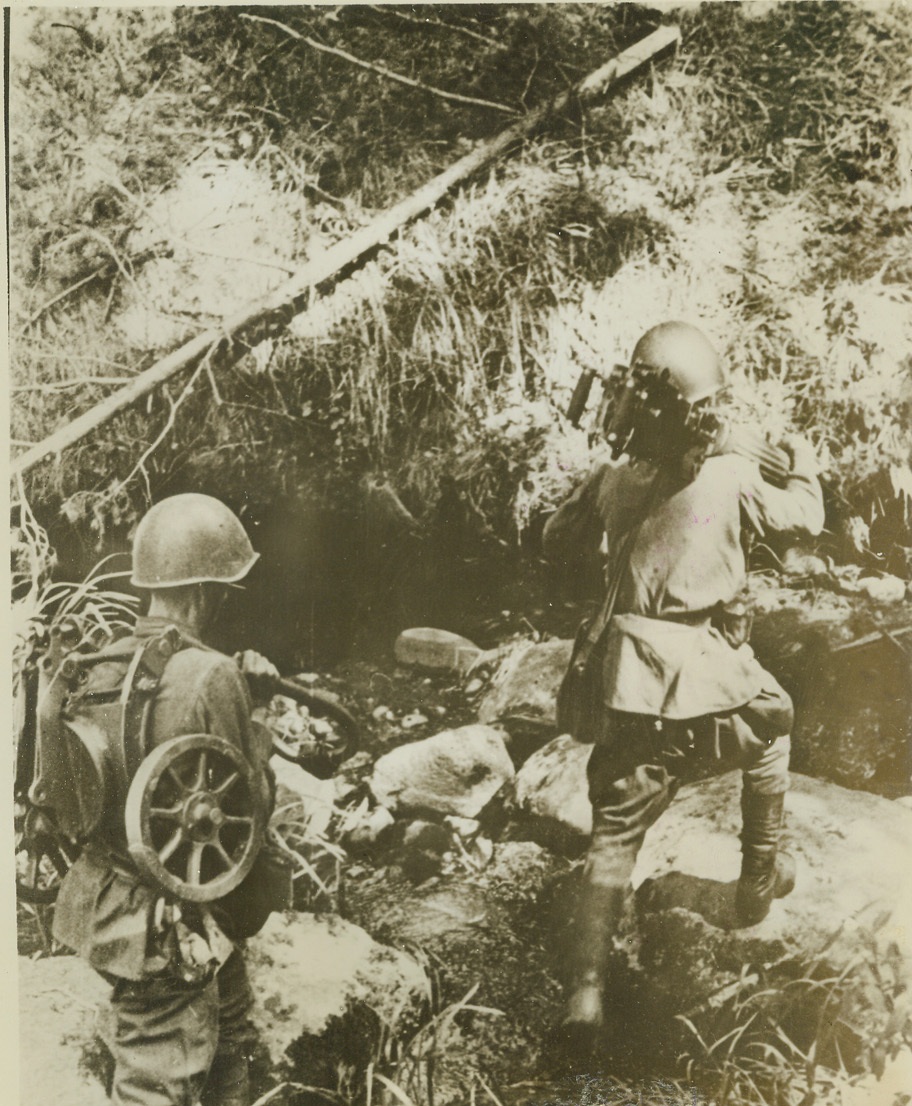
RUSSIAN REDS ON THE ROCKS, 12/2/1942.
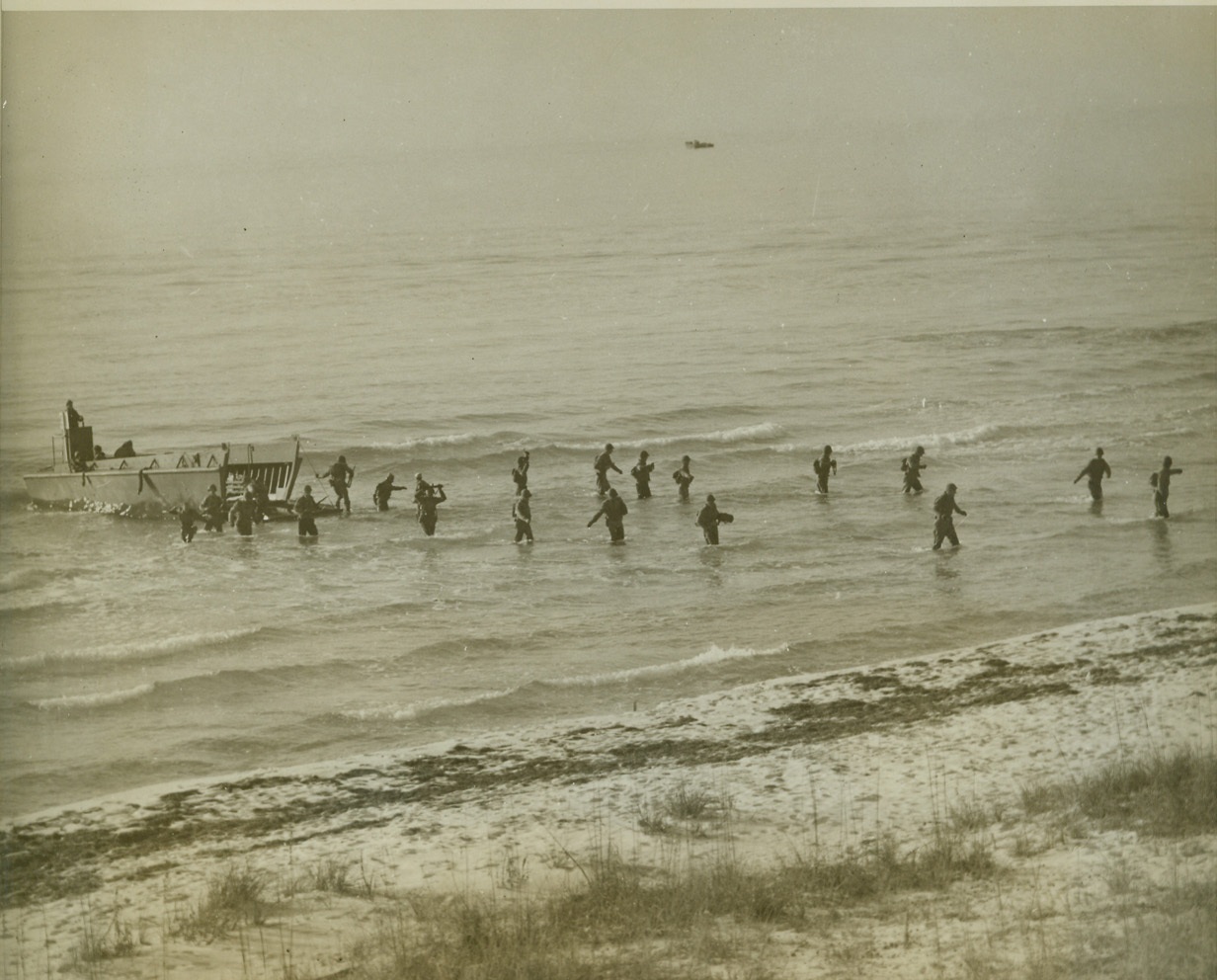
Amphibian Engineers Come Ashore (1), 12/20/1942. Camp Carrabelle, Fla.—Seagoing soldiers of the new Engineer Amphibian Command wade ashore from a landing boat during landing operations which were observed by Lieut. Gen. Leslie J. McNeir, chief of U.S. Army Ground Forces. The Engineer Amphibian Command is Uncle Sam’s latest in combat troops. Credit: ACME.;
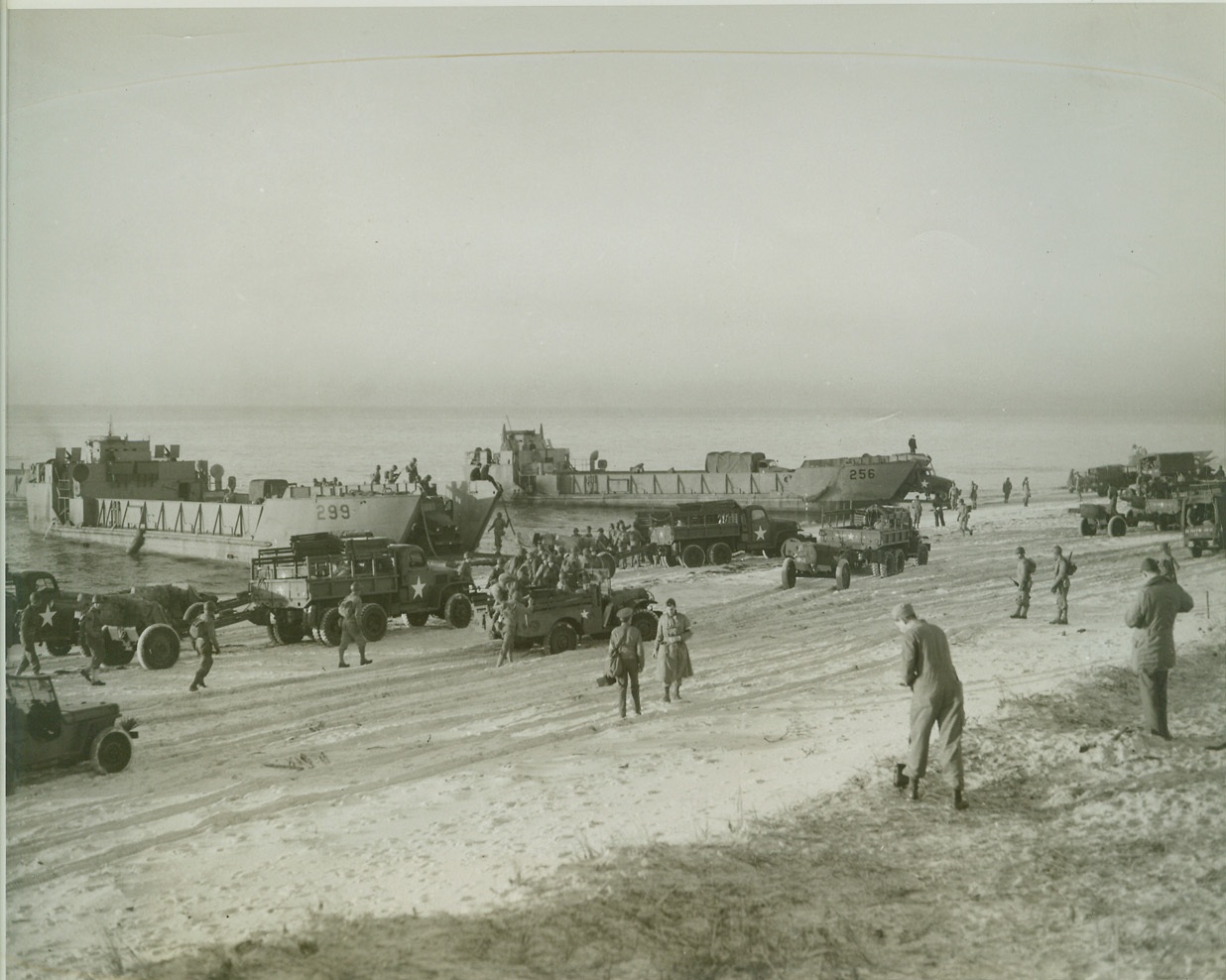
Amphibian Engineers Come Ashore (3), 12/20/1942. Camp Carrabelle, Fla.—General view of beach head established by Engineer Amphibian Command during practice landing operation near here. Note large landing boats used to bring ashore heavy vehicles, guns and supplies. Credit: ACME.;
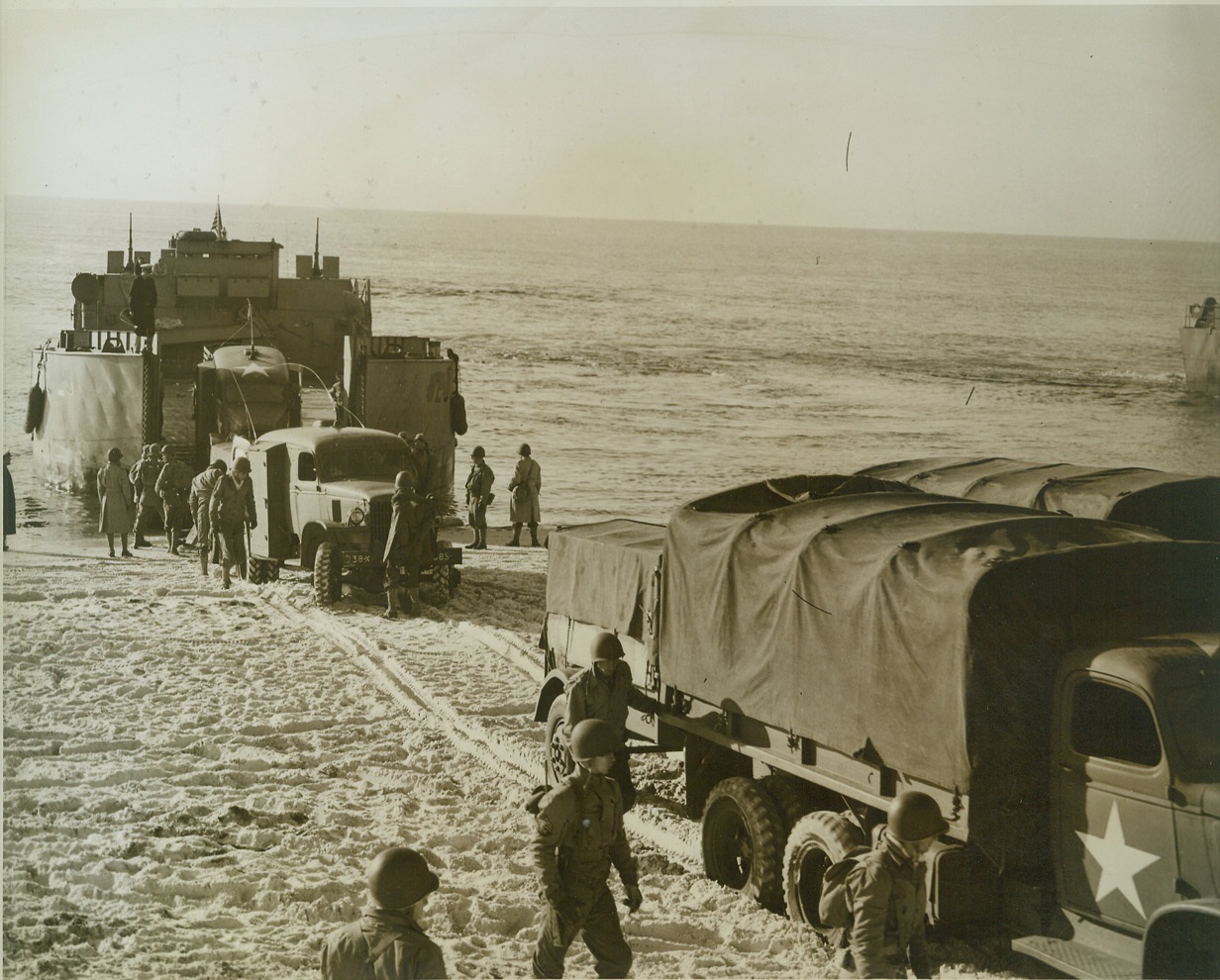
Amphibian Engineers Come Ashore (2), 12/20/1942. Camp Carrabelle, Fla.—Ten-wheel trucks, with guns and supplies trailing, roll off larger landing craft as the Engineer Amphibian Command stages a landing near this camp. This command is the newest in the Army. Credit: U.S. Army Signal Corps from ACME.;
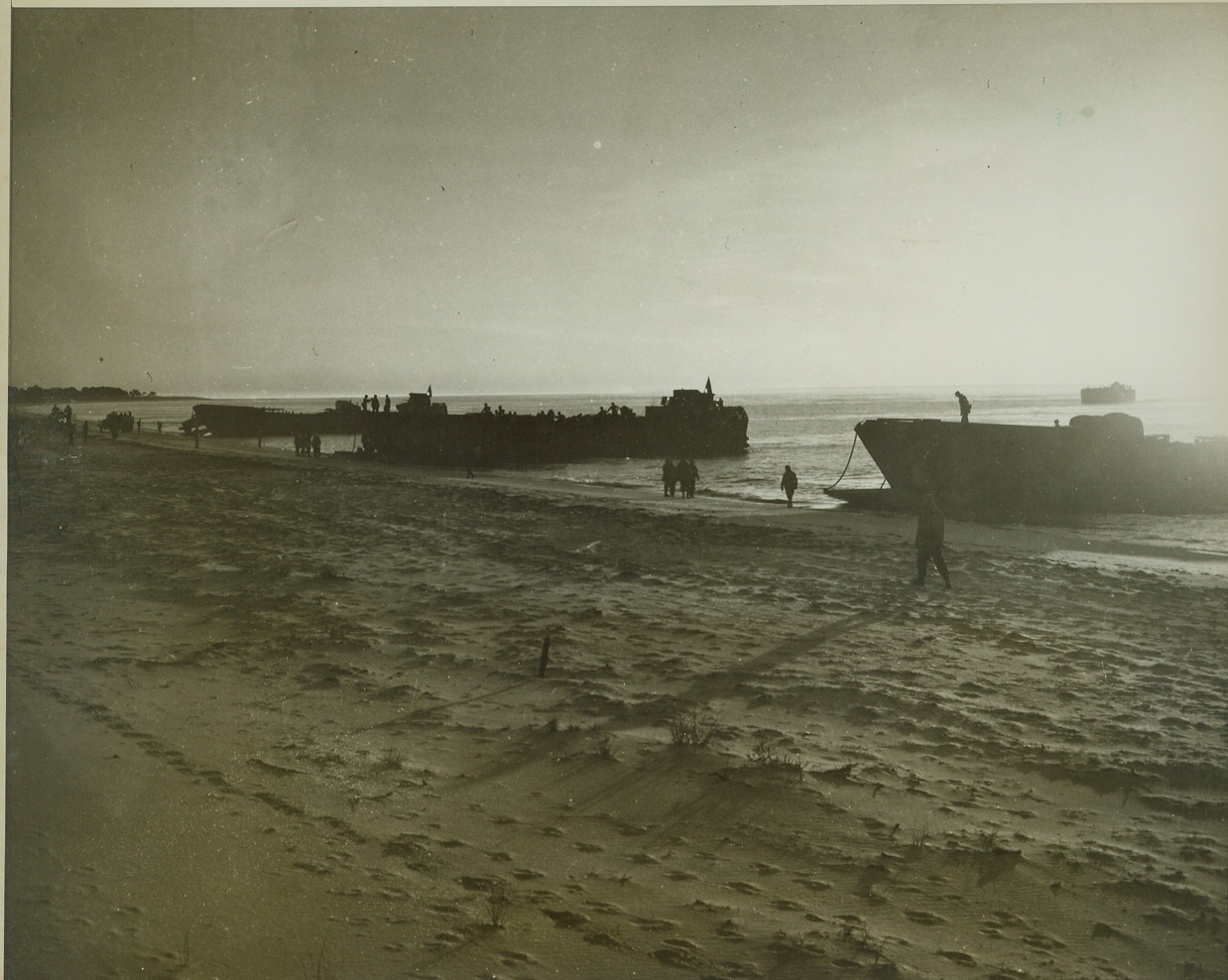
Amphibian Engineers Come Ashore (4), 12/20/1942. Camp Carrabelle, Fla.—Landing craft of the Amphibian Engineer Command are shown beached on the Gulf of Mexico shore at sunrise during landing maneuvers. Credit: ACME.;
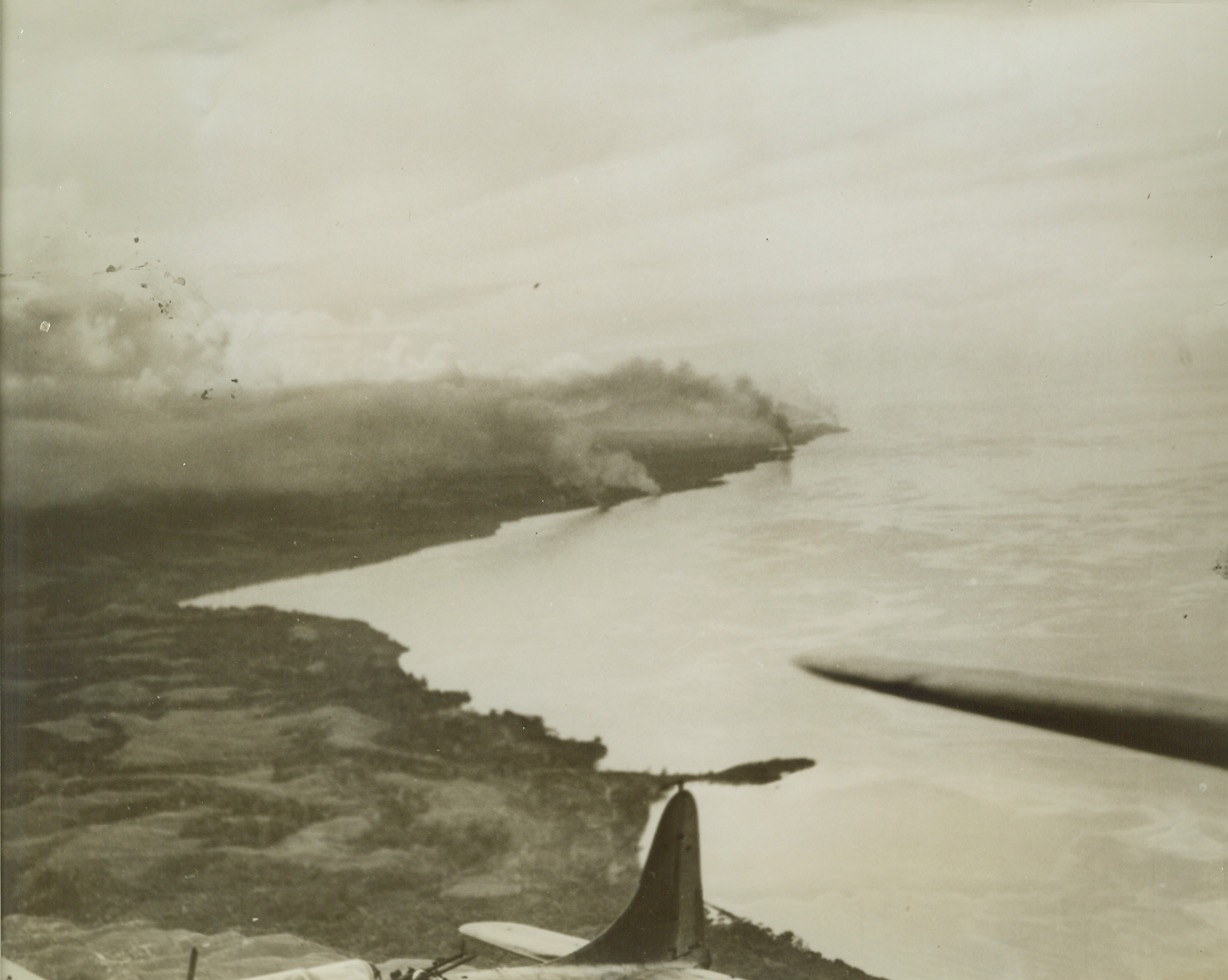
After Japs Lost the Battle, 12/21/1942. Guadalcanal – Four plumes of smoke mark the end of as many Japanese cargo vessels, which were beached during the battle of Guadalcanal at Tassafaronga, about 7 ½ miles West of U.S. positions on Guadalcanal. They were found by U.S. forces on Nov 15th last, and were destroyed by aerial bombs, artillery and naval gun fire. In addition, the enemy lost 11 warships, including one battleship, and eight transports and suffered damage to seven other warships. American losses in the battle were two light cruisers and six destoyers.Credit Line (U.S. Navy photo from ACME);
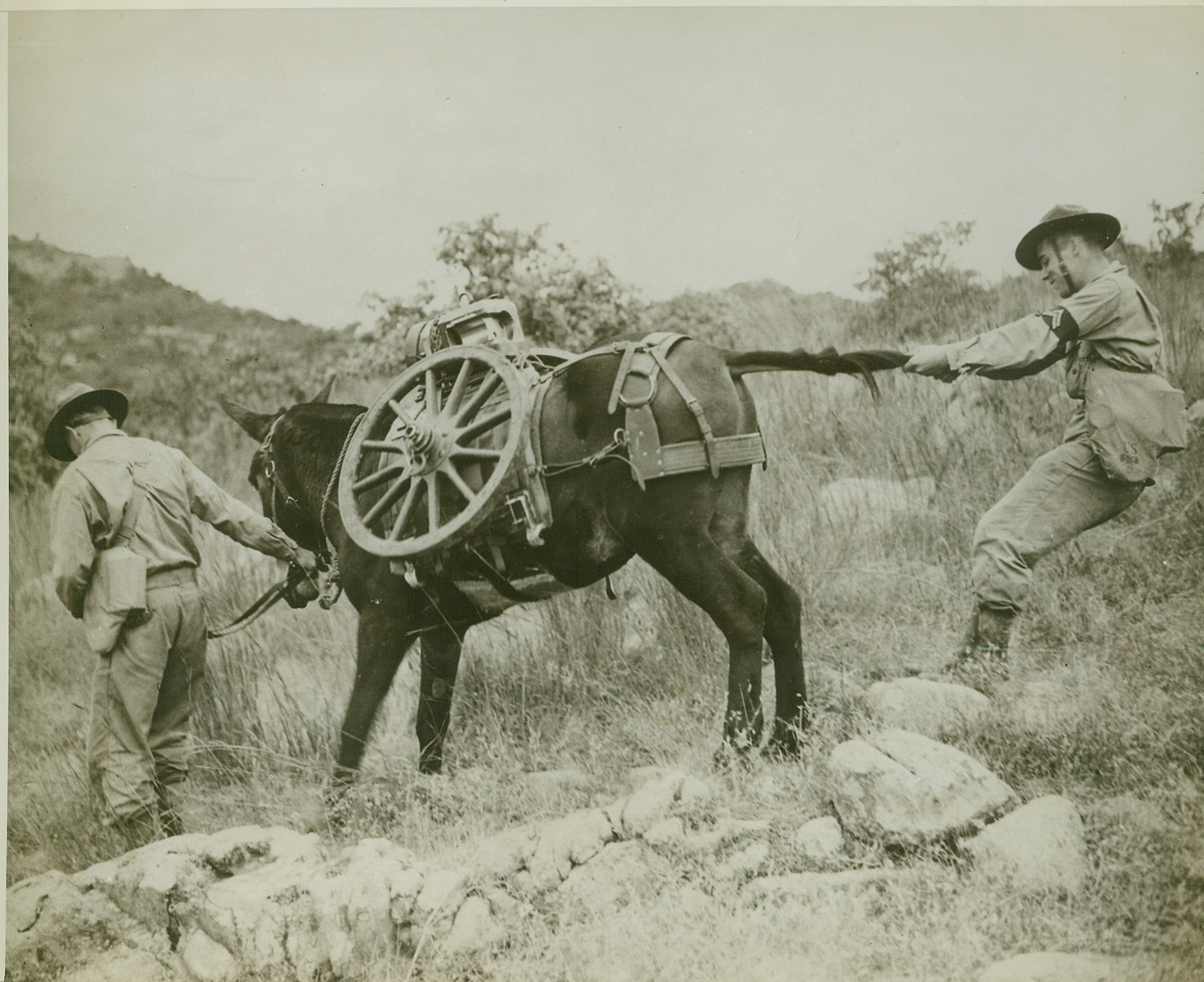
GO LONG MULE, 12/23/1942. FORT SILL, OKLAHOMA—Even in this man’s modernized Army, the famous Army mule is still turning soldier’s hair gray with its stubbornness. But so far, no substitute has been found that can surpass the mule for hauling equipment over mountain trails. Here, two artillerymen try to coax an army mule into movement. Credit: US Army photo via OWI Radiophoto from ACME;
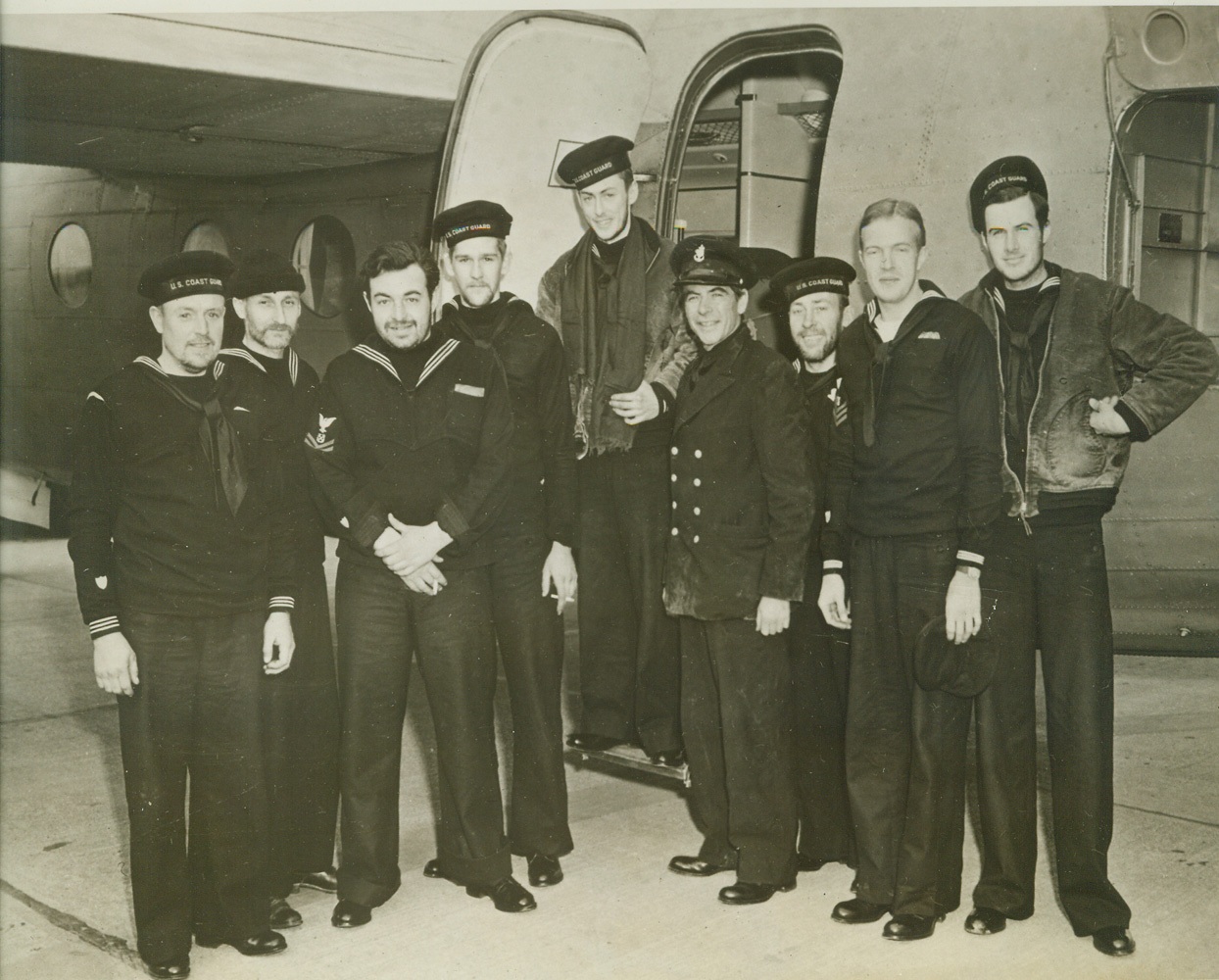
STOOD OFF DAVY JONES FOR THREE LONG WEEKS, 12/24/1942. NEW YORK CITY, NEW YORK – They are nine battered members of the Coast Guard Reserve. They were battered about the Atlantic in their fifty-eight-foot yawl, a slim craft built for racing, for twenty-one days. They were swept helplessly before winds of hurricane force that carried them 3,100 miles from a point more than 100 miles off a Canadian port to Cape Hattoras, N.C. They were rescued today thanks to the vigilance of officers and men of the Eastern Sea Frontier. They are shown above on their arrival at the U.S. Naval Air Station (Floyd Bennett Field). They were flown from Ocracoke Inlet, N.C. – where they were brought after their rescue – to Elizabeth City in a Coast Guard plane. At Elizabeth City they were transferred to a Naval transport plane which, after a stop at Norfolk, brought them here. Left to right they are: Arnold Windsor, Greenport, L.I., N.Y.; James T. Watson, of Greenport, L.I., N.Y.; Vance M. Smith, of Swampscott, Mass.’ Toivo Koskinen, of Bridgeport, Conn.; Ward Weimar, Greenwich, Conn.’ Curtis Arnall, of Greenport, L.I., N.Y. the skipper of the craft; Theodore C. Carlson, North Baltimore, L.I., N.Y.; Joseph E. Choate, Brooklyn, N.Y., and Edward R. Jobson, Larchmont, N.Y. They’ll be home for Christmas. Credit: ACME;

SUB BUILT ON GREAT LAKES NOW ON WAY TO THE SEA, 12/26/1942. CHICAGO; The U.S.S. Peto, the first U.S. Navy submarine ever built on the Great Lakes, is placed in a drydock at Lockport, IL for the trip to New Orleans, LA and the sea, over shallow lower reaches of the Illinois and Mississippi Rivers. The sub is being towed from Chicago through the inland waterways after tests and trial run from Manitowoc, Wis. Shipyards, where it was built. Credit: OWI Radiophoto from ACME;
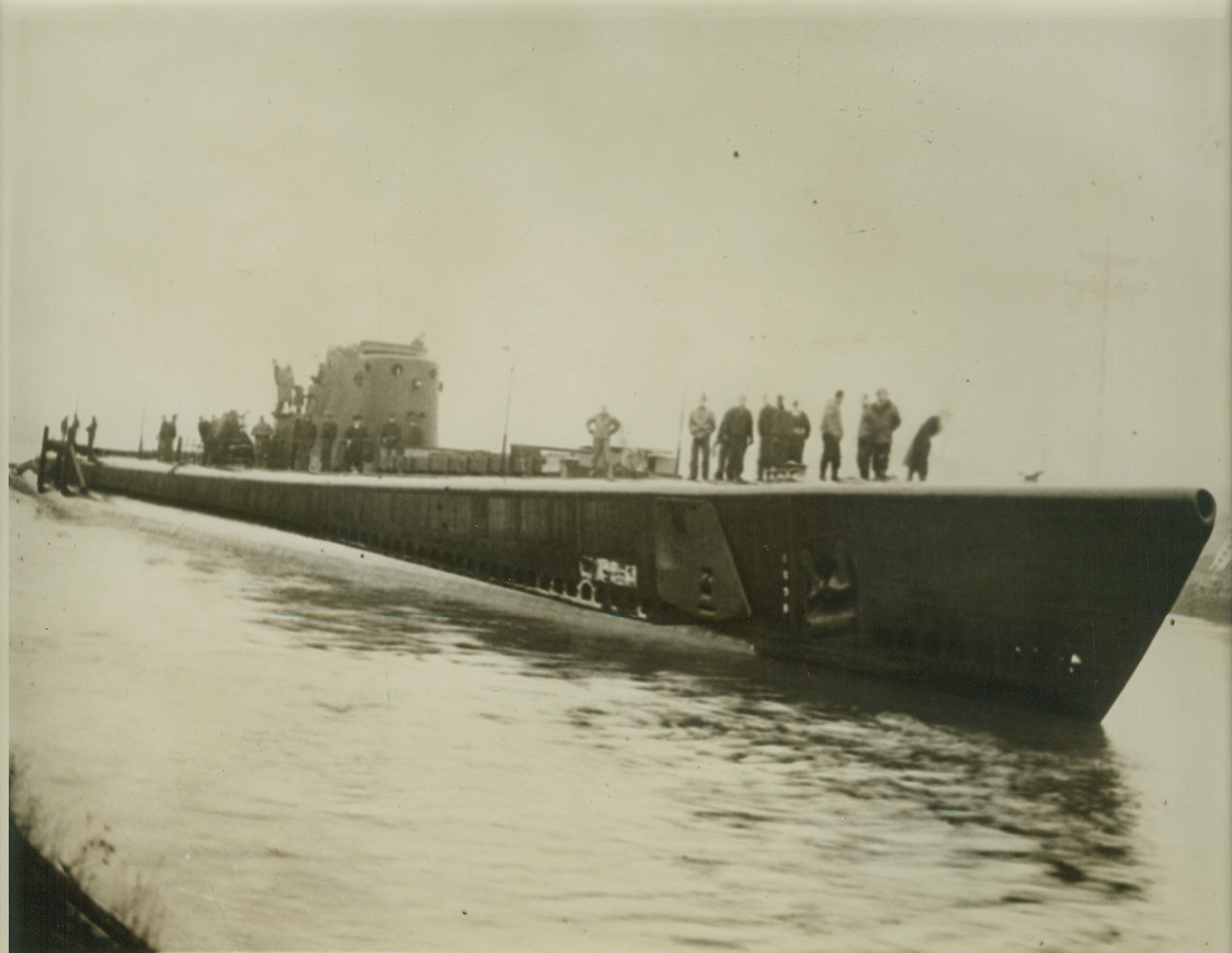
MID-WEST BUILT SUBMARINE ON WAY TO THE SEA, 12/26/1942. CHICAGO; The U.S.S. Peto, first U.S. Navy submarine built on the Great Lakes, arrives at Lockport, IL after a trip down Lake Michigan and through The Chicago Drainage Canal and Illinois Waterway, from the shipyards at Manitowoc, Wis. The sub was placed in drydock to be towed the balance of the trip through the Illinois and Mississippi Rivers to New Orleans, LA where is will receive its final fitting. Credit: ACME;
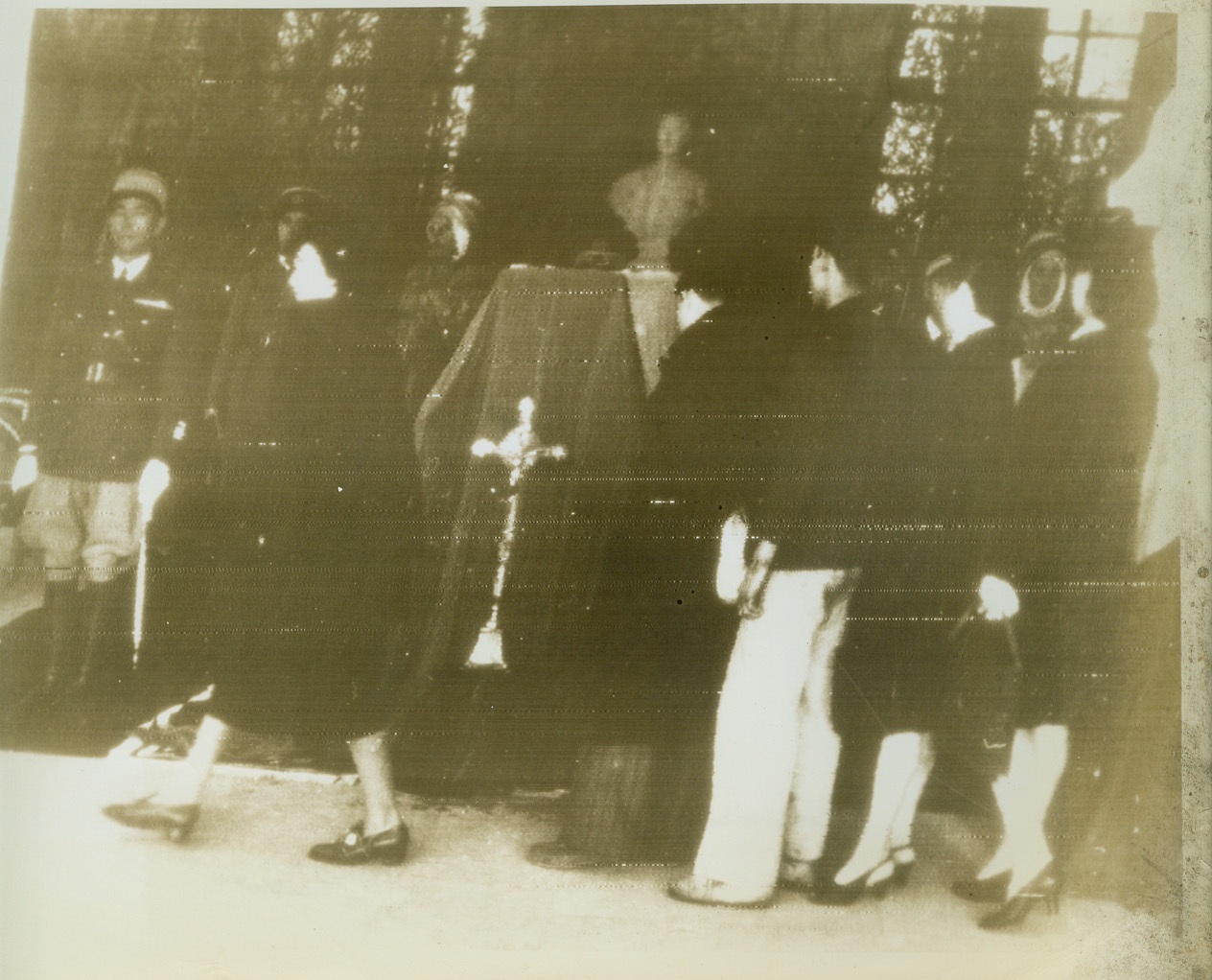
LAST RESPECTS TO SLAIN DARLAN, 12/28/1942. ALGIERS – Civilians file past the body of Admiral Jean Francois Darlan as it lies in state in a government building in Algiers. Reportedly, the assassination of the Chief of French North Africa has left little or no confusion among his followers who eagerly lined up with General Henri Giraud. (Photo radioed to N.Y. today) Credit: OWI Radiophoto from ACME;
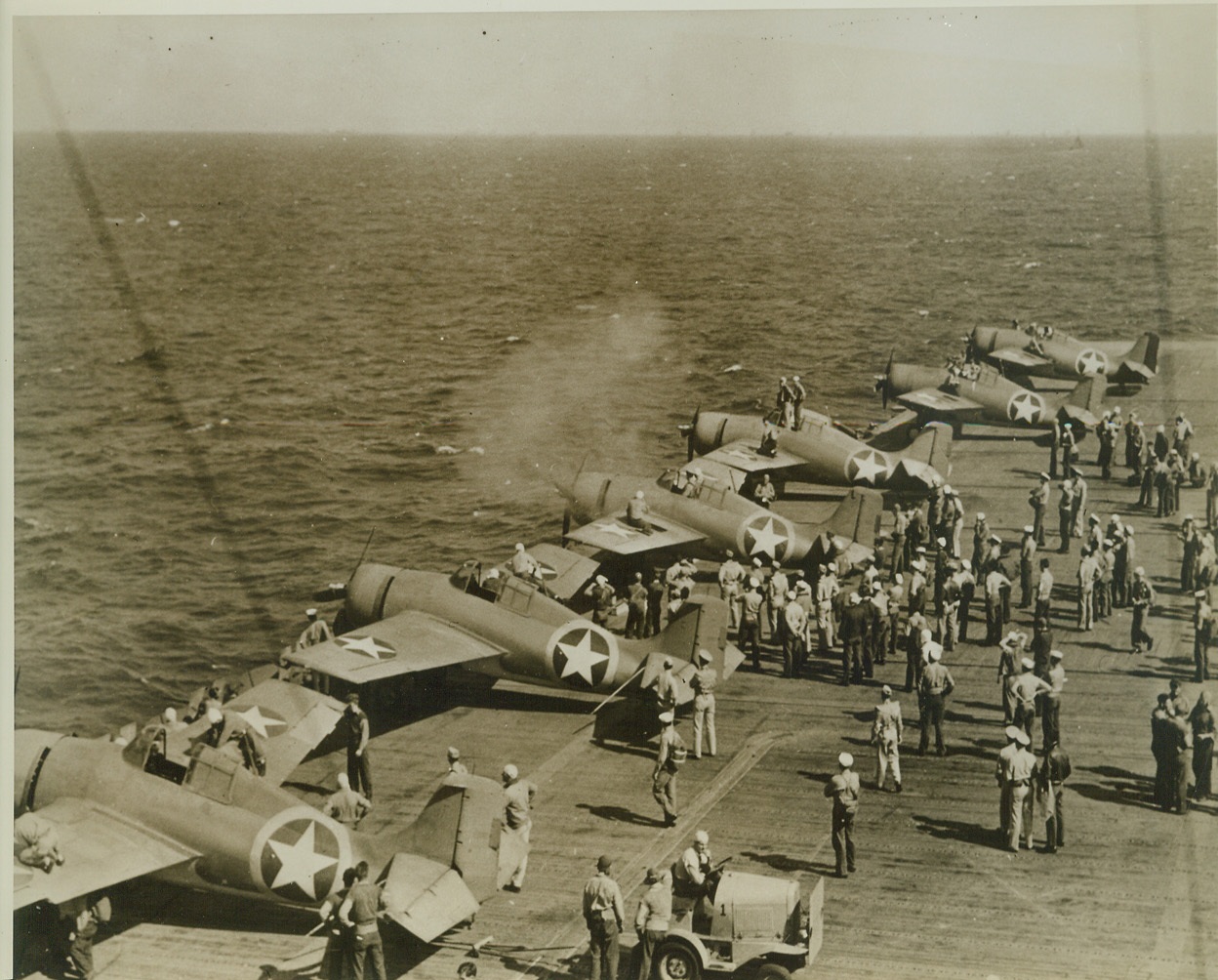
Getting Ready for North Africa, 12/29/1942. Six U.S. Navy fighter planes line up along the edge of the flight deck of an aircraft carrier to test their machine guns, as the warship nears the shore of North Africa. Smoke around nose of third fighter from left, shows its guns are in action. This photo has just been released in Washington. Credit: (U.S. Navy Photo from ACME);
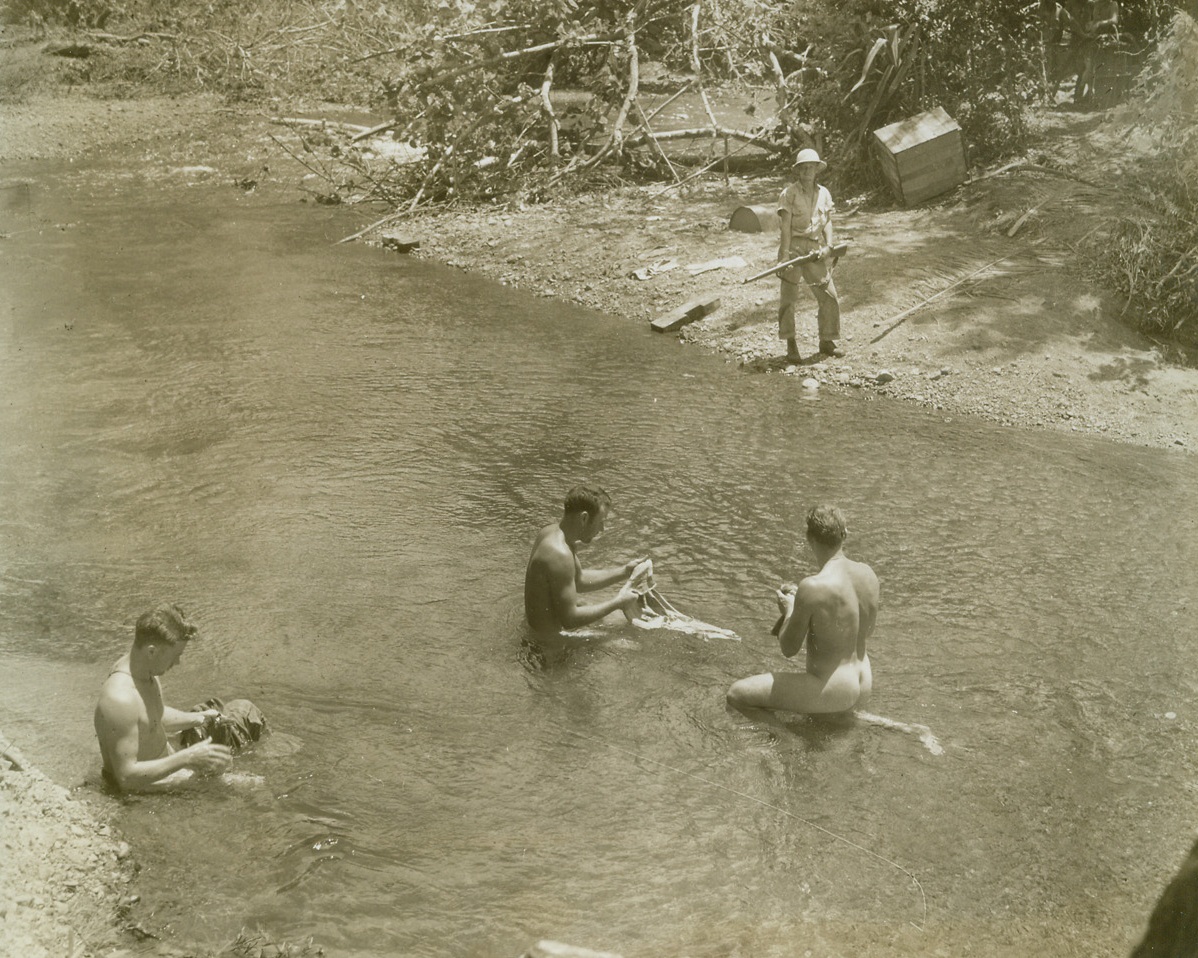
Bath Tub, Wash Tub, 12/30/1942. SOMEWHERE IN NEW GUINEA—American soldiers press this body of water into double service—as a bath tub and a washtub. They launder their clothes and themselves as a watchful guard stands on shore to spot any unwanted visitors. Latest reports from New Guinea indicate that two expanding Allied wedges are threatening to isolate Jap forces on Buna beachhead.Passed By CensorCredit: ACME;
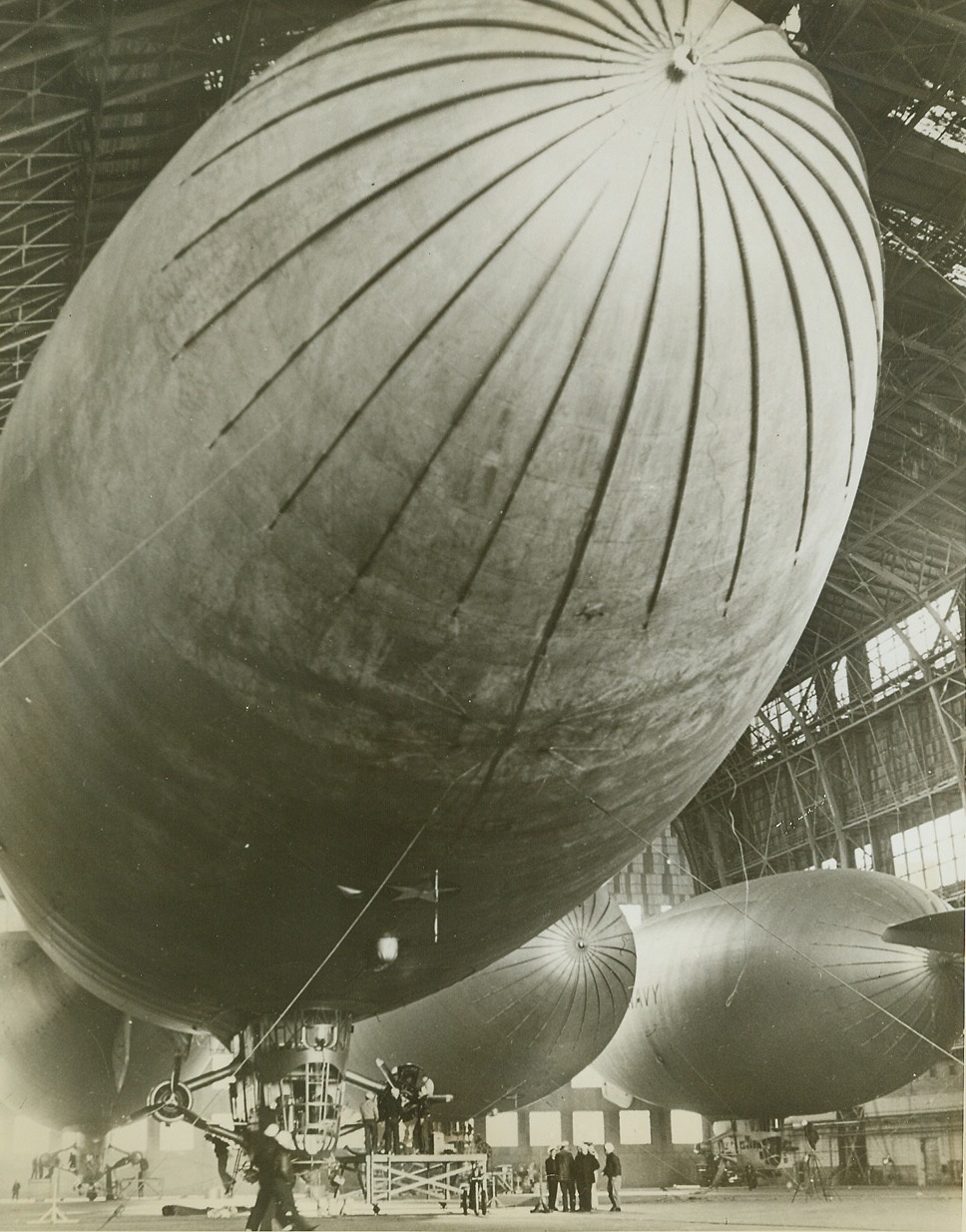
They Annoy Subs, Too, 12/30/1942. LAKEHURST, N.J. -- Nestled in their huge hangar for servicing by ground crews are four of the U.S. Navy's "K" type lighter-than-air ships. This type blimp is used for squadron duty and has played a prominent role in anti-submarine warfare off the Atlantic coast. Credit (Official Navy Photo - ACME);
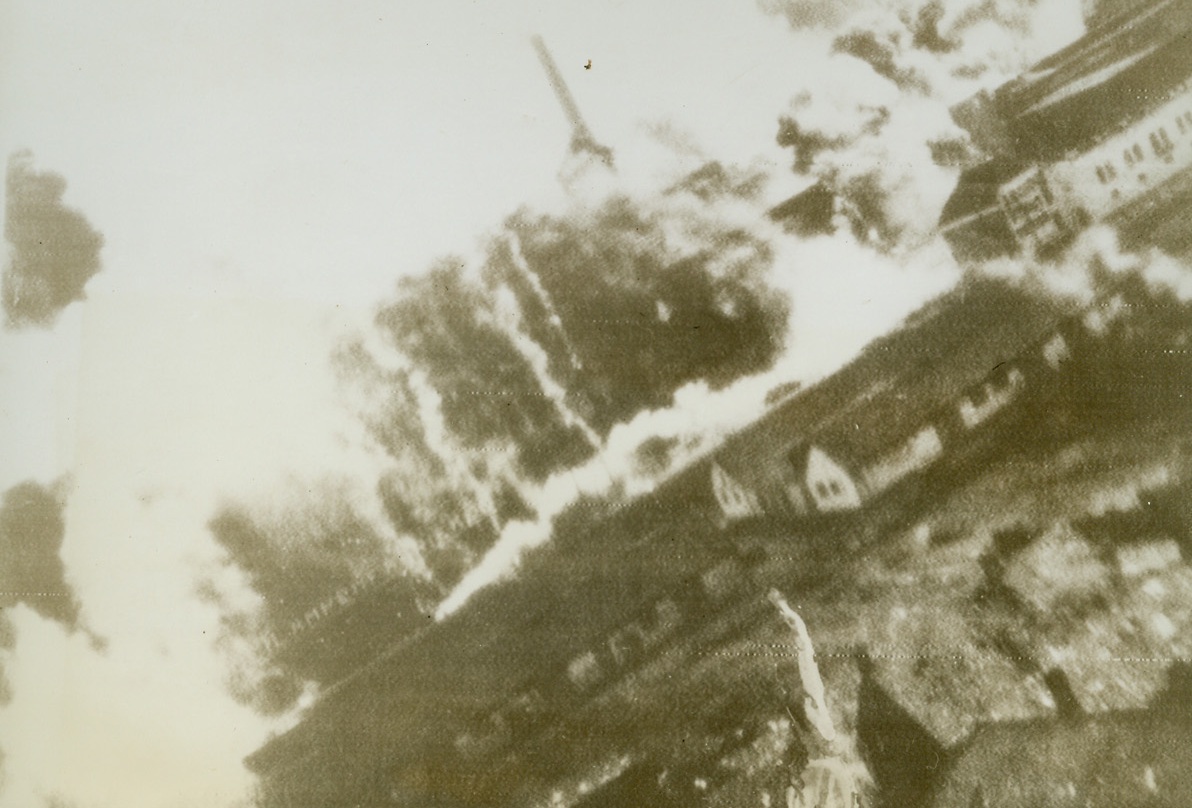
RADIO PLANT IN HOLLAND HIT IN RAID, 12/7/1942. This photo, received in New York by radio from London, was taken from one of the Allied bombers which blasted this Philips Radio Tube factory at Eindhoven, Holland, in the monster Allied daylight offensive over Western Europe, Dec. 6th. Here, dense smoke clouds arise from fires already started, while smaller pillars mark the spots where loads of incendiaries have fallen. Credit: Acme Radiophoto;
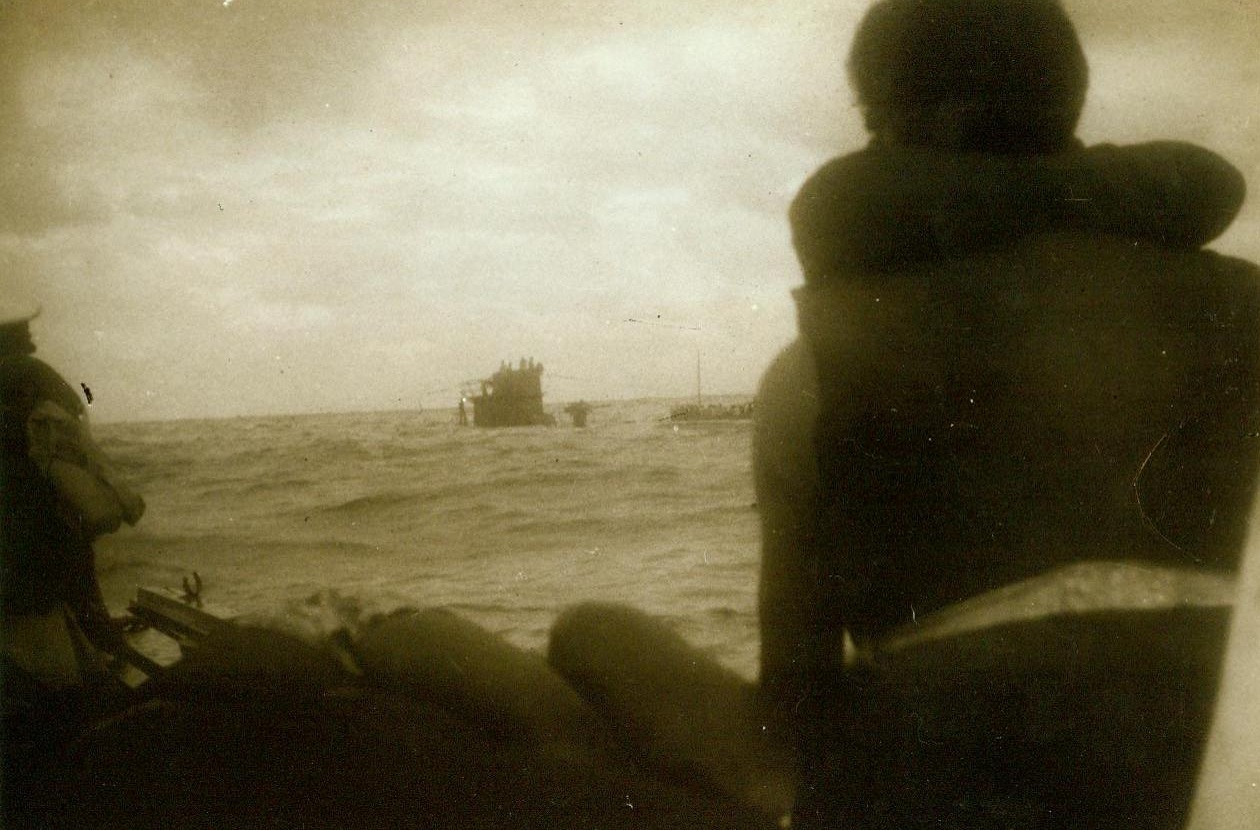
Torpedoed Ship’s Skipper Taken Prisoner, 12/29/1942. At Sea: -- A crew member of an Allied merchantman torpedoed by a German U-boat somewhere in the South Atlantic snapped this picture from the liferaft in the foreground. From the lifeboat in background, the Captain and Engineer of the sunken ship were taken prisoners by the U-boat commander and brought aboard the submarine. Which can be seen to left of Lifeboat. 12/29/42 Credit Line (ACME);
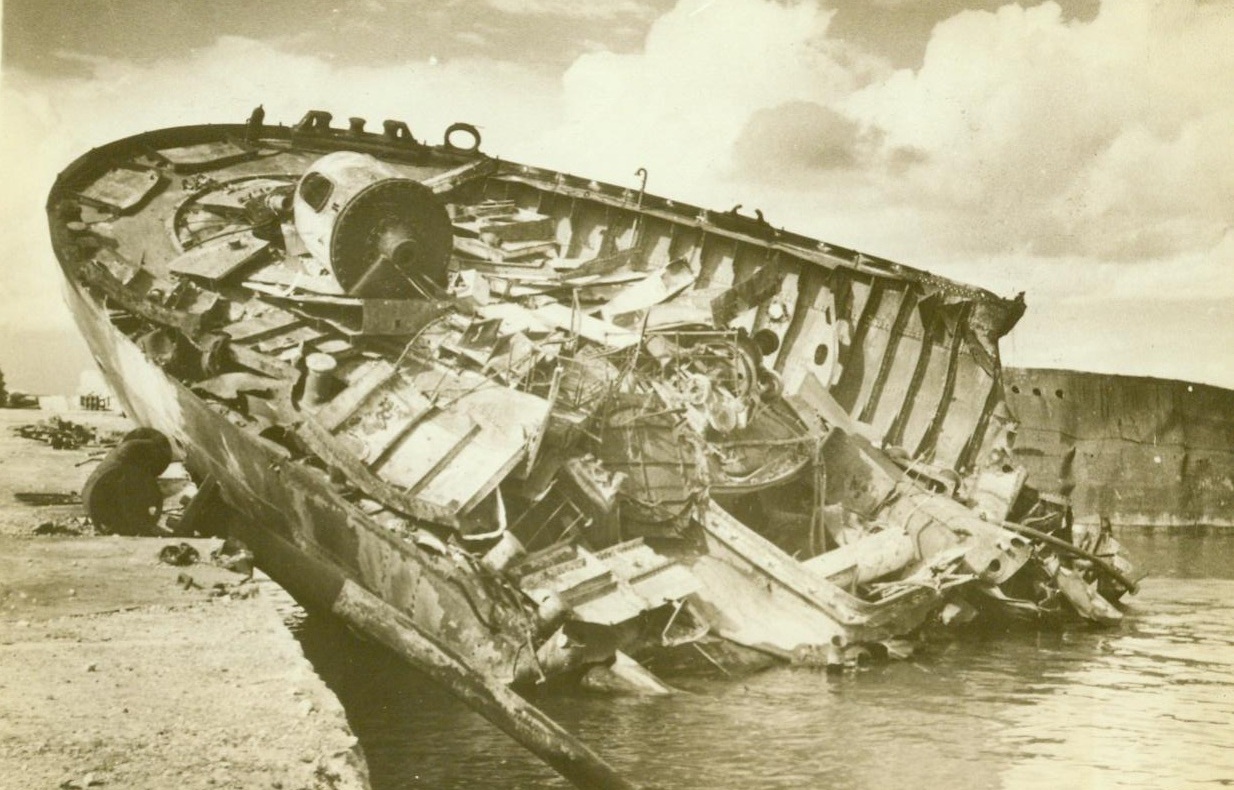
Beached With A Bounce, 12/27/1942. Benghasi – This Axis ship was actually blown clear out of the water of Benghasi Harbor, and now rests half on the pier while other enemy ships litter the bay. The British, who took over the Libyan port last month, are reported to have contacted units of Rommel’s depleted Army. 12/27/42 Credit Line (ACME);
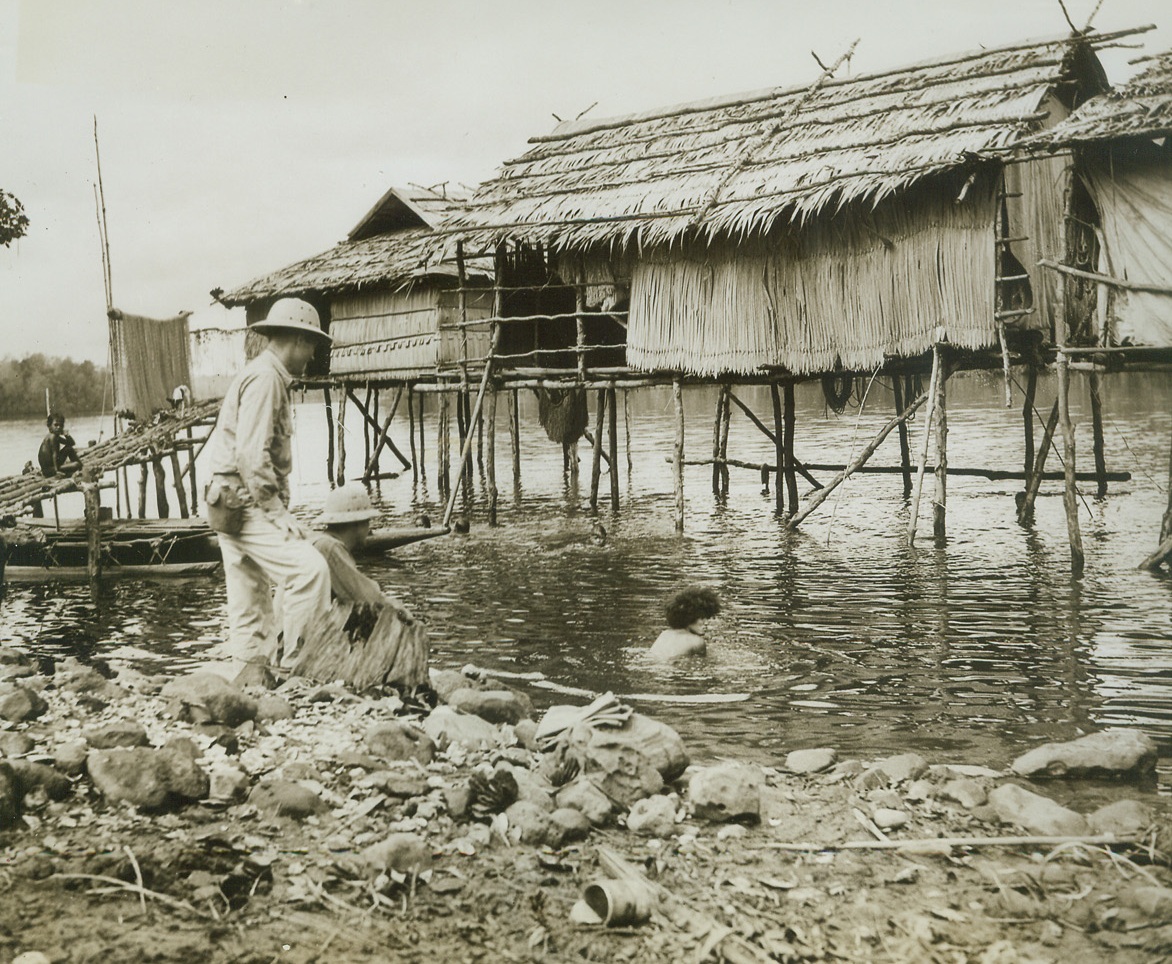
A Day Off in New Guinea, 12/29/1942. New Guinea: - It’s not all blood and sweat and toil for the American soldiers in New Guinea. Occasionally they get a day off, and then they go sight-seeing. Sgt. Albert Bretz, of Wadena, Minn. (left) and Sgt. John Lamping of St. Louis, Mo., wandered down to shore and found a native family swimming in their front yard - so to speak. Credit Line (ACME);
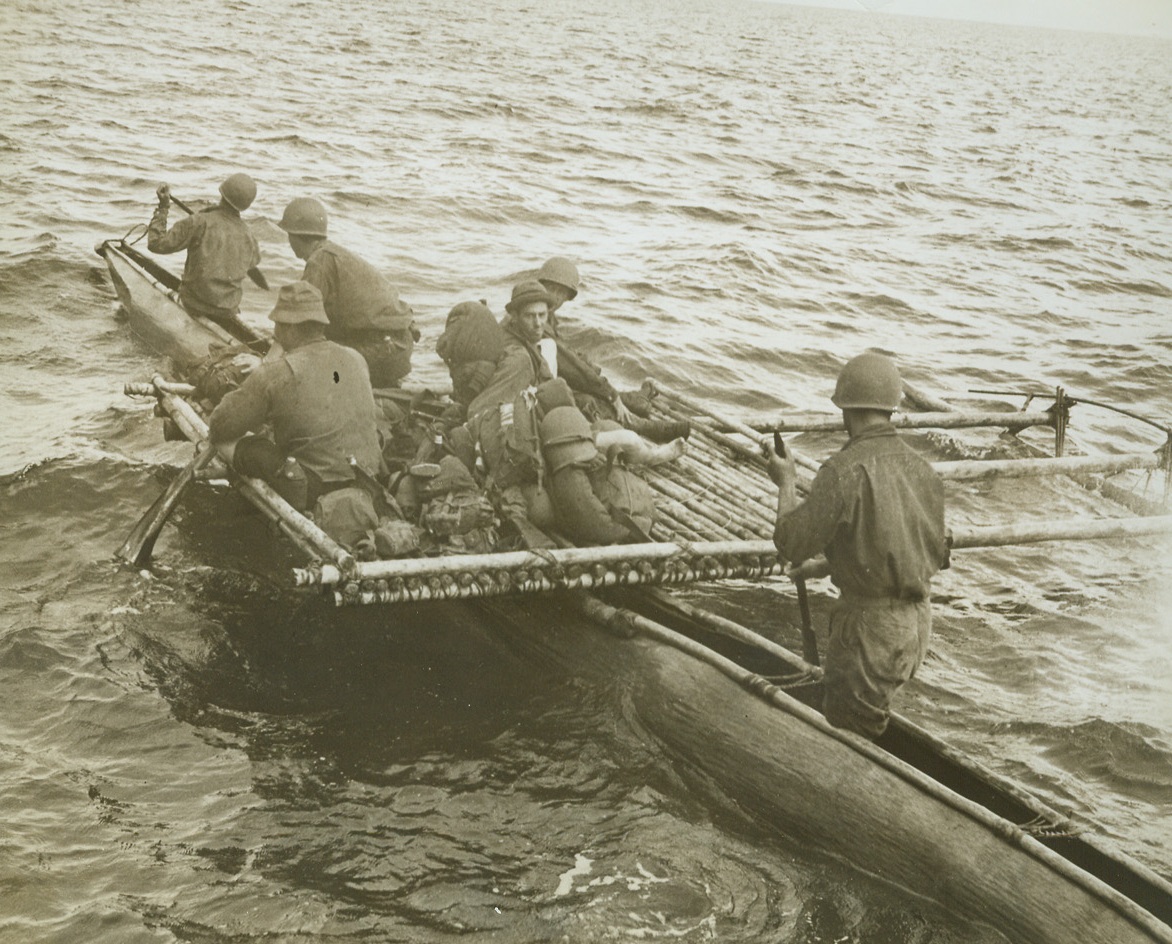
IMAGINATION ESSENTIAL, 12/8/1942. NEW GUINEA—American Troops go canoeing native style as they head into midstream to board small boats that will take them down an un-named river to the forward position of a native village. The boats they are about to board each hold 100 men and moved many fighting units toward the beleaguered Jap troops.Credit: ACME.;

DEFY DEATH, 12/23/1942. Members of the U.S. carrier’s deck crew—some keeping their eyes on Jap planes overhead—run to the assistance of Navy plane which suffered an accident in landing during a battle in Pacific. Photo from a Navy film.Credit: OFFICIAL NAVY PHOTO-ACME.;
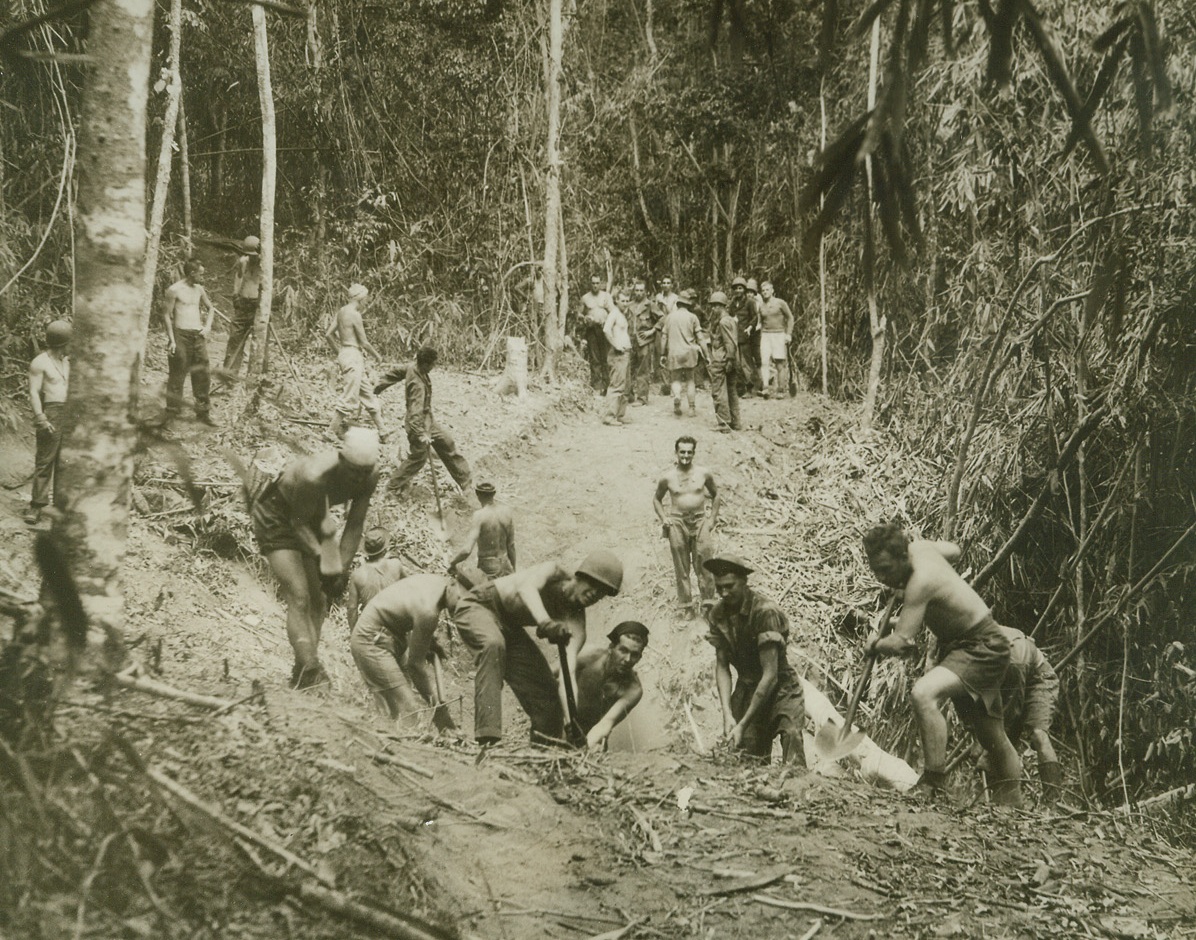
BUILDING A JEEP ROAD IN NEW GUINEA, 12/15/1942. NEW GUINEA—American and Australian soldiers tackle a hill in New Guinea jungle constructing a jeep road, which will allow the Allies to bring supplies up as they move against the Japs in the Buna-Gona area. According to reports today, both Buna and Gona villages are in Allied hands with heavy action continuing at Buna Mission and the Japs attempting new landings in force in the Cape Ward section. This photo was released in Washington today.Credit: ACME;

PRESIDENT COOLIDGE SURVIVORS, 12/12/1942. Some of them wet and covered with oil, but otherwise none the worse for their experience, survivors of the S.S. President Coolidge, United States troop transport (seen left, listing in the background) shove off for shore in a landing boat. Only two out of over 4,000 aboard lost their lives as the ship sank after being hit by a mine off a small South Pacific Island. The loss was announced by the Navy 12/12/42. Credit: U.S. NAVY OFFICIAL PHOTO FROM ACME.;
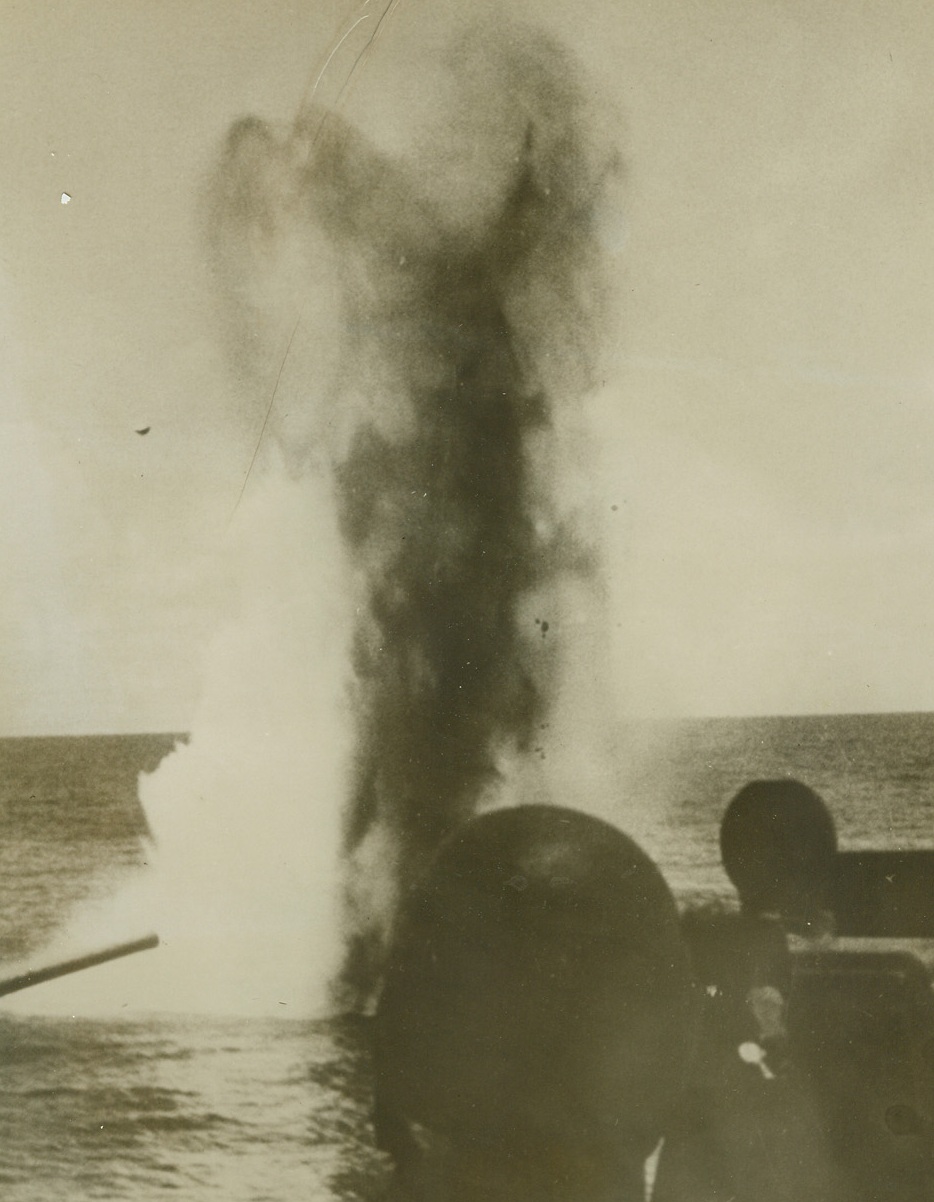
No Title. 12/22/1942. This photo, taken from a newsreel, shows a column of smoke and water rising from an exploding bomb dropped near an American aircraft carrier during recent action in the South Pacific. Not one U.S. ship was more than slightly damaged in the action in which a Japanese bombing fleet was driven off. This picture has just been released in New York. Credit: U.S. NAVY PHOTO FROM ACME;

MAN-MADE EARTHQUAKE, 12/22/1942. An exploding Jap Aerial bomb which exploded eastern of this U.S. aircraft carrier, (white ring on surface of water, in background makes where explosion occurred), tossed this fighter plane overside into gun emplacement (left in photo), and knocked two crew members down, (center). Photo, which was taken during recent action in the South Pacific, was released in New York today. No American ship, which took part in the battle of which the above action was a part, was more than slightly damaged. Picture was taken from an official newsreel. Credit: U.S. NAVY PHOTO FROM ACME.;
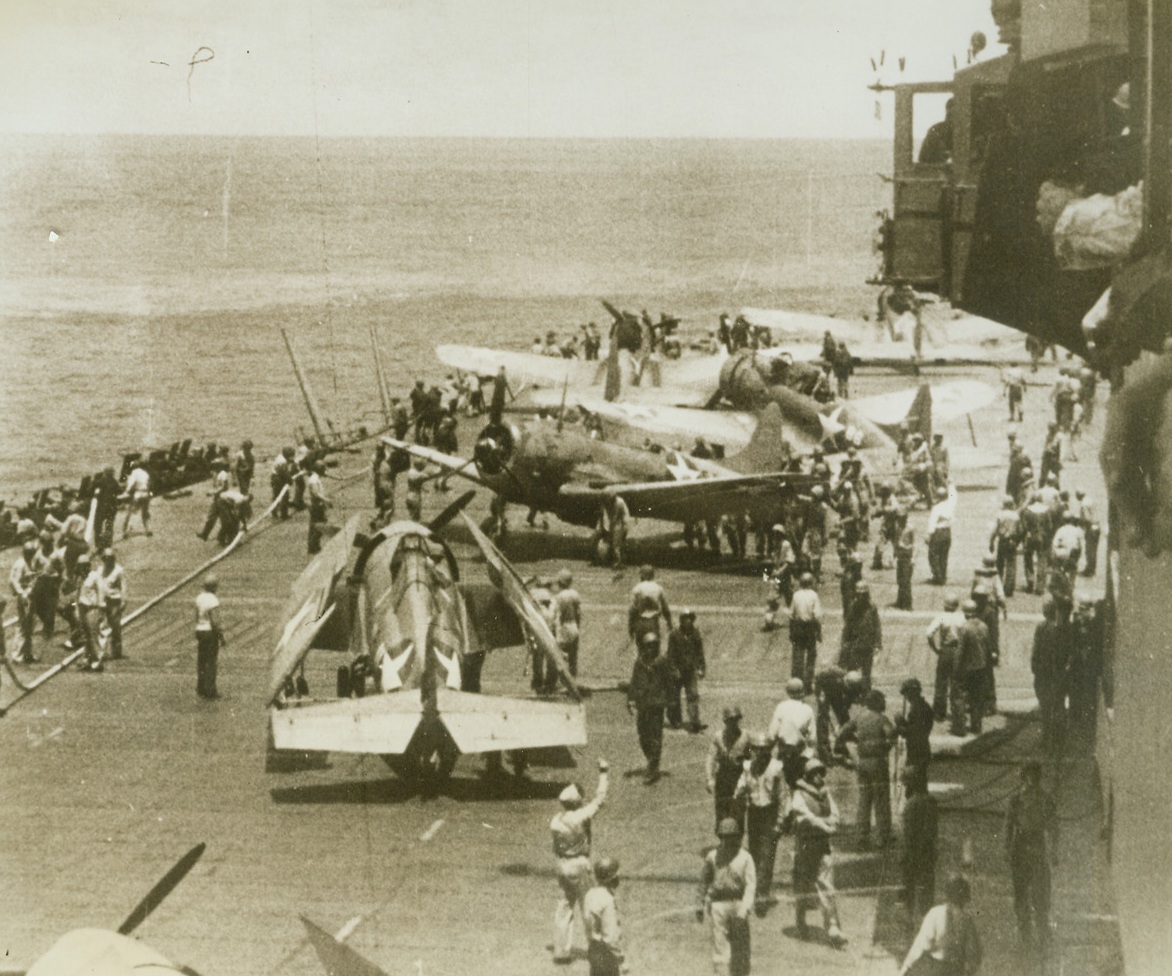
BATTLE’S END, 12/22/1942. After heavy action against a fleet of Jap bombers in a recent action in the South Pacific, American planes return to this U.S. aircraft carrier, are refueled and stowed away. This photo, taken from an official newsreel, has just been released in New York. In the battle, no American vessel was more than slightly damaged. Credit: U.S. NAVY PHOTO FROM ACME.;
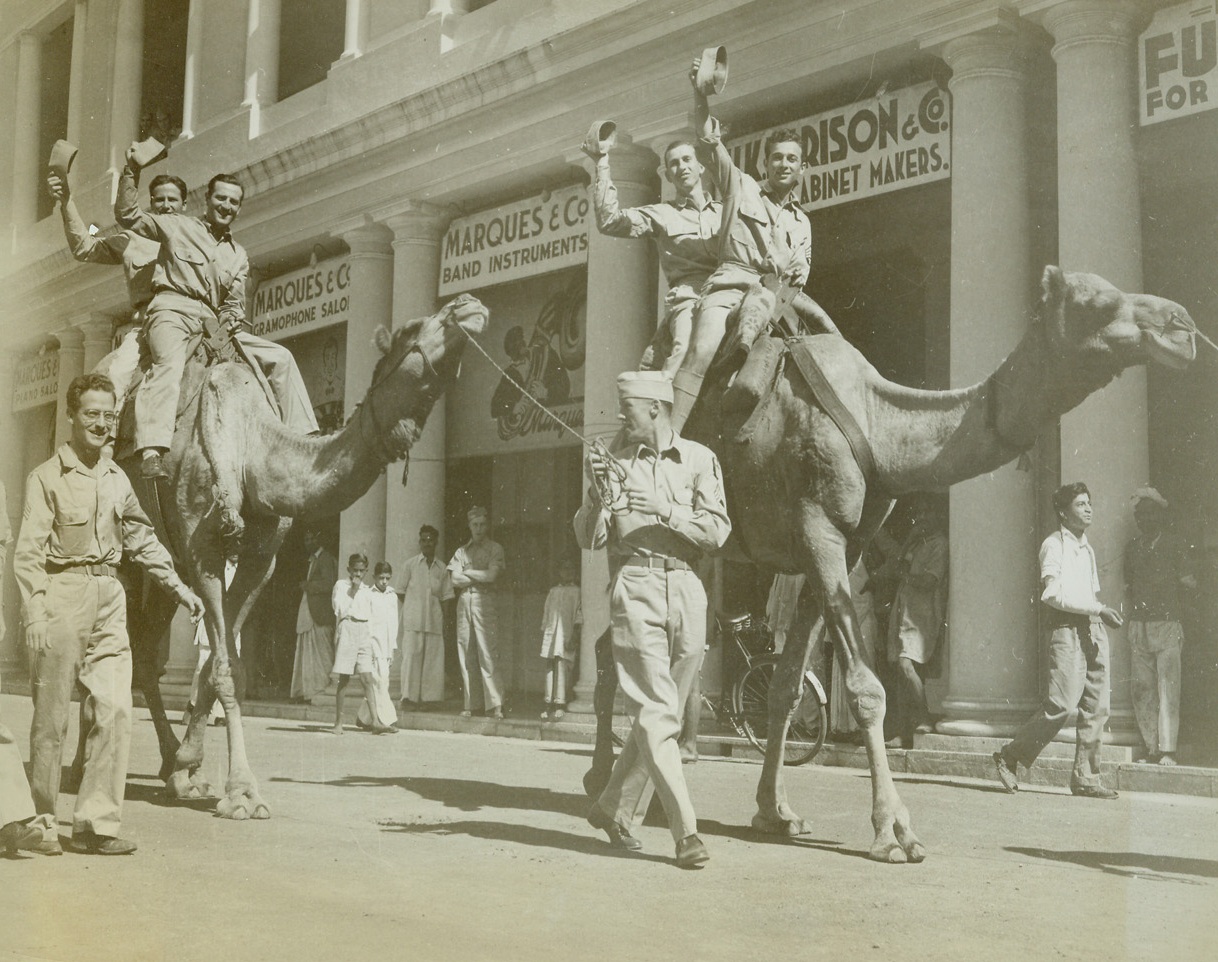
YANKS TACKLE “SHIPS OF THE DESERT”, 12/17/1942. INDIA—American soldiers stationed in India, take time out for a camel ride down the main street of a city, “Somewhere in India,” as natives watch with interest. Credit: ACME.;

NEW GUINEA, TIGHT-ROPE WALK, 12/8/1942. SOMEWHERE IN NEW GUINEA—It’s balance not speed that counts as American infantry cross a small bridge to the edge of a jungle. Building their own bridges, constructing jeep roads out of nearby trees, and pushing through swamps, U.S. Doughboys moved to their present forward position in New Guinea. Credit: ACME.;

MOVING AMMUNITION FOR ATTACK ON JAPS, 12/15/1942. NEW GUINEA—Ammunition for three-inch trench mortars is loaded on the back of a pack carrier for transport to weapons set up in the jungles of New Guinea, as combined Australian and American forces under Gen. Douglas MacArthur advanced against the Japs in the Buna-Gona area. This photo has just been released in Washington. According today’s dispatches, both Buna and Gona are in the hands of the Allies and heavy fighting is continuing at Buna Mission. Japanese have landed in the Cape Ward sector. Credit: ACME.;
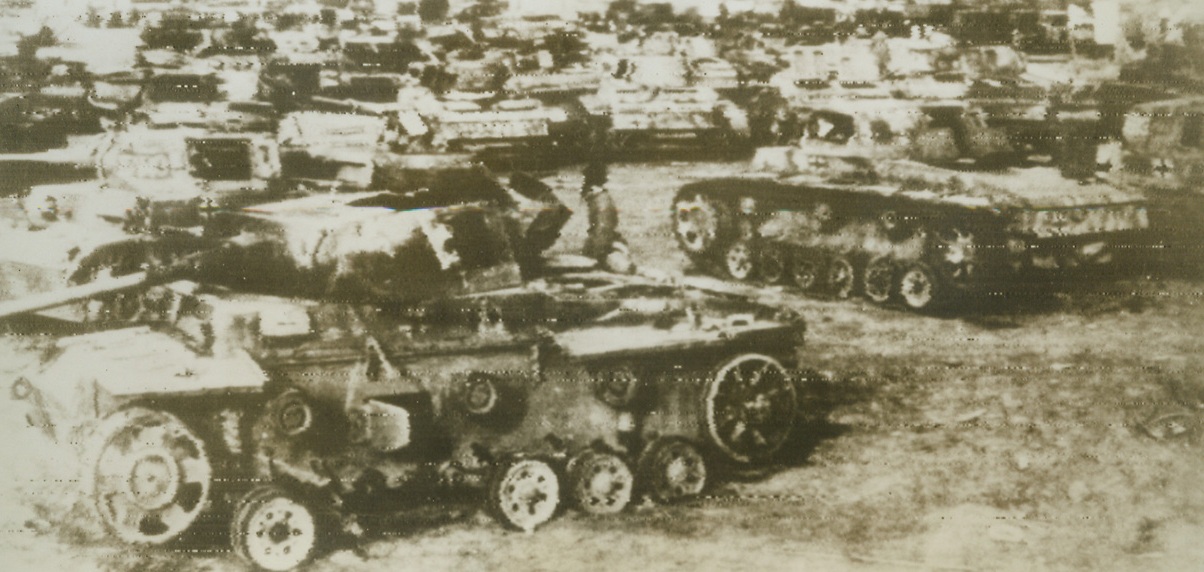
Scrap for the Red Army, 12/21/1942. STALINGRAD—These captured German tanks would make a good scrap collection for anybody’s war machine. They’re in the hands of the Red Army now and are shown massed on an open field near Stalingrad.Credit: ACME;

Living in German Dugouts, 12/2/1942. SOMEWHERE IN RUSSIA—Residents of liberated Russian villages, their homes destroyed, now live in dugouts that once protected Nazi forces. Latest dispatches from Russia indicate that the German High Command is pulling troops out of Stanlingrad and the offensive of the Red Army in that city is rolling along successfully. Passed by censor.Credit: ACME;

Same Old Sport – New Spot, 12/22/1942. Guadalcanal – American soldiers and Marines, along with two native guides, combine the job of washing their clothes with the sport of swimming, in the Lunga river on Guadalcanal island in the Solomons. A huge fallen tree is used both as a washboard and a seat for sun bathing. Credit line (U.S. Marine Corps from ACME);
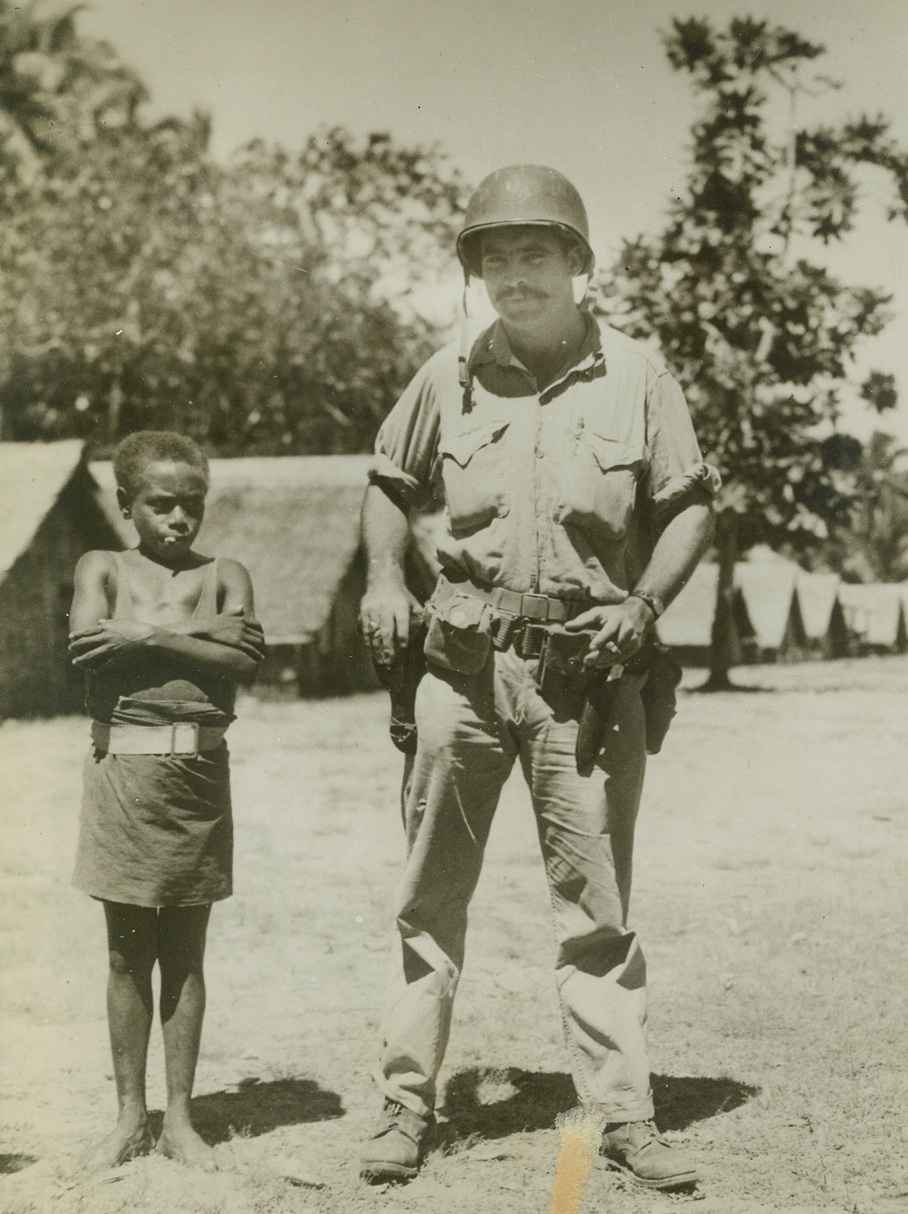
Guadalcanal’s Gunga Din”, 12/23/1942. Guadalcanal – U.S. Marines on Guadalcanal Nicknamed this diminutive native boy, “Gunga din”. He was on a recent patrol action against the Japanese. Credit line (ACME);
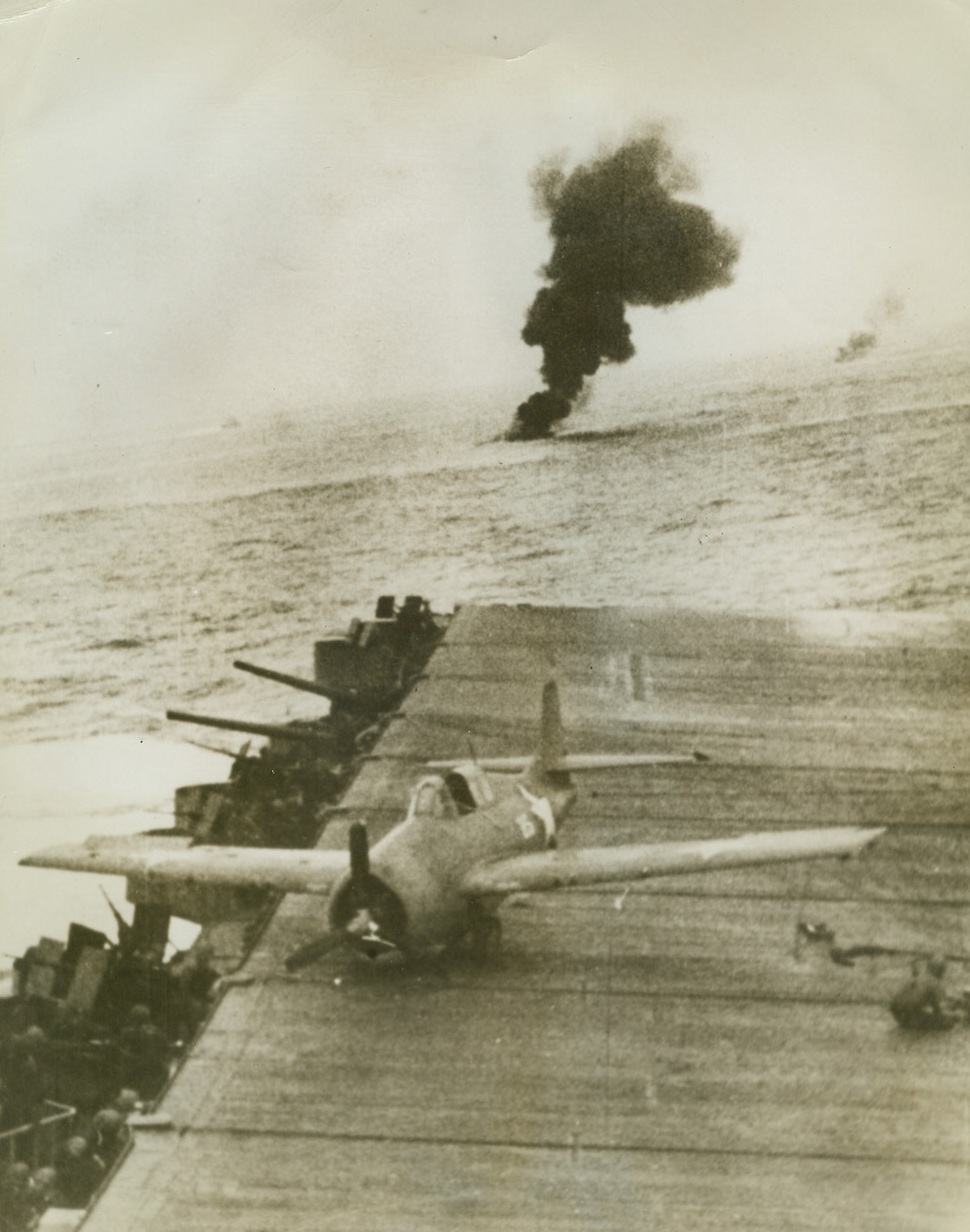
Fighting in the Pacific, 12/23/1942. A U.S. Navy plane came to an abrupt stop on the deck of a zig-zagging aircraft carrier during a battle in the Pacific. A member of the plane’s crew, or the deck crew, crouches at right as the ship dodges Jap planes. Two columns of smoke rise from the ocean, possibly showing where planes have crashed during the fight. Photo from an official Navy film. Credit (Official Navy photo – ACME);
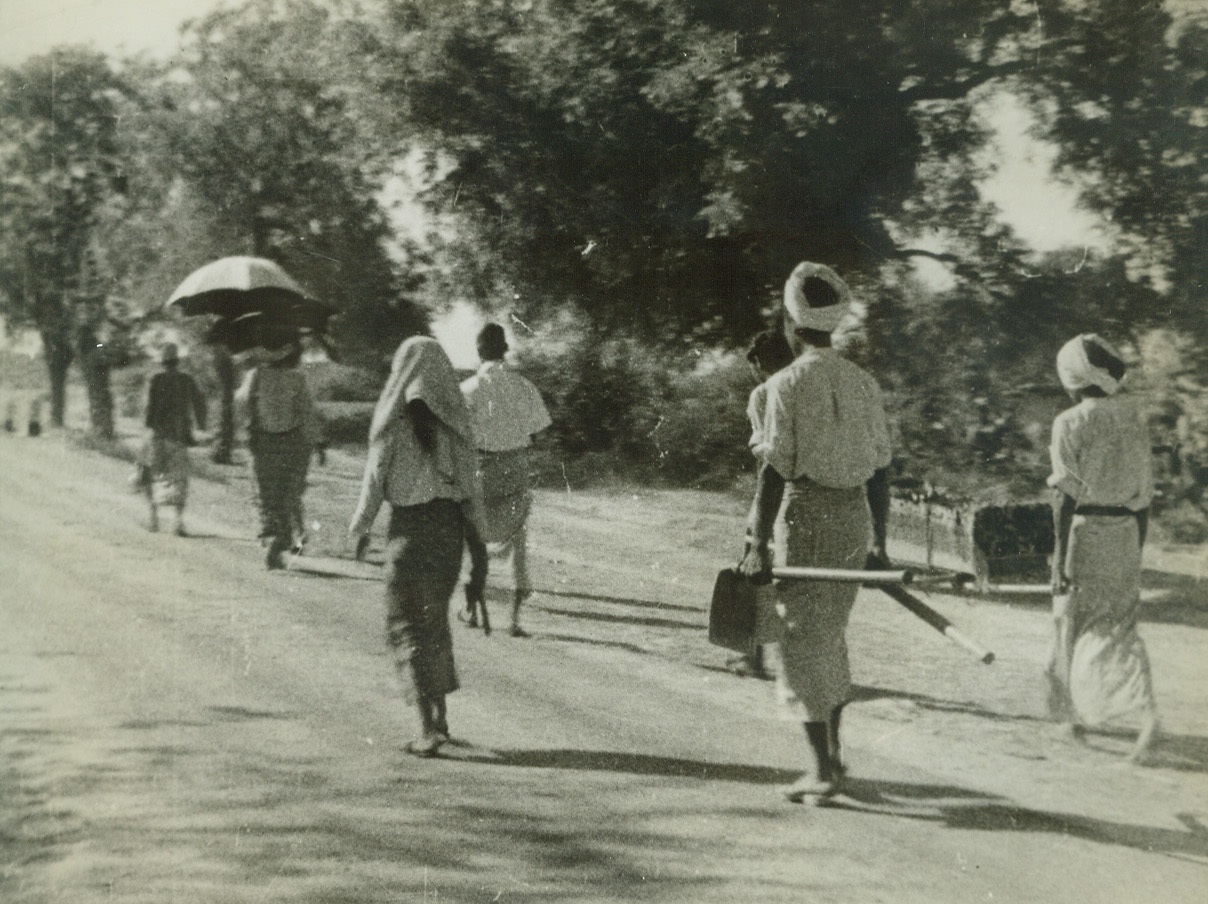
Jap Methods, 12/14/1942. Burma –This tiny draped coffin and digging implements carried by a Burmese family tells the story of a Jap terror raid. The group walks from their bombed village after a blitz from the air which was merely one of those axis affairs calculated to clog roads with panic-stricken refugees. There was no possibly military objective in the little village. Credit line (ACME);
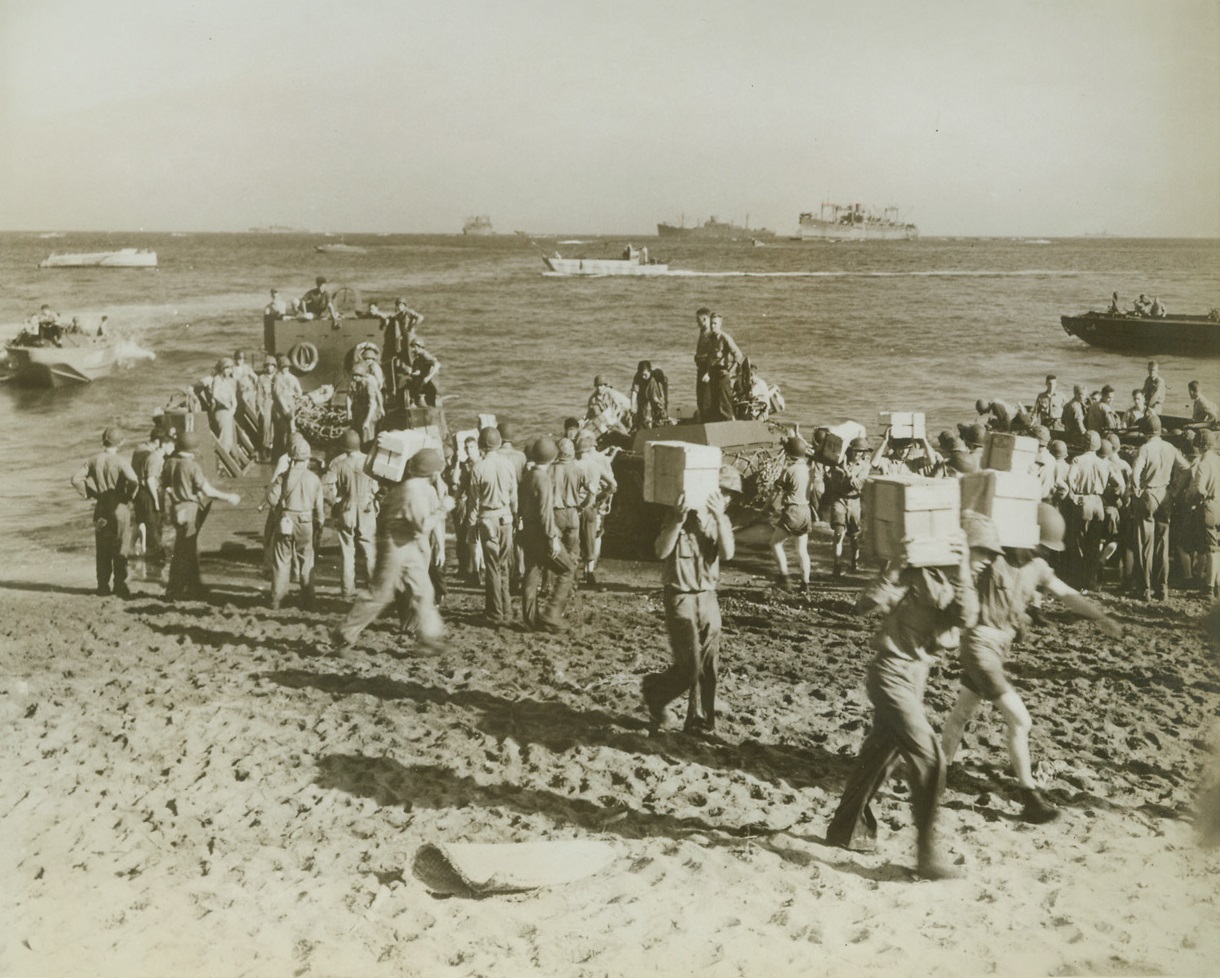
Supplies for Marines on Guadalcanal, 12/29/1942. Guadalcanal – U.S. Marines unload supplies from small boats on the beach at Guadalcanal island. In background, can be seen part of the convoy that brought the supplies to the fighting Leathernecks. Credit line (U.S. Marine Corps photo from ACME);
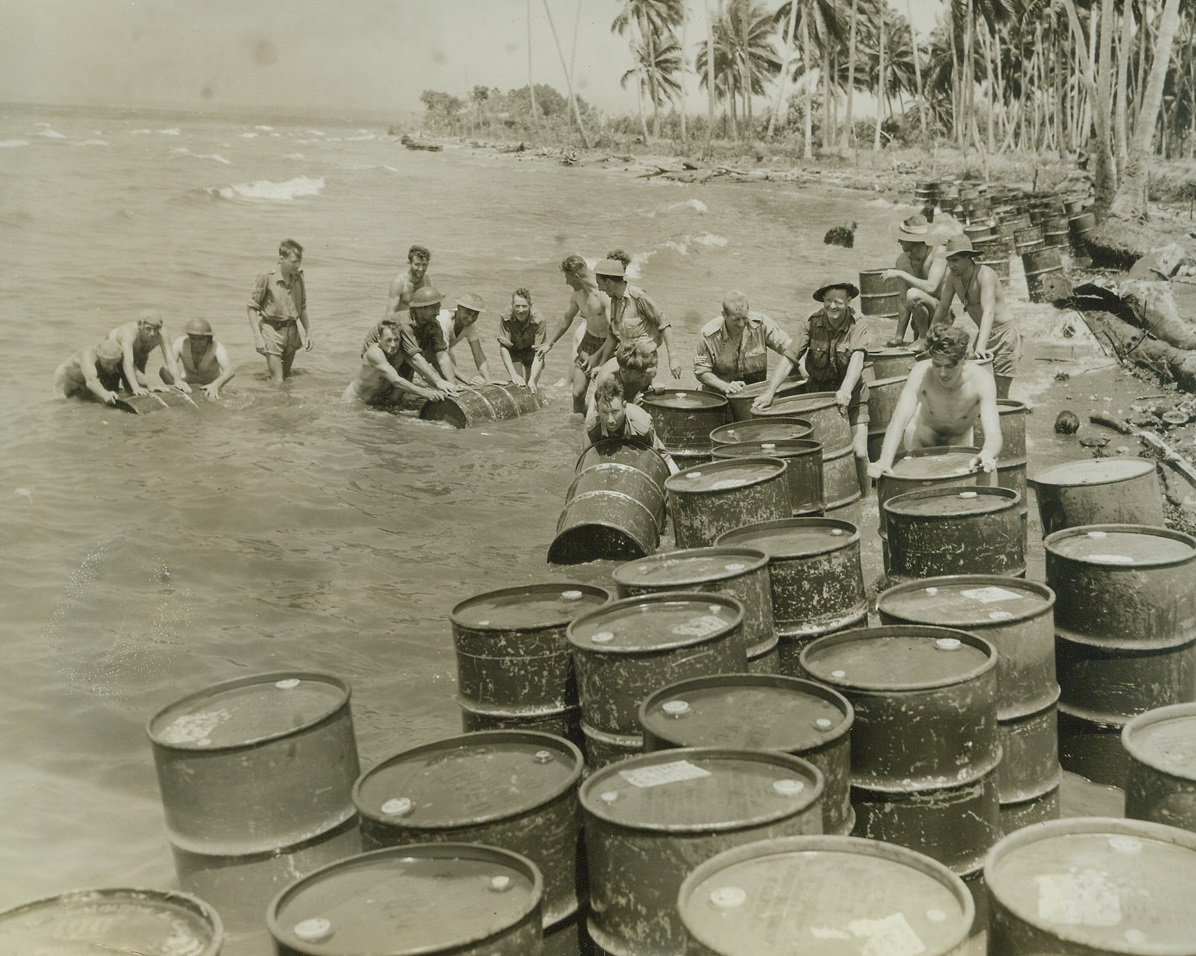
Fuel to Blast the Japs, 12/29/1942. New Guinea: - Australian troops gather gasoline drums which were dropped over the side of a United Nations supply ship to stock an allied base in New Guinea. This is but a token of the supplies needed to blast the Japs out of the island. Credit line (ACME);

Waiting for Orders, 12/21/1942. Guadalcanal – Near this tent deep in a jungle on Guadalcanal island, these operations officers “stand by” for orders. From this point, battle orders are issued to various combat groups on the island. Seated in the foreground is Col. Lawson H.M. Sanderson, USMC Credit line (U.S. Navy photo from ACME);
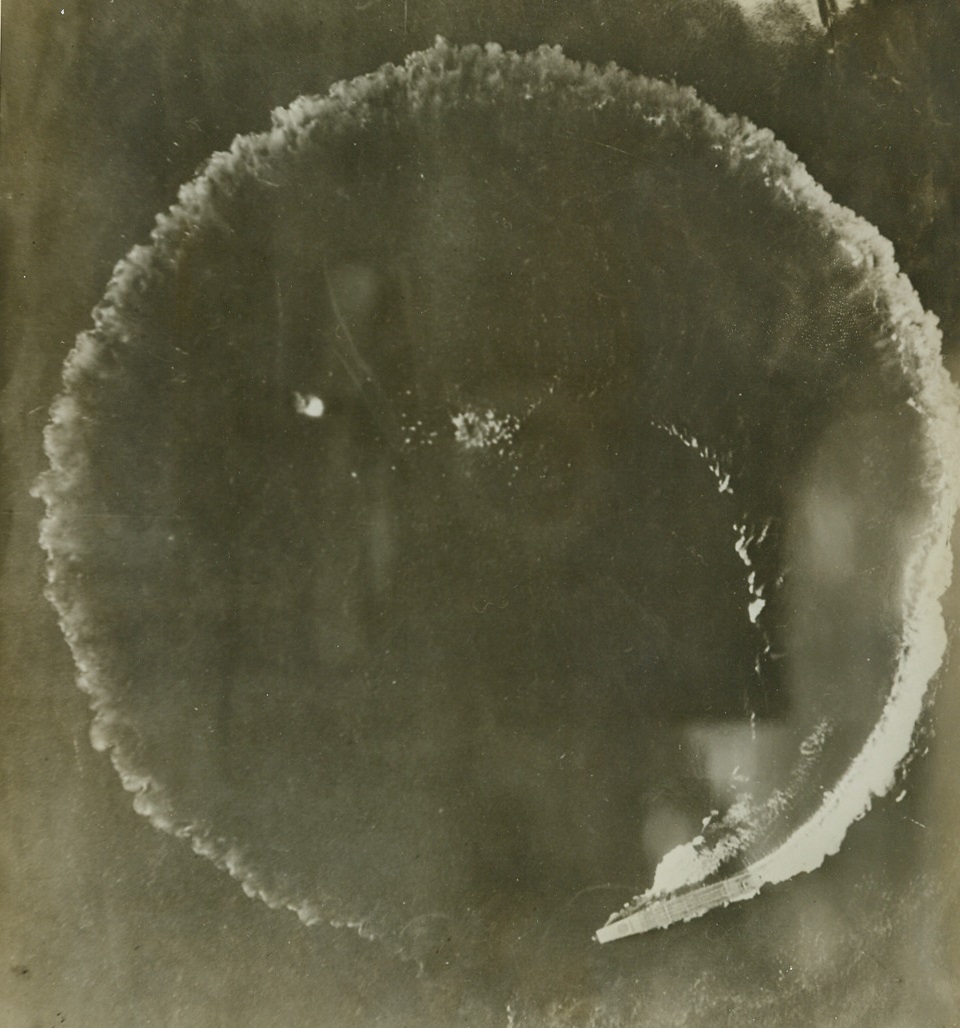
Circle of Terror, 12/30/1942. This unusual photo taken by a U.S. Army photographer flying in a B-17 bomber, one of an attacking formation, shows a Jap aircraft carrier making a perfect circle in its attempt to dodge American aerial bombs, near Midway island. Credit line (U.S. Army photo from ACME);

Aleutian Mud, 12/29/1942. The tasks of provisioning themselves and caring for their equipment sometimes proves as hard as smacking the Japs in fog-bound Kiska island nearby, but Uncle Sam’s flyers pitch right in. The going was rather muddy for this soldier who’s carrying a supply of tent pegs over the soggy ground. Credit (Official Army photo – ACME);
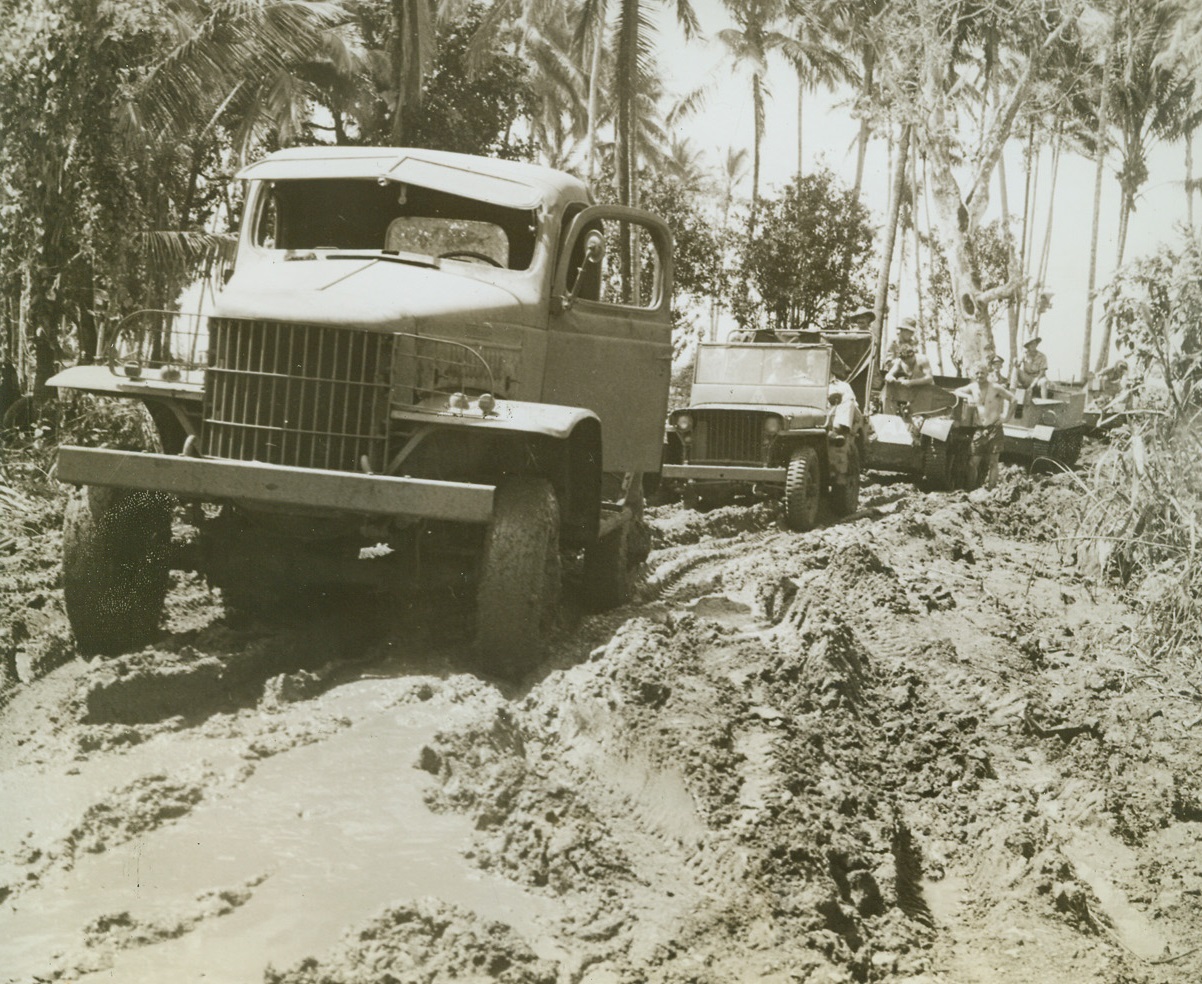
Weather Clear, Track Muddy, 12/29/1942. New Guinea: - The skies had cleared, but the roads were muddy after a heavy rain in New Guinea. But these American Army trucks easily negotiated the sloppy land to deliver supplies to our boys. Credit line (ACME);
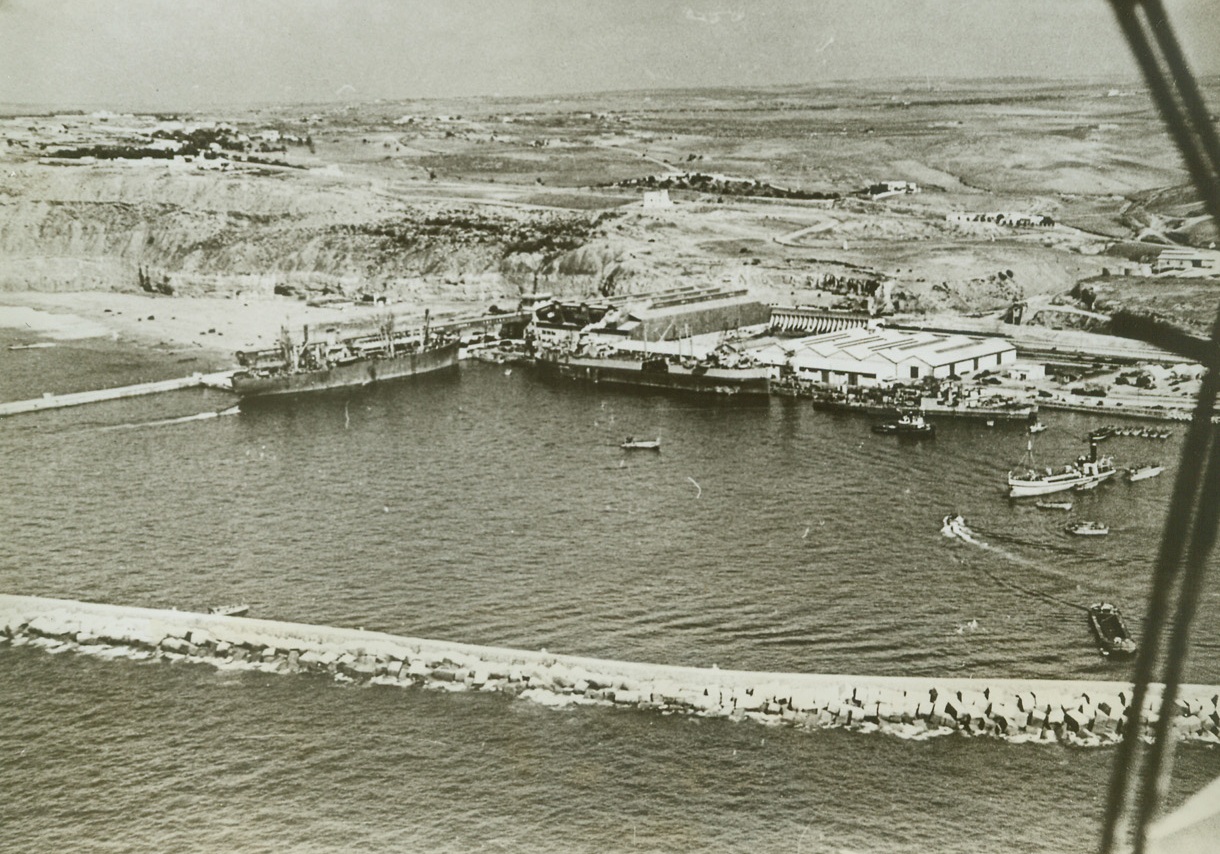
Harbor At Safi, 12/11/1942. A view of the harbor at Safi, French Morocco taken during the occupations of the North African coast by Anglo-American forces. Note tank carrier, (center), tied up alongside dock. This photo was just released in New York. Credit line (ACME);
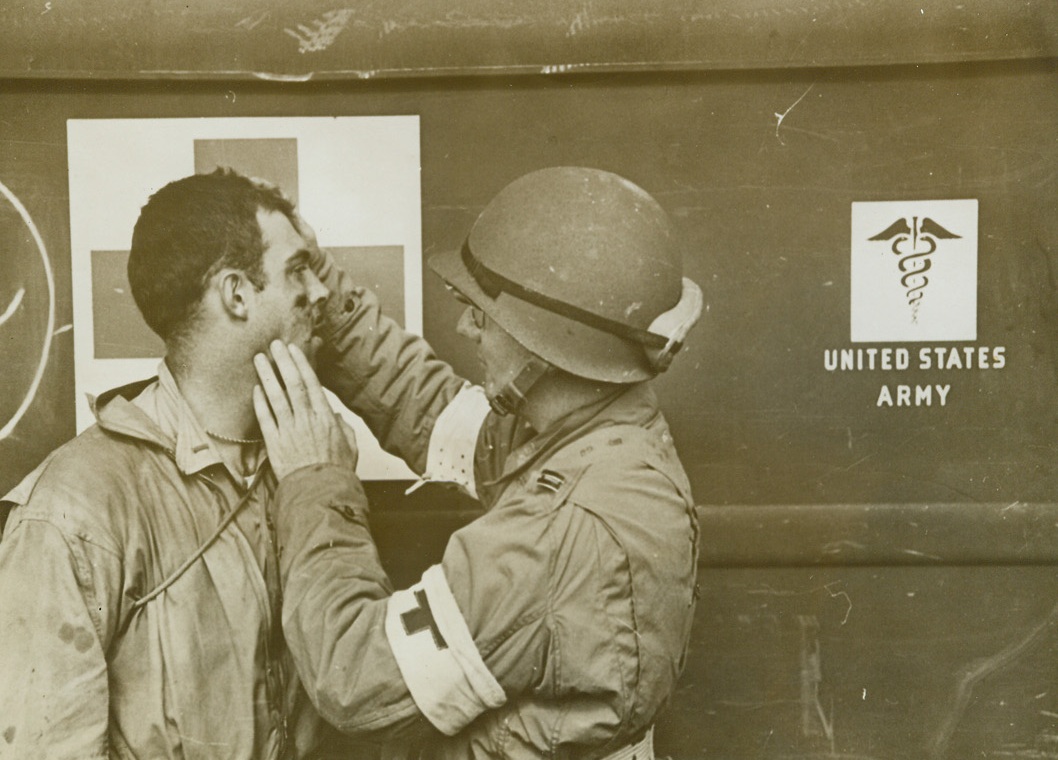
First Aid for Pilot, 12/11/1942. A U.S. Navy ensign receives medical attention from a U.S. Army ambulance surgeon at Safi, French Morocco, after he landed his SBD (Douglas scout bomber) in the water one mile from the beach. His plane had run out of gas. He rowed his rubber boat ashore and walked 40 miles to the base. This photo, taken during the occupation of the North African coast by Anglo-American forces, has just been released in New York. Credit line (ACME);
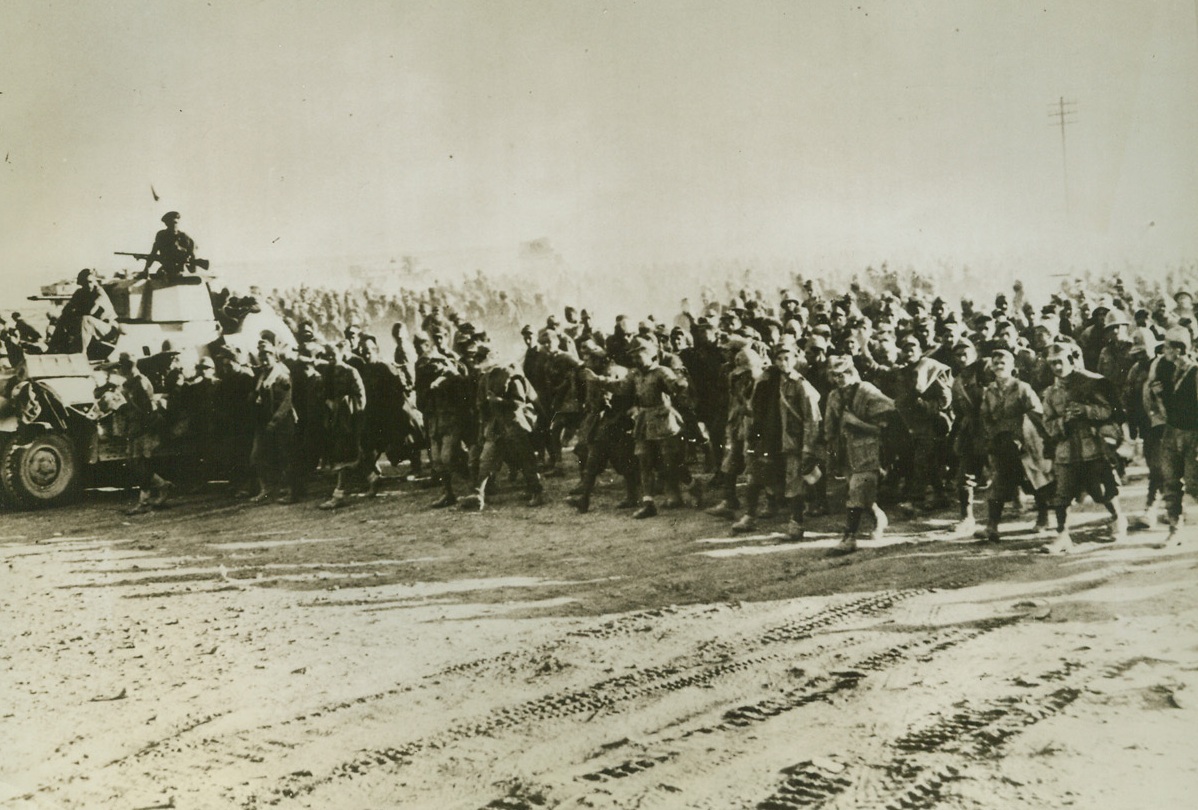
Mopping Up, 12/2/1942. Somewhere in Egypt – Not a fighting man of Rommel’s once-great Army remains in Egypt. Photo shows New Zealanders rounding up some of the tens of thousands of prisoners taken in the desert as the British 8th Army, in rapid pursuit of the fleeing Nazis, “mops up” in Egypt. Latest reports indicate that the 8th Army has successfully engaged Rommel’s forces at El Agheila. Credit line (ACME);
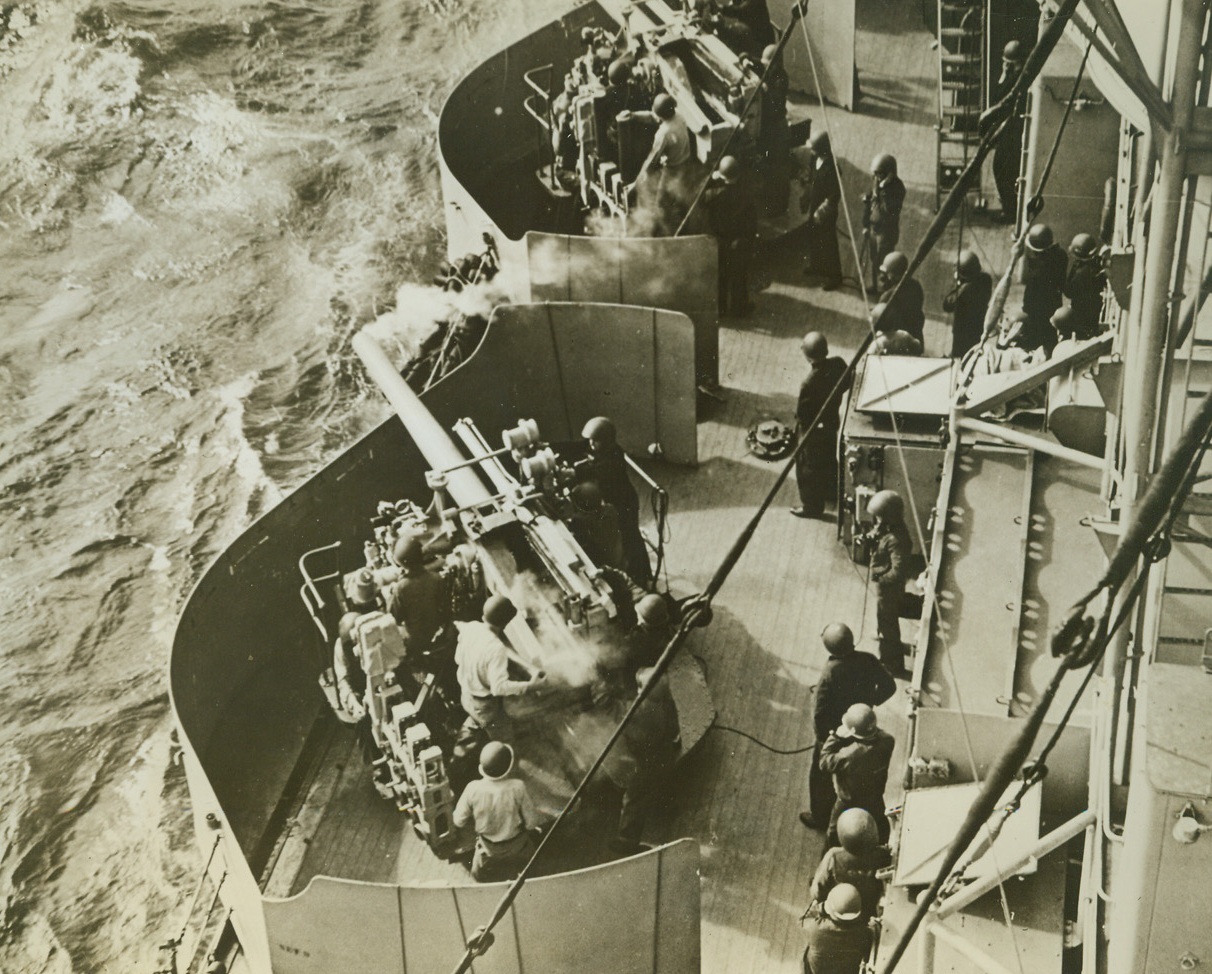
Testing Five-Inch Gun Battery, 12/11/1942. This photo taken during the occupation of North Africa by Anglo-American forces, shows gunners aboard a cruiser, testing a five-inch gun battery as the vessel neared the North African coast. Picture was just released in New York today. Credit line (ACME);
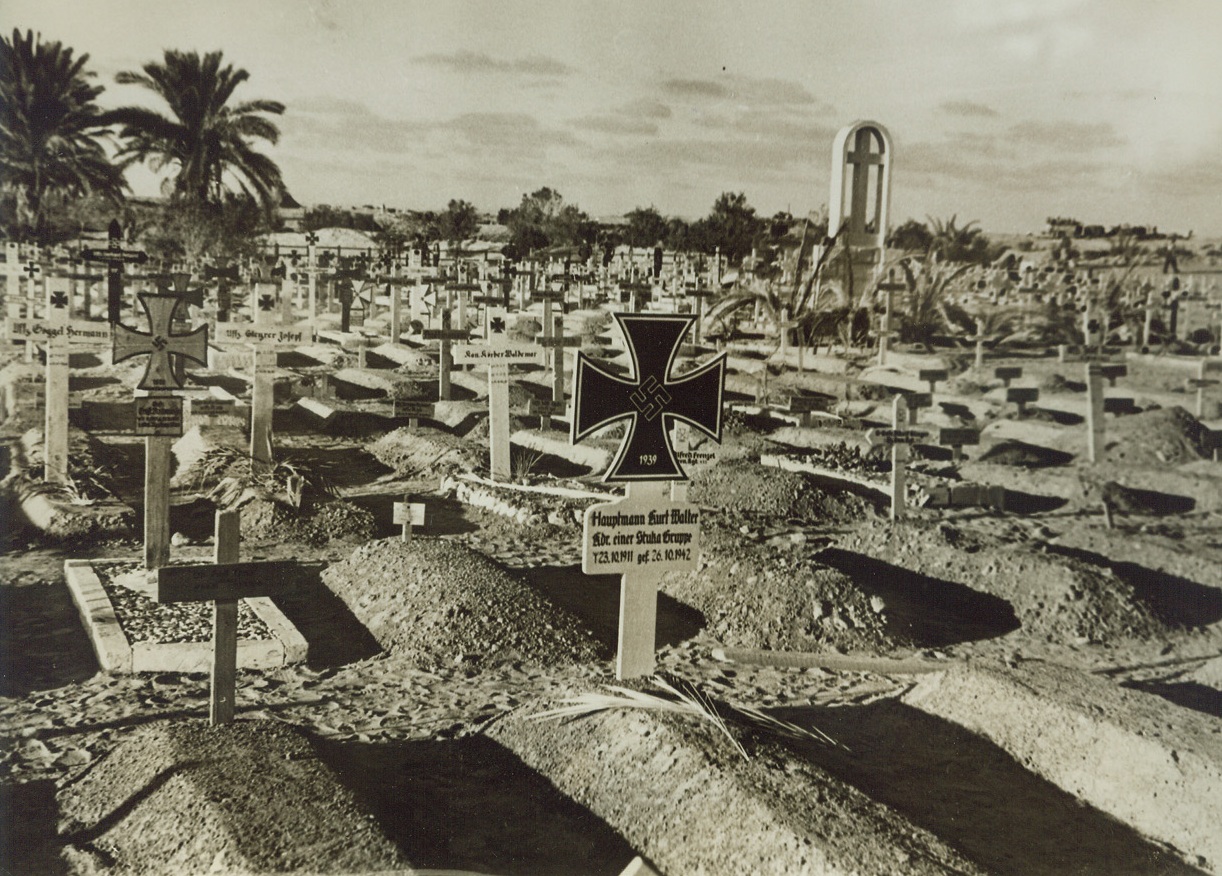
Members of “Master Race” Wound Up Here, 12/16/1942. Mersa Matruh, Egypt - - Elaborate grave markers in this axis graveyard at Mersa Matruh, show where many of Hitler’s Afrika Korps found “the end of the road.” In center, (foreground), a marker bearing a replica of the iron cross, indicates the grave of Hauptmann Kurt Walter, Commander of a Stuka dive bomber squadron, who died three days after his 31st birthday, in the battle of El Alamein. Though only Germans were buried in this cemetery, Italians did most of the work in building it. Germans have been buried, in most cases, far away from the Italians. This held true until recently, when Britain’s 8th Army sent Rommel into headlong retreat and burials became occasions of little ceremony. Credit line (ACME);
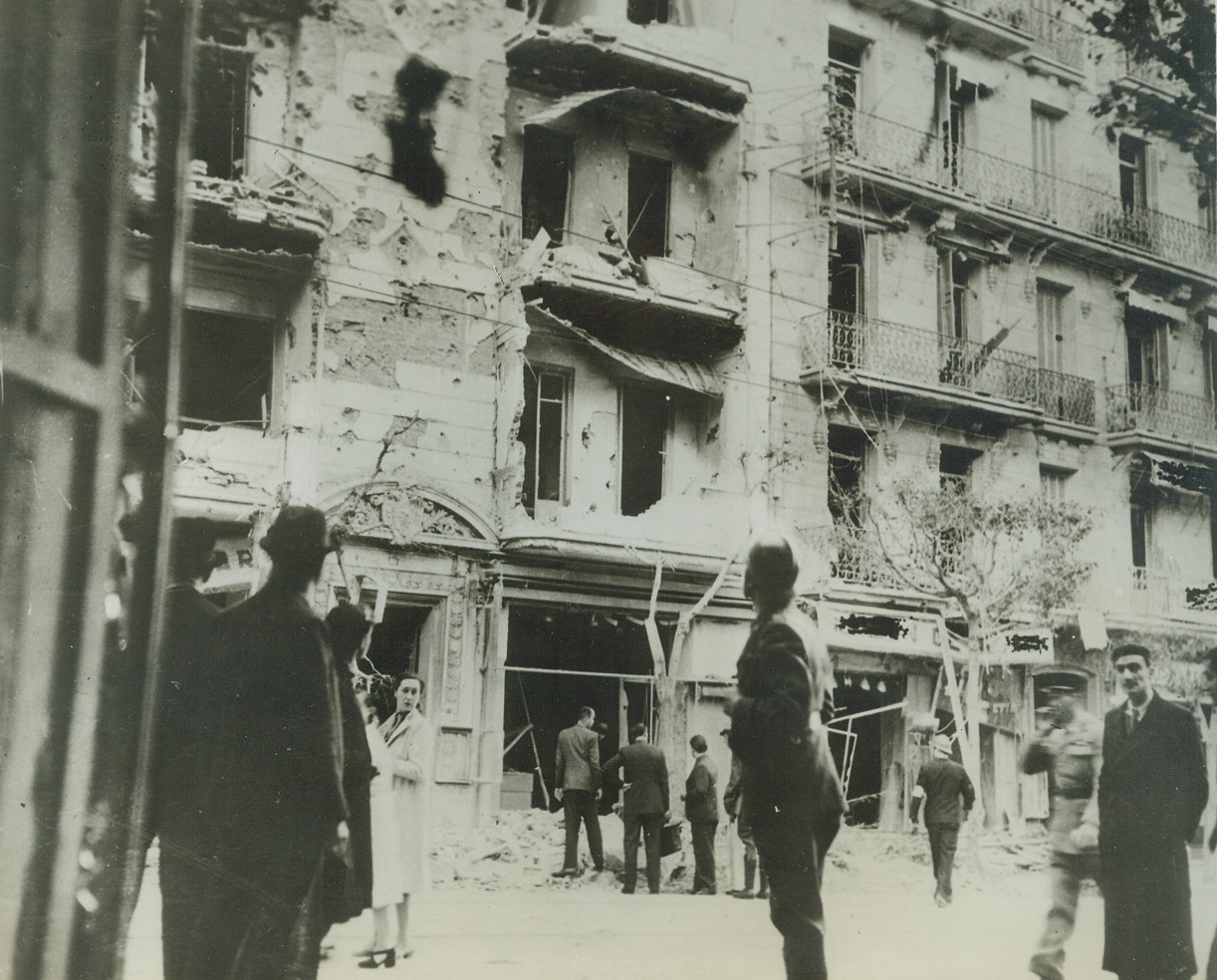
Nazi Raiders Damage Algiers, 12/13/1942. Algiers—Citizens of Algiers curiously inspect the damage done to a building during the first German raid on the territory following the occupation by Allied troops. The man wearing a helmet and arm badge, about to enter the least-damaged building, apparently is a civilian air raid warden. Credit: ACME.;
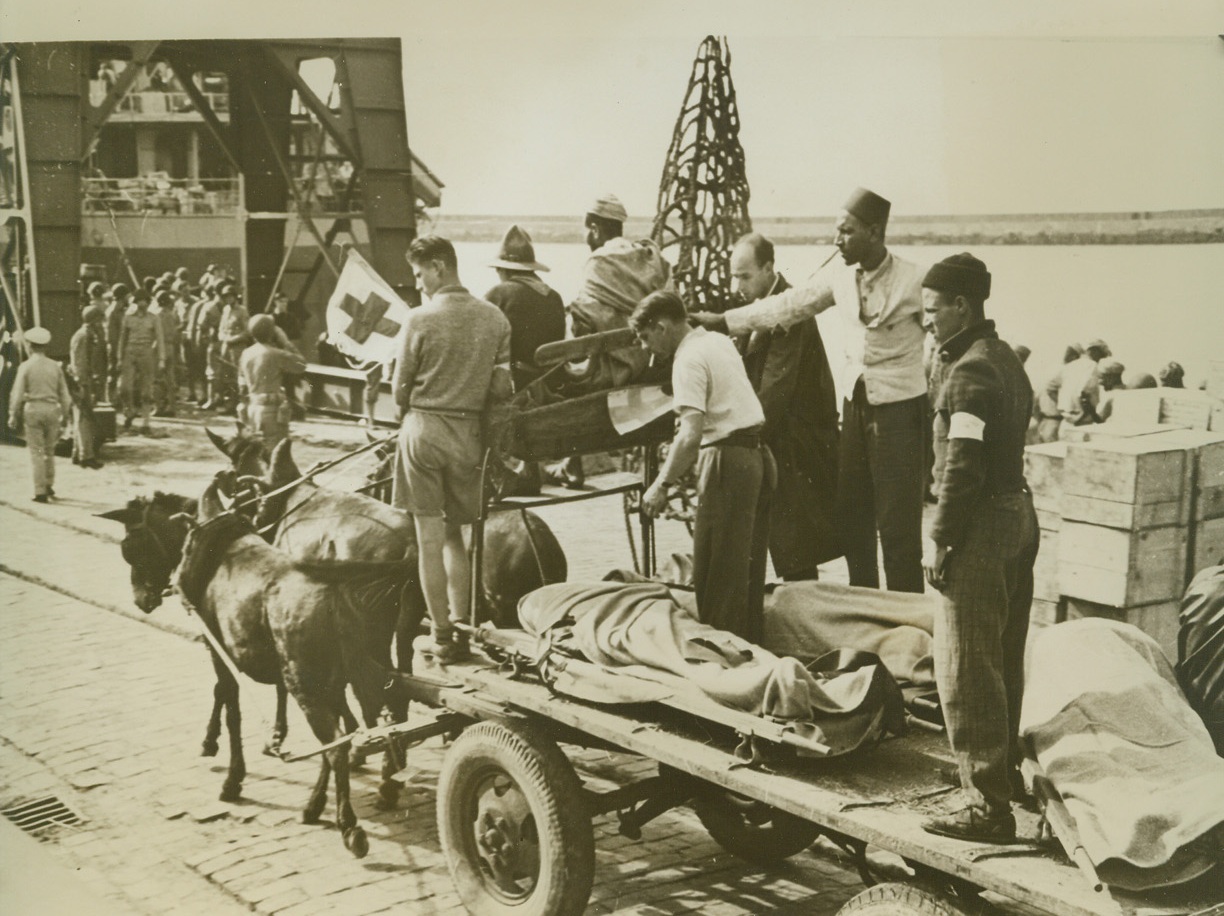
BODIES ON DOCK AT SAFI, 12/11/1942. This photo taken during the occupation of North Africa by Anglo-American forces, shows bodies on stretchers being transported across a dock at Safi. Caption on this pictures, just released in New York today, does not identify the dead either as French or American.Credit Line (ACME);
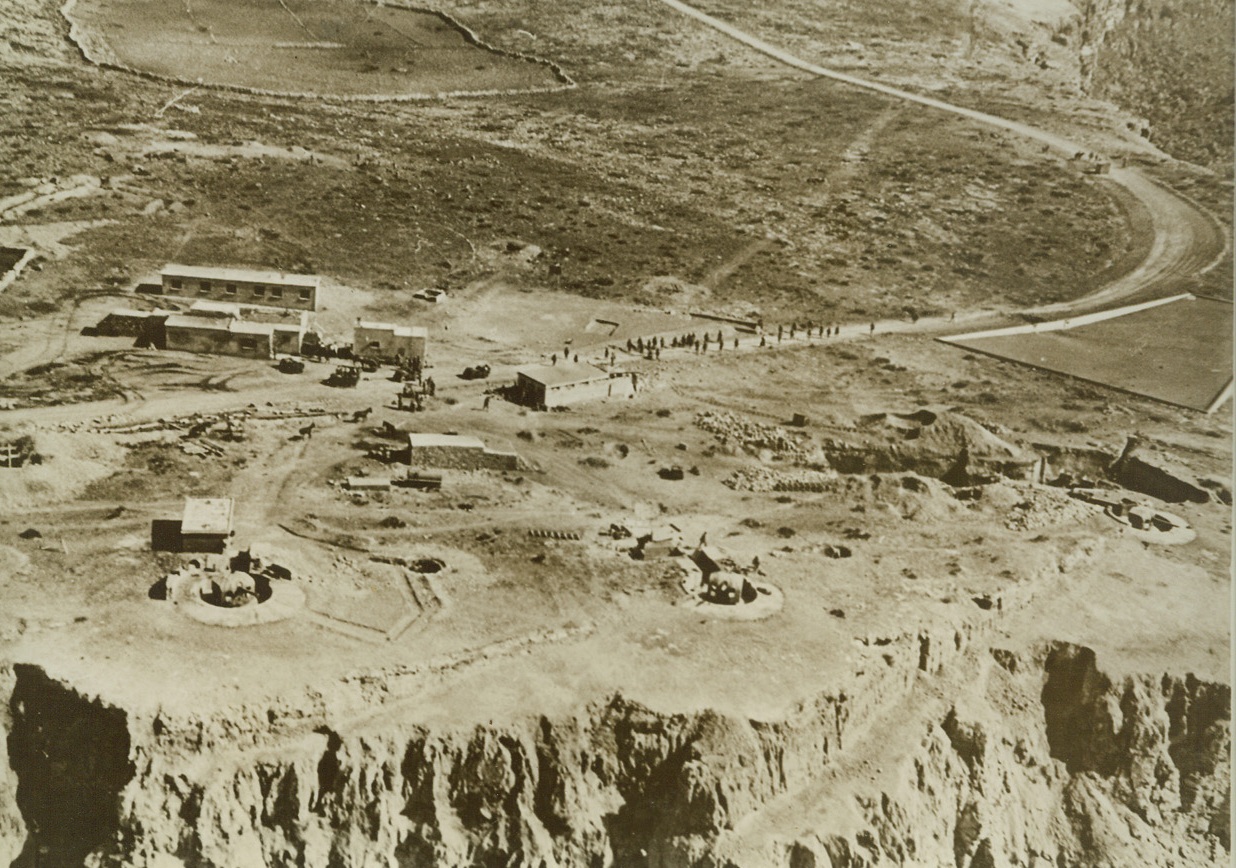
Gun Emplacements at Safi, 12/11/1942. This aerial view of a base on the outposts of Safi, French Morocco, shows coastal rows and steep cliffs, (foreground). Photo, taken during the occupation of North Africa by Anglo-American forces, was released in New York today. (Passed by censors).Credit: ACME.;
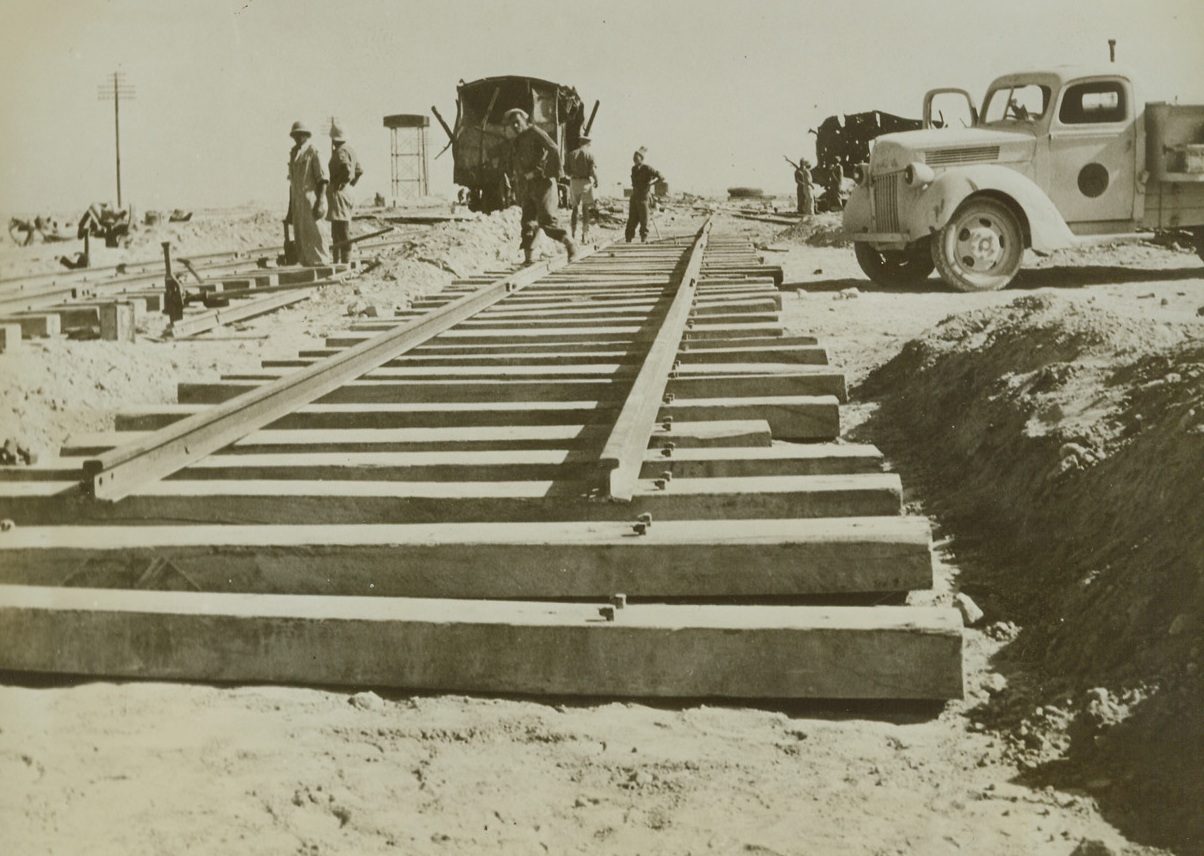
Rebuilding Desert Railway (#3), 12/19/1942.
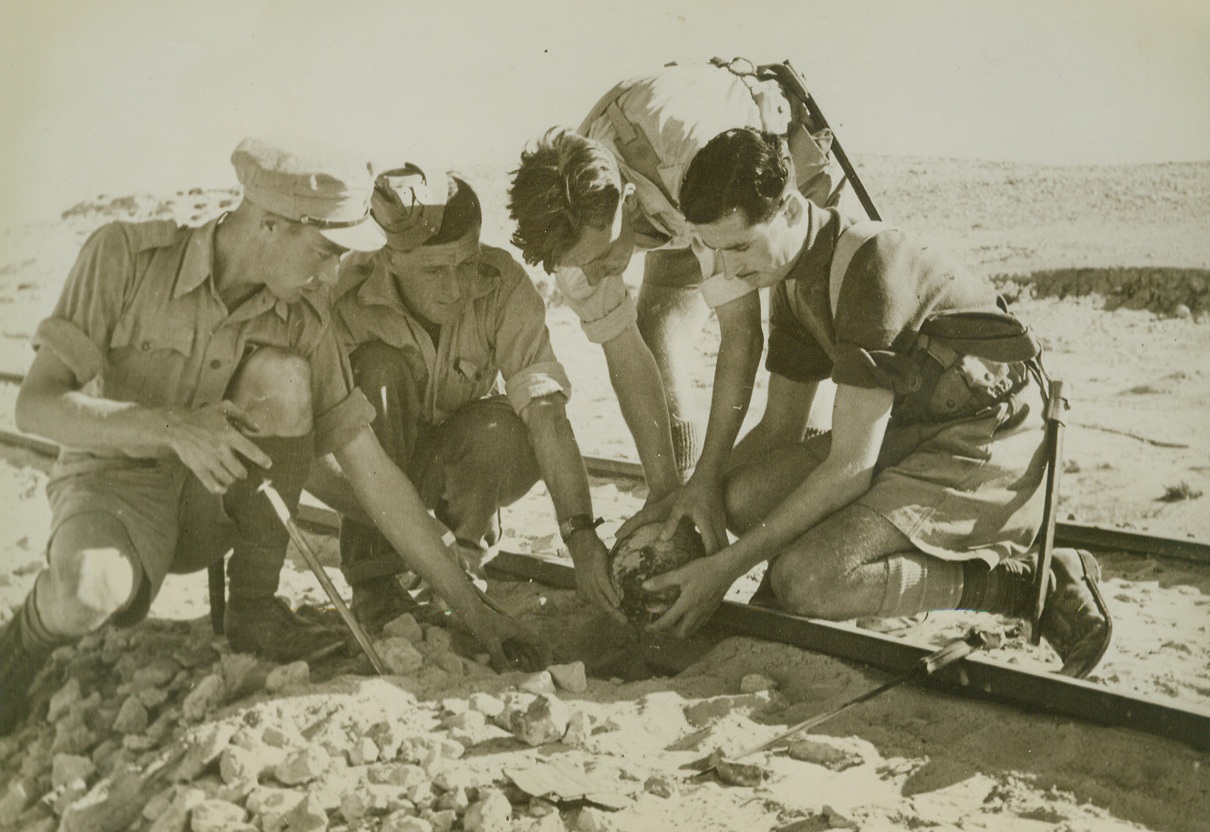
Rebuilding Desert Railroad (#1), 12/9/1942. As Allied forces pursued German Marshal Rommel’s fleeing Afrika Korps toward the west, driving the Axis out of Egypt, British engineers had to rebuild roads and railroads. Every inch of both roads and rail lines had to be searched for mines and booby traps. Here, sappers have located and are removing a mine laid under a rail by the Axis. Note bayonets which were used to probe for mines. Passed by censors.Credit: ACME.;
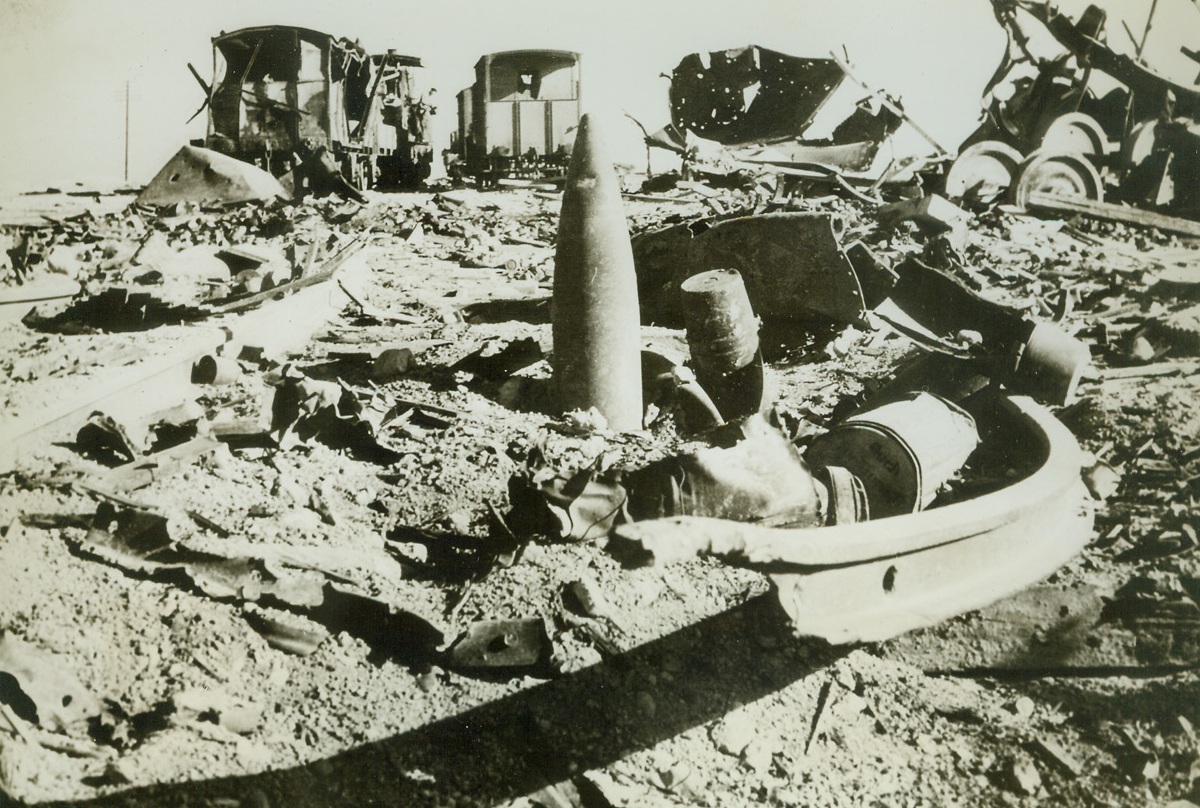
Rebuilding Desert Railway (#2), 12/9/1942. At this spot at Simla, near Mersa Matruh, are the remains of an Axis ammunition train hit by Allied bombers. Explosion ripped up much of the roadbed and presented a large problem for Allied engineers who repaired the railroad after the British recaptured the rail section. This photo just reached New York. (Passed by censors).Credit: ACME;
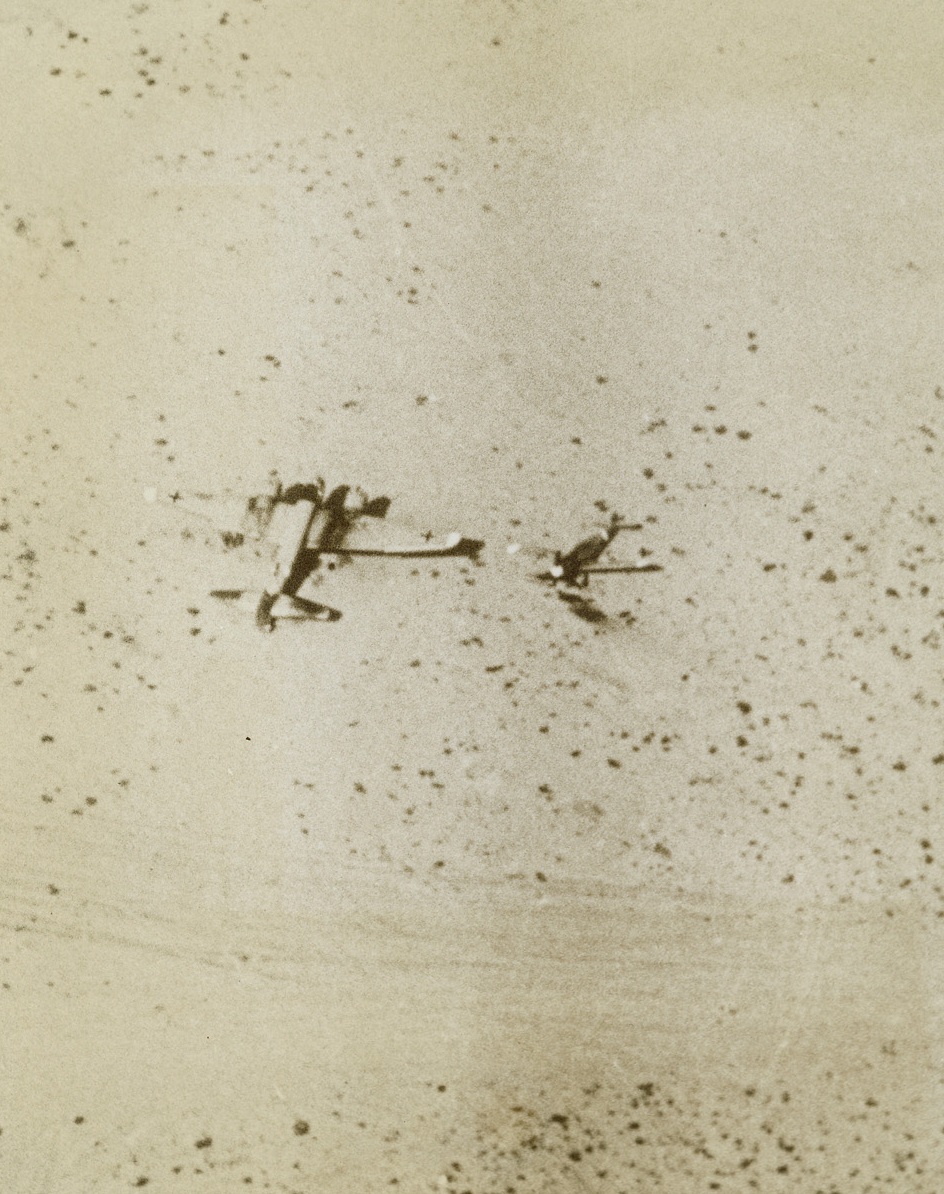
Axis Warbirds Grounded, 12/5/1942. Libya—An Axis bomber and fighter plane were shot down side by side in the desert near Tobruk. Note tracks of land forces in the foreground. This photo was made from a U.S. plane on a mission near Tobruk.Credit: ACME.;

Old Meets New, 12/8/1942. Middle East—A native boy in the Middle East pays a call to an RAF pal at a desert airfield, his tiny donkey becomes even tinier when next to the giant Wellington bomber, but extremes in transportation are commonplace in this desert country where carts and camels jog along the same roads as streamlined automobiles and tanks.Credit: ACME.;
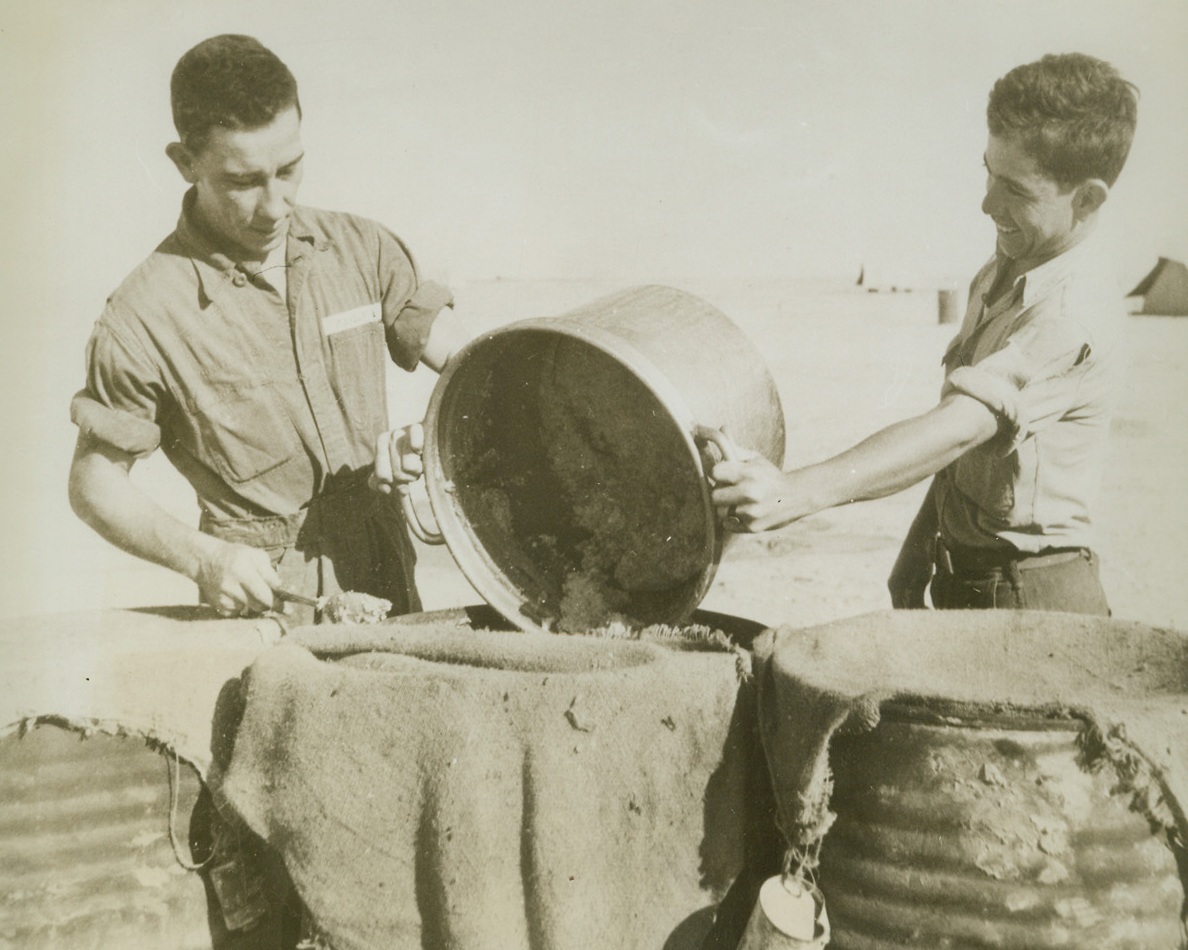
Even in Africa, 12/8/1942. Western Desert—If Pvt. Frank Pauly (left), of Canton, Ohio, and Pvt. Louis Perrez, of Cotuela, Texas, had any idea they were going to get out of KP duty when they headed for Africa, they received an unwelcome surprise. But the two privates don’t seem to mind too much, as they roll up their sleeves and pitch in, at a Western desert bomber base.Credit: ACME.;

When U.S. Landed Forces in Africa, 12/1/1942. Shown above is an aerial view of the inner harbor at Casablanca, French Morocco. It was made from a U.S. plane and shows the inner harbor. The two thin lines to the right of the breakwater shows the sudden drydock, while to the left of the breakwater the small dots on the water are some of our landing barges. Effects of American shell fire are not apparent here. Credit: Official U.S. Navy photo from ACME.;
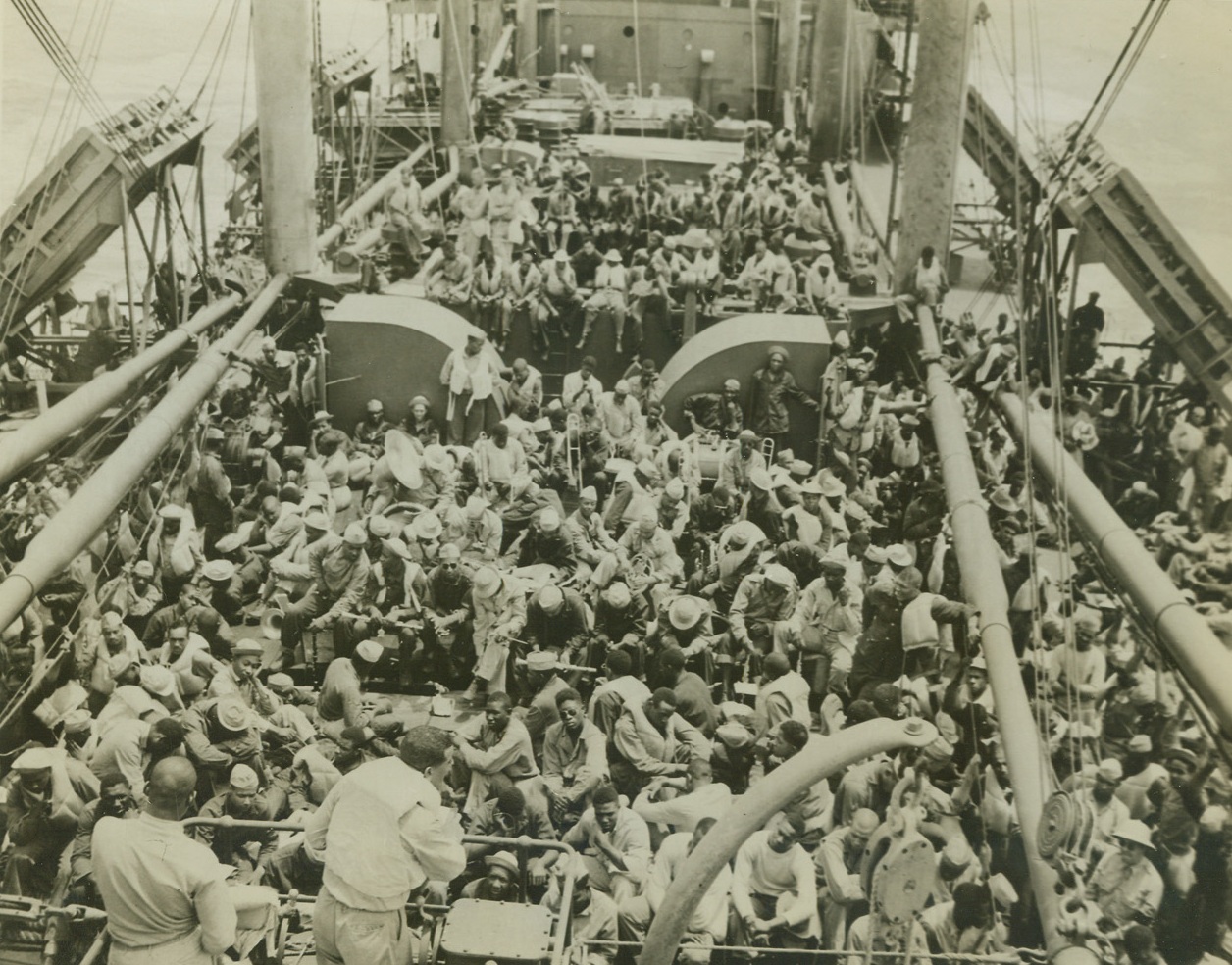
American Troops Arrive in Liberia, 12/3/1942. Monrovia, Liberia—President Edwin Barclay of Liberia today announced the arrival last June 17th of U.S. troops in this strategically-located country, which is located 700 miles south of Dakar, on the west African coast. The Americans, negro soldiers with white officers, will protect—with the consent of the Liberian government—this tiny republic which is considered a vital spot in the trans-African lifeline of the United Nations. It is regarded as an important base for air operations in Africa and the western part of the South Atlantic. An agreement between the United States and Liberia allowing the occupation, was concluded last March 31st. In this series of photos, released by the war department in Washington today, the U.S. troops are shown aboard a transport just before they arrived in Liberia. New York BureauAs the transport flows steadily through bug-infested waters, Chaplain J.R.C. Pinn (in immediate foreground with back to camera, right), conducts Sunday services on the forward deck. Every available spot is filled.Credit: U.S. Army photo from ACME;
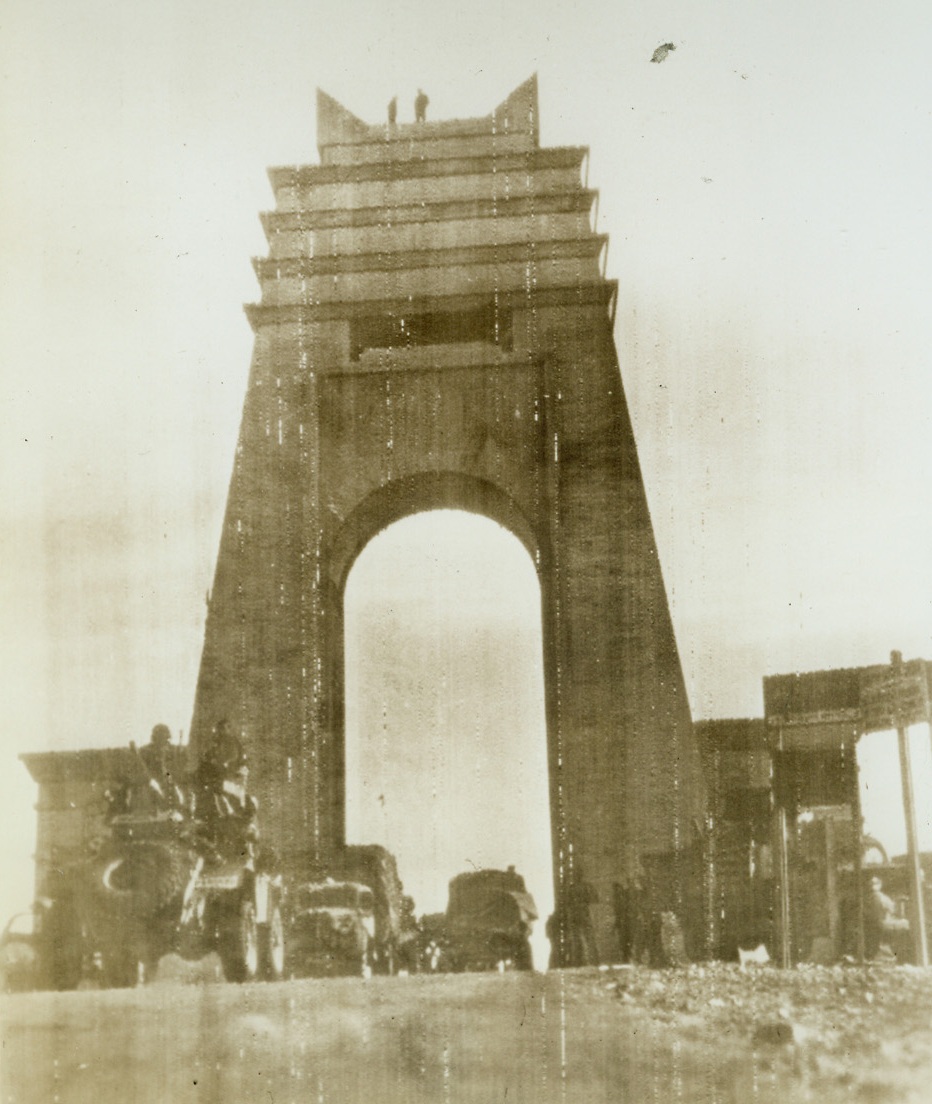
Thru Marble Arch, 12/26/1942.
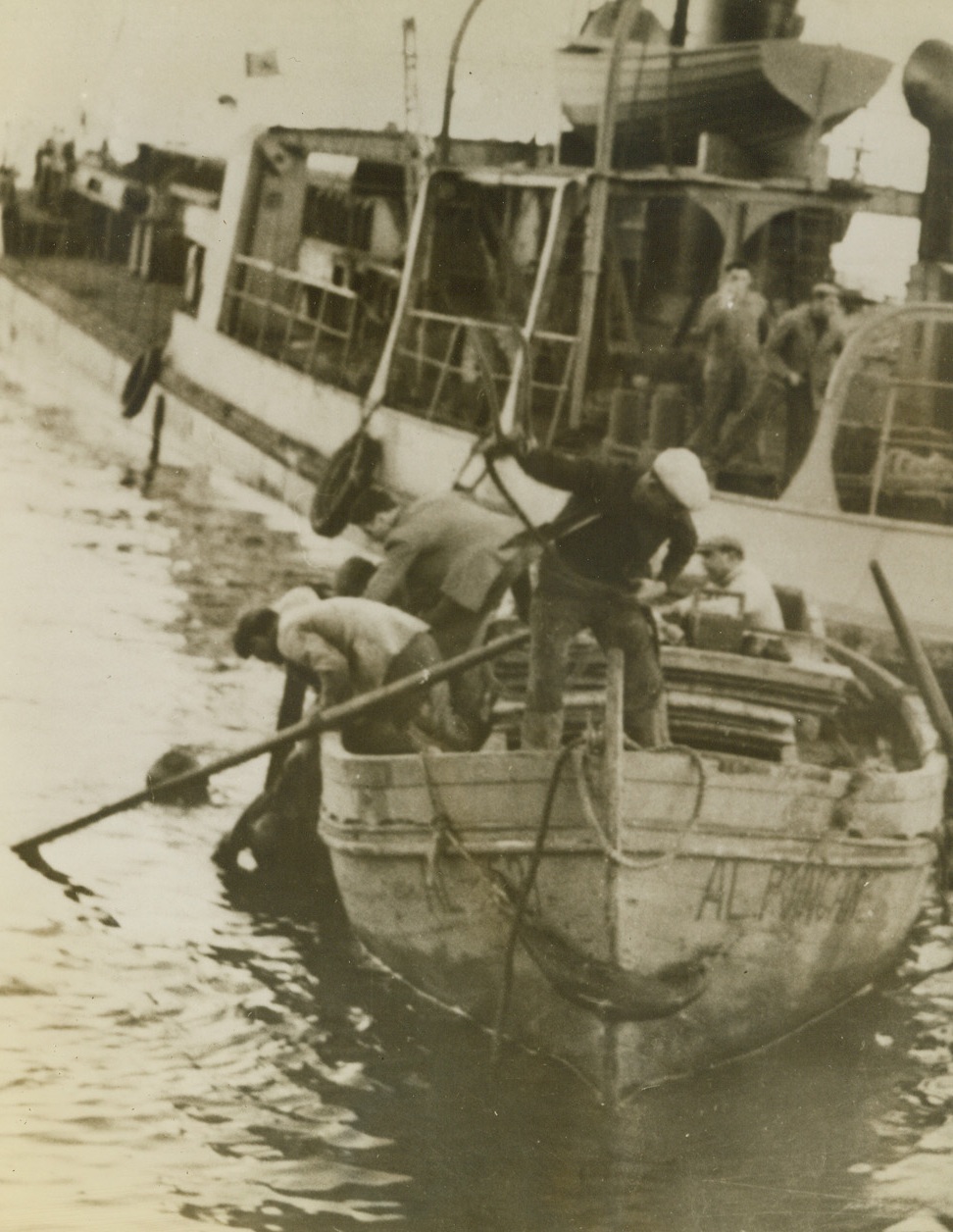
Rescued from Sunken Tank, 12/26/1942. Algiers—When U.S. General Grant tanks were being unloaded at Algiers, one fell into the water. Two of the crew swam ashore, but the third went down to the rescue and this photo shows him bringing the crewmen up.Credit: ACME.;
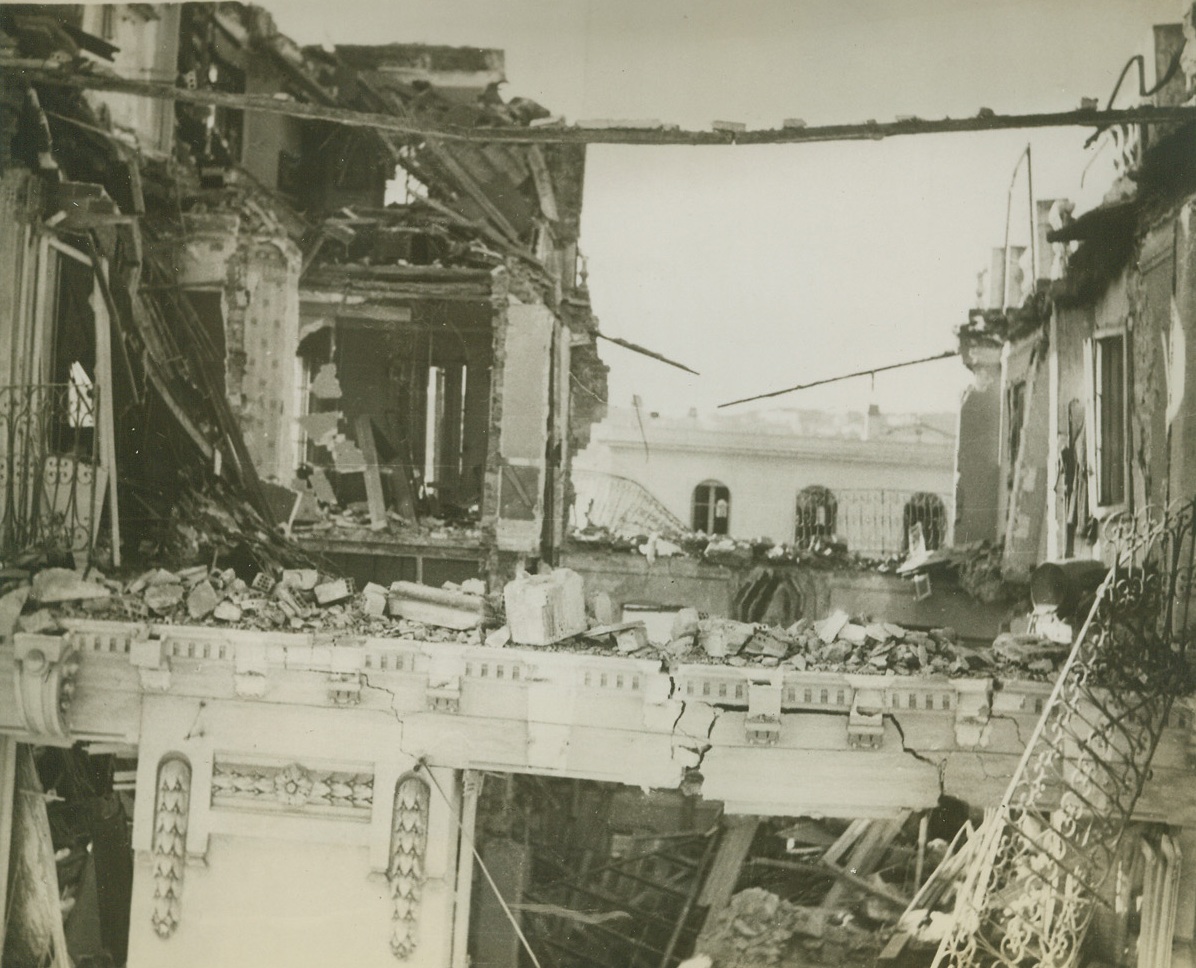
After German Air Raid in Algiers, 12/26/1942. Here is some of the damage done to the lightly built buildings of Algiers during the first raid carried out by the Germans following the occupation by U.S. troops. Passed by censor. Credit: ACME.;
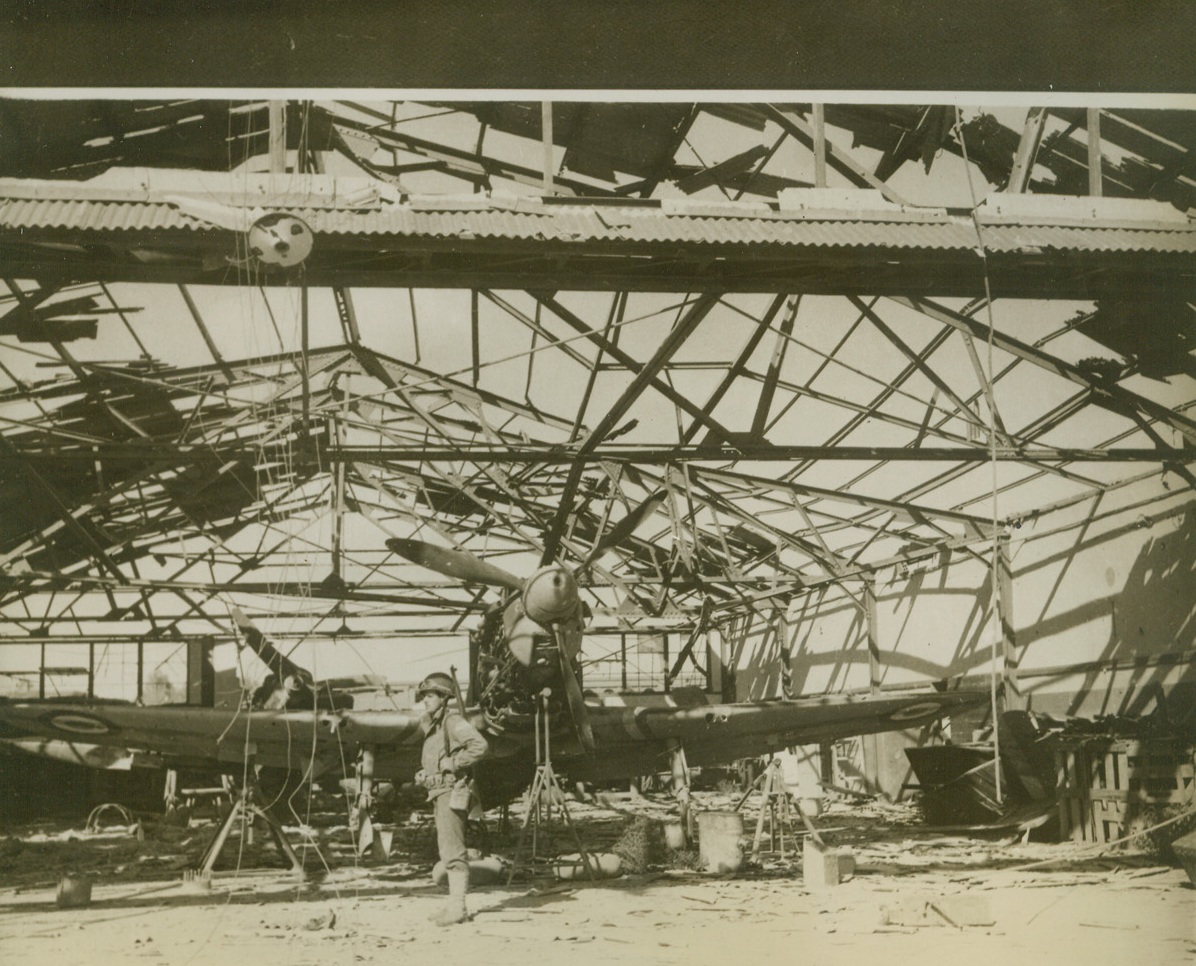
Americans on Duty in North Africa, 12/26/1942. An American soldier stands guard over a wrecked French plane beneath the skeleton of a hangar at “La Senia,” one of the principal airports captured by the United Nations near Oran. Passed by censor. Credit: ACME;
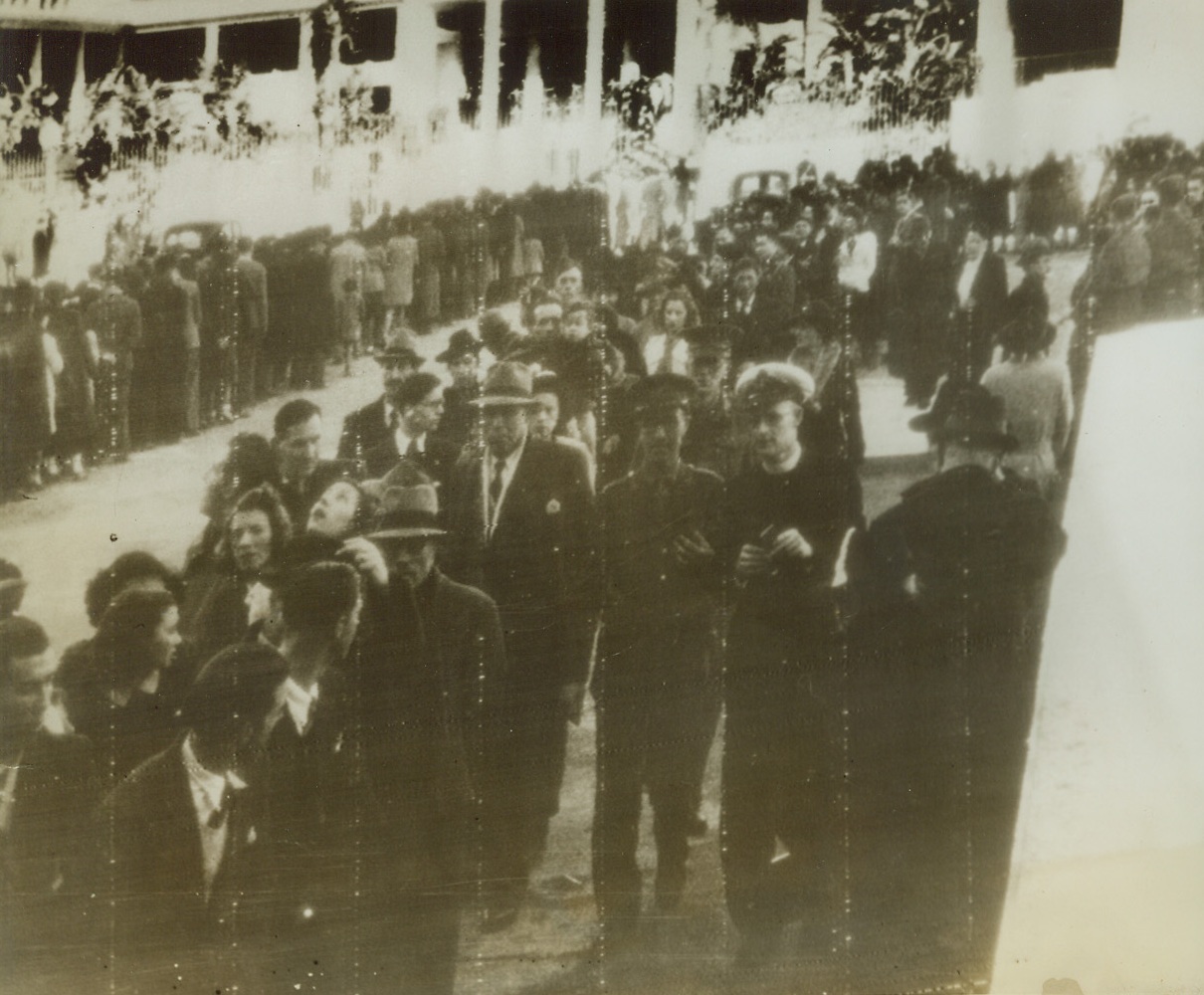
Paying Last Respects to Dablan, 12/28/1942. Algiers—Closely packed civilians file past the bier where Admiral Jean Francois Dablan lies in state, in Algiers. The slain French chief might have caused mistrust in some parts of the world, but this photo is testimony that he was popular in French Colonial America. His bier may be seen in the distant background between the double-lines of visitors. Credit: ACME radiophoto;
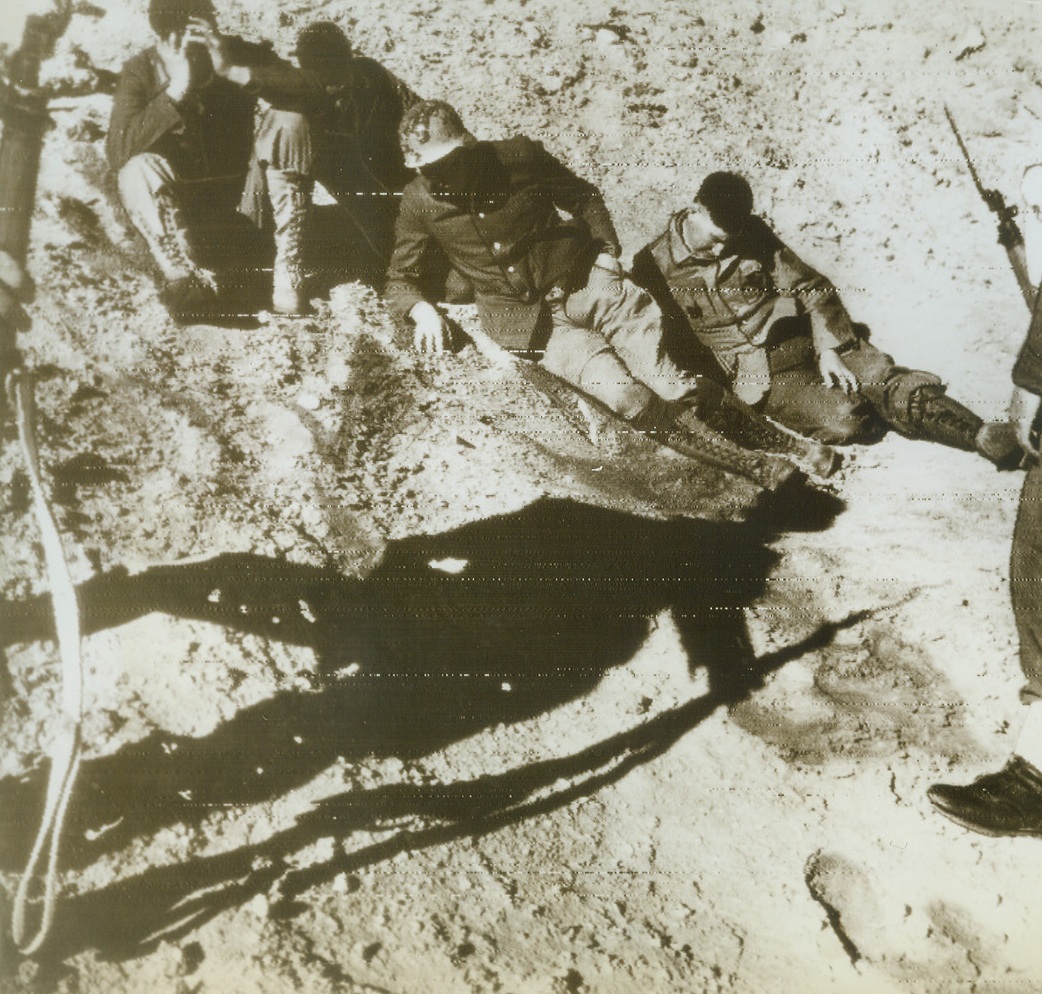
Shadowed by the Future, 12/28/1942. Western Desert—The shadow of an English guard is before these Nazi prisoners in a photo that is symbolic of the entire British advance in the desert where thousands of Nazis were rounded up. These spiritless Germans were captured after our Allies left Agheila and started toward Tripoli. The British are now only 180 miles from Tripoli where Rommel is moving the bulk of his army, 90 miles from the Eastern Tunisian border. Radioed from Cairo to N.Y. today. Credit: ACME radiophoto.;
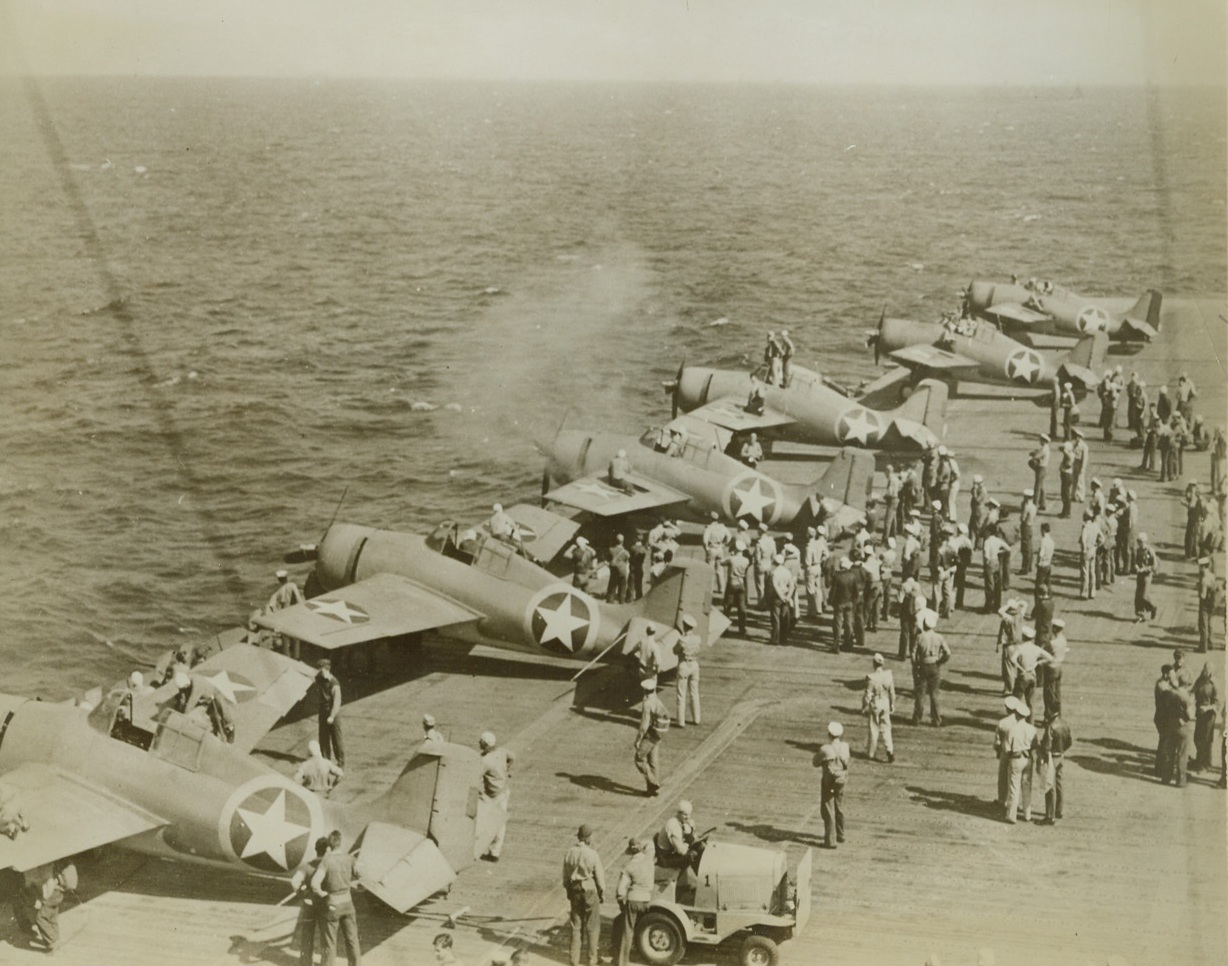
A Stitch in Time, 12/30/1942. Six U.S. Navy fighter planes line up on the side of a flight deck of an airplane carrier for machine gun firing, a precautionary check before beginning operations in North Africa. Credit: Official Navy photo, ACME.;
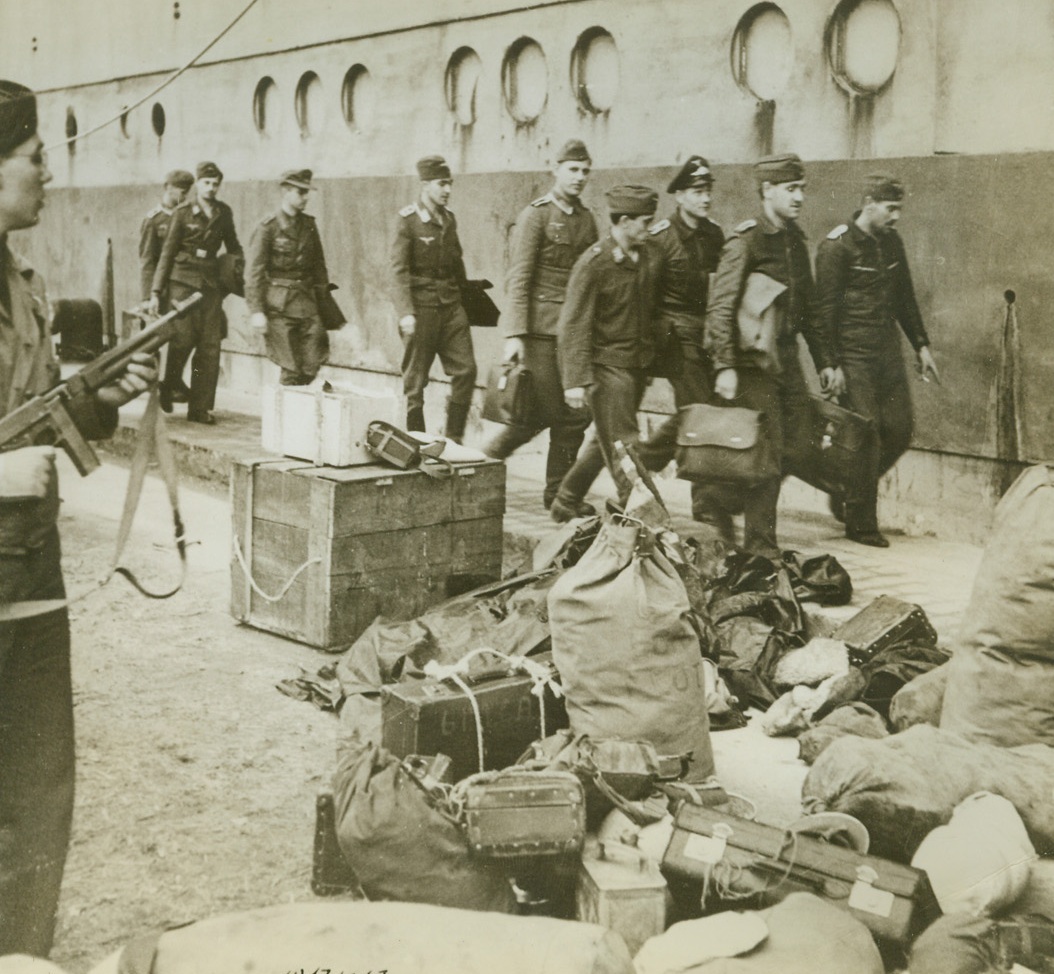
Rounding Up the Enemy, 12/19/1942. Algiers, Algeria—Under the watchful eye of an American soldier with a Tommy gun, German prisoners march onto a boat which will take them to a prison camp. American and British troops, soon after landing in North Africa, rounded up all enemy personnel and evacuated them from the area, to the obvious delight of the natives. Latest reports from North Africa indicate that American flying forces continue to pound the Axis in Tunisia while ground patrol activity of the Allies increases. Passed by censor. Credit: ACME.;
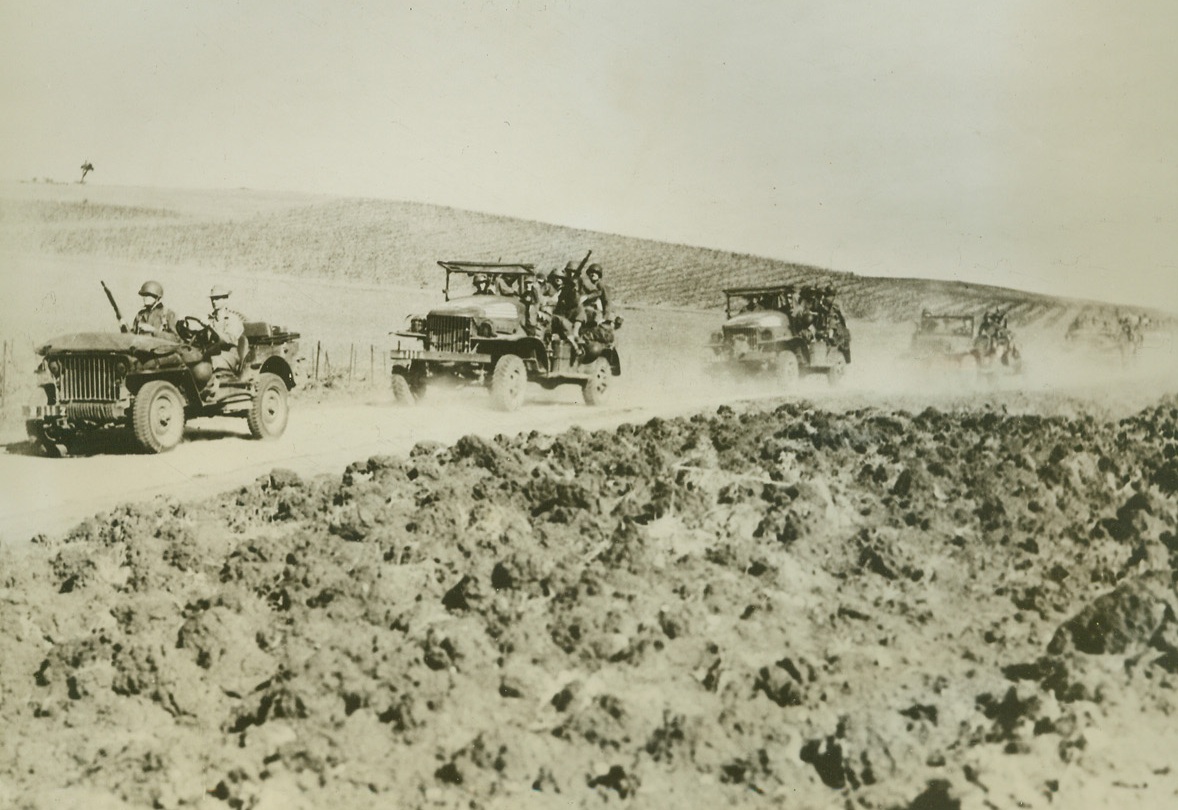
U.S. Speeds Through Algeria, 12/18/1942. Algieria—United States motorized columns advance rapidly through Algeria on their way to new battlefronts. They are probably heading toward the Tunis area where, at the present time both Nazis and Allies are bringing up reinforcements as good weather indicates that new, heavier battles may be expected. Credit: ACME.;
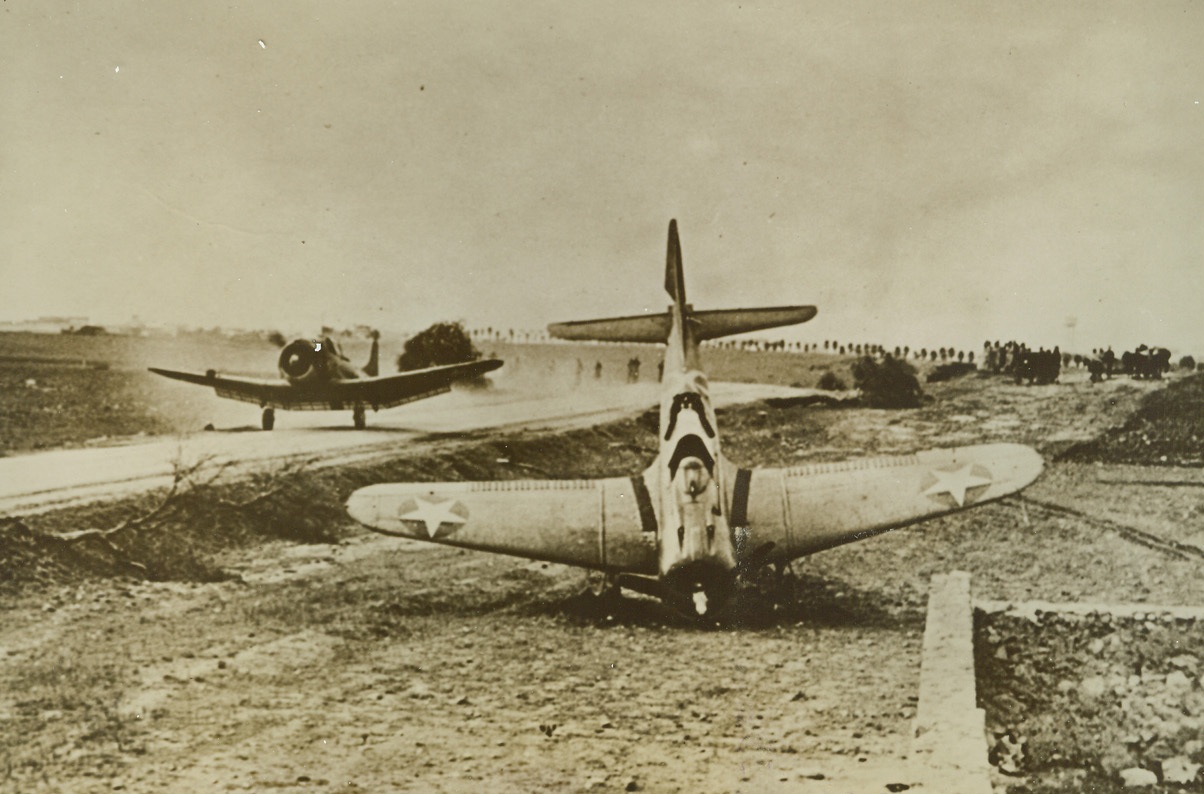
Yank Plane Takes Off (part of title illegible), 12/11/1942. A U.S. Navy dive bomber takes off from a road near the Safi, French Morocco airport, while another is shown nosed over (foreground). This photo, taken during the occupation of North Africa by Anglo-American forces, was released in New York today. (Passed by censors). Credit: ACME.;
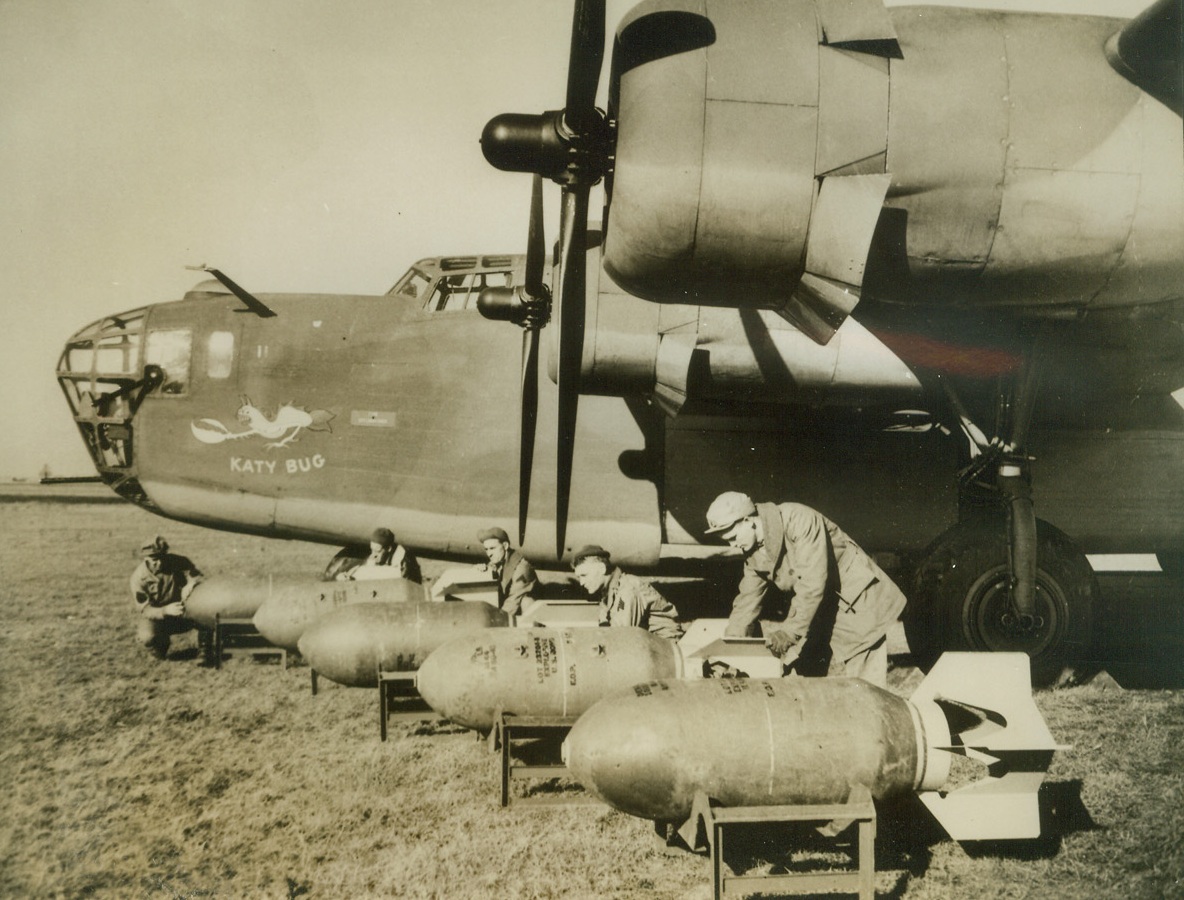
First Pictures of American Bombs in Britain, 12/11/1942. England—This is one of the first photos of the American-made 1,000 pounds bombs that are now being sent to the Axis on American “liberators,” manned by American crews. The famed giant “Liberator” is the same type plane that took Churchill to Russia and the Near East and participated in the daylight attacks on Lille. Credit: ACME;
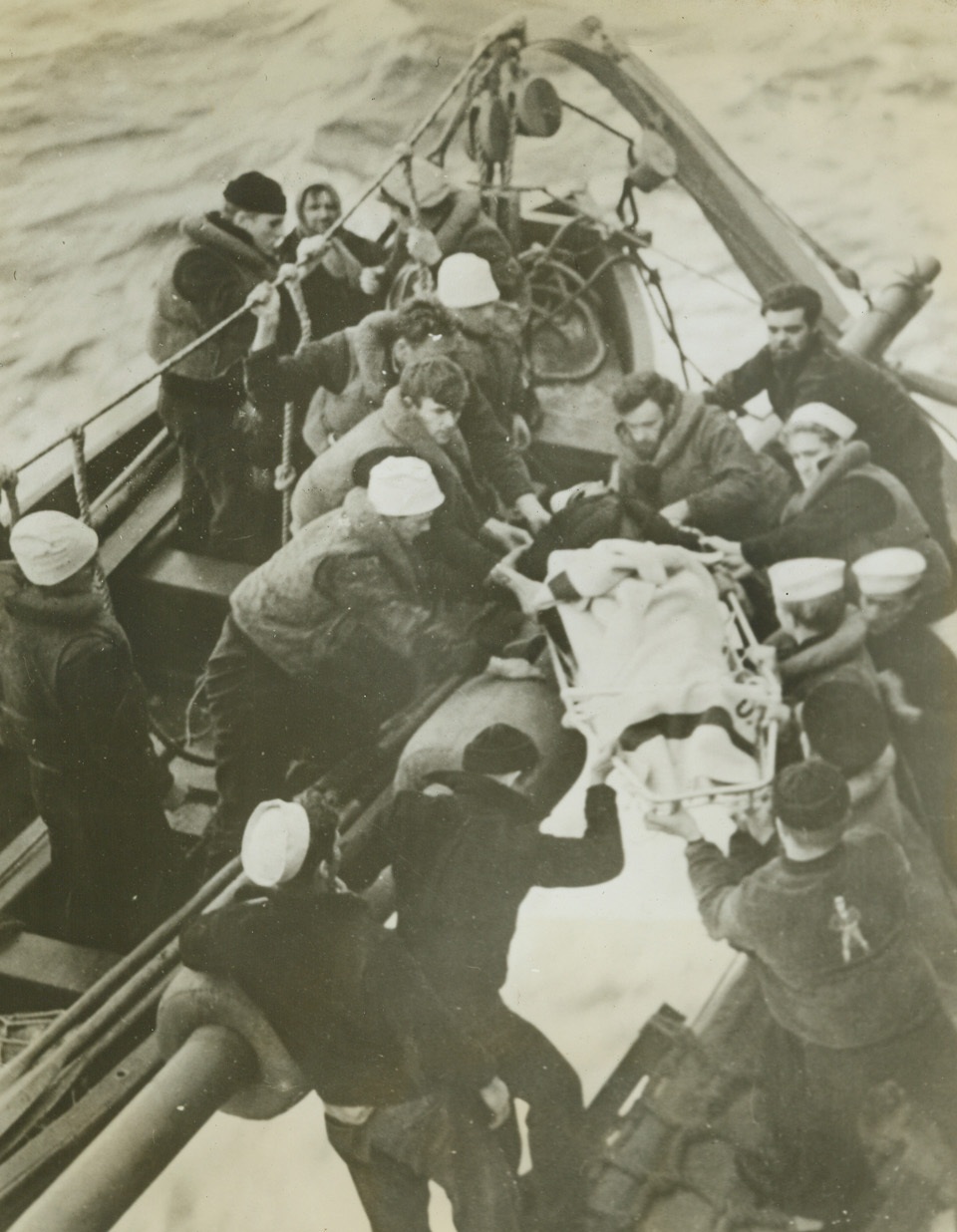
Agents of Mercy, 12/31/1942. Somewhere on the North Atlantic—Picked from the sea, the survivors of a torpedoed British merchant ship are made as comfortable as possible aboard a U.S. Coast Guard cutter. They were given immediate hospital treatment by Coast Guardsmen and taken to a friendly port. Passed by censor. Credit: U.S. Coast Guard photo from ACME.;

Practice Commando Tactics at Sea, 12/21/1942. At Sea—US Fighting men practice commando tactics on a ship under way at sea. A net is suspended from a ship boom so that the men can learn how to transfer into barges in actual operations. They carry all the equipment they would normally have in an actual landing. Credit: ACME.;

No Title. 12/2/1942. LONDON, ENGLAND - Little Joan Condon, a 12-year-old British schoolgirl, knows that "war is hell." A victim of an air raid, she lost her leg and had to get an artificial limb. The brave youngster overcame her disability and brought her skipping rope to the House of Commons to prove to members of that body that she is "just as good as new." She is shown outside the House, chatting with a London Bobby.;
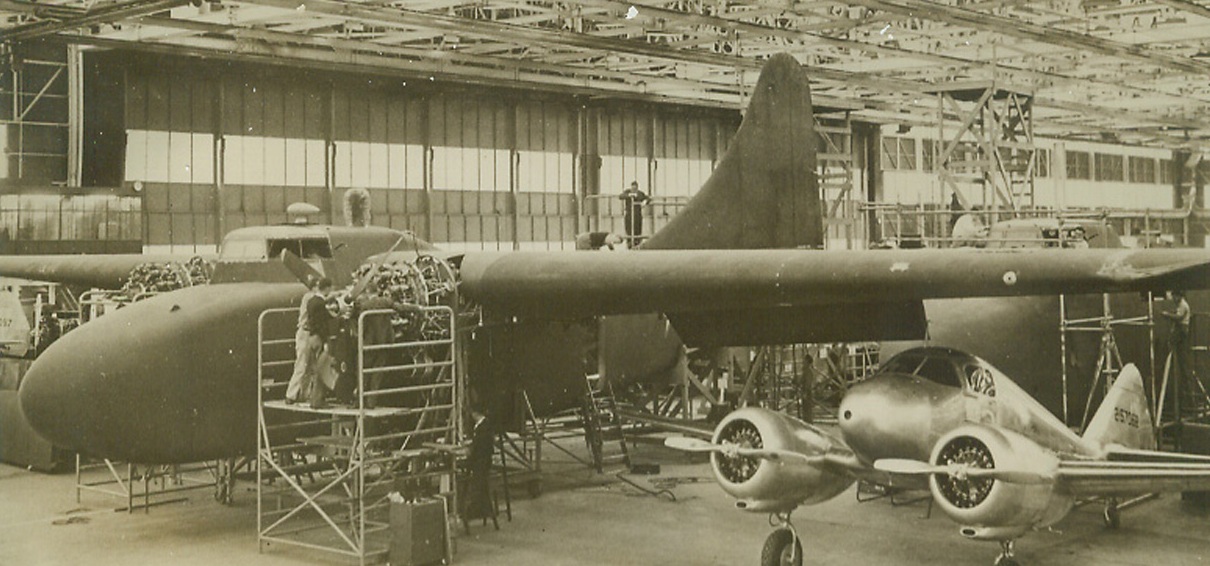
All-Wood Transport Plane, 12/12/1942. This is one of the first photos of America’s first all-wood military plane to be released. The plane, which is nearing completion at a plant of the Airplane Division of the Curtiss-Wright Corp. “somewhere in Missouri,” will undergo flight tests shortly. It will be used by the U.S. Army Air Forces to transport paratroops and air-borne troops to battle areas. Note how the Curtiss (C-76) Caravan dwarfs the Curtiss (At-9) Jeep beneath its wings in the foreground. Credit: ACME.;
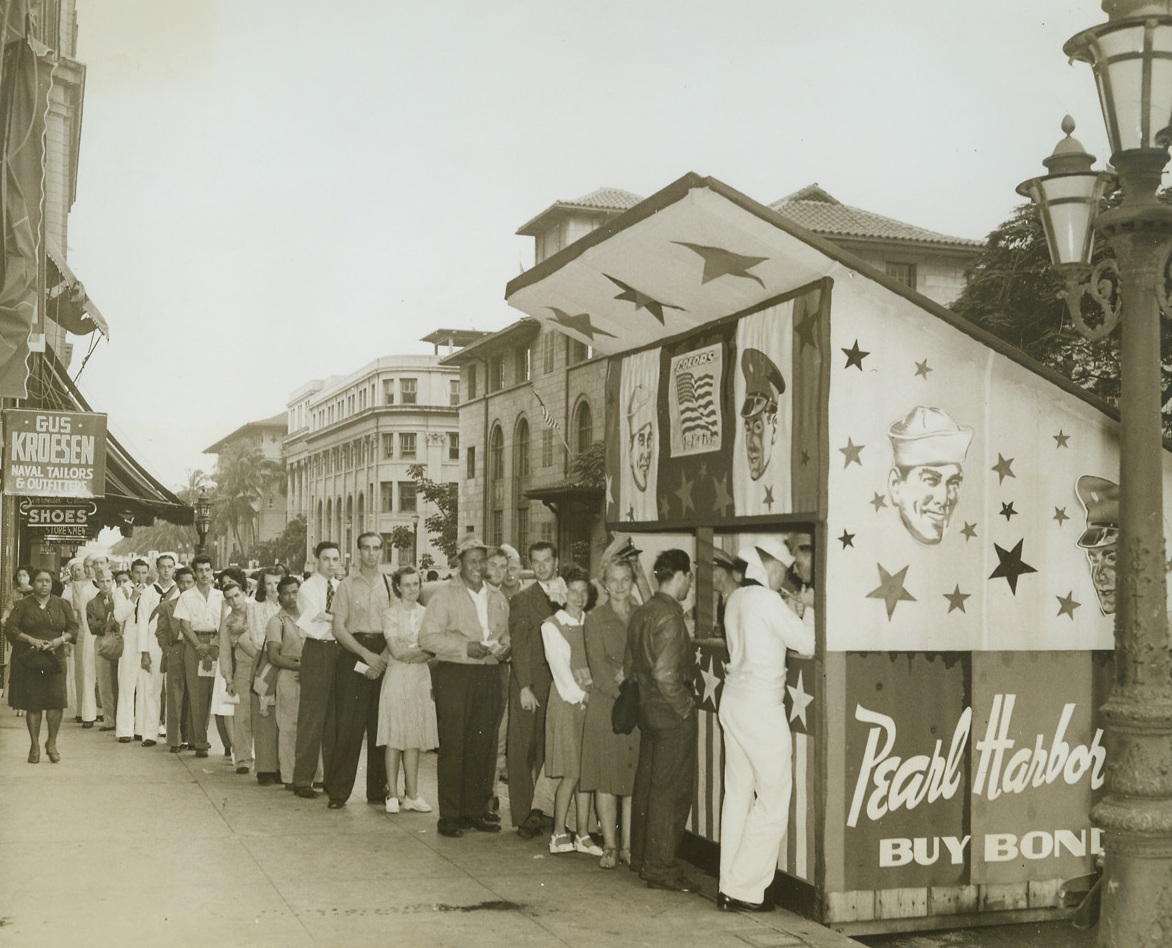
They Said It With Bonds, 12/16/1942. Honolulu, Hawaii—Hawaii remembered Pearl Harbor on the anniversary of the Japs’ treacherous attack by buying bonds—three and a half million dollars worth. One of the many lines that formed in Honolulu on December 7, 1942, by bond-buyers is shown. Crowds jammed the streets where 15 bond booths did land office business selling bonds stamped with the souvenier stamp, Remember Pearl Harbor.Credit: ACME.;
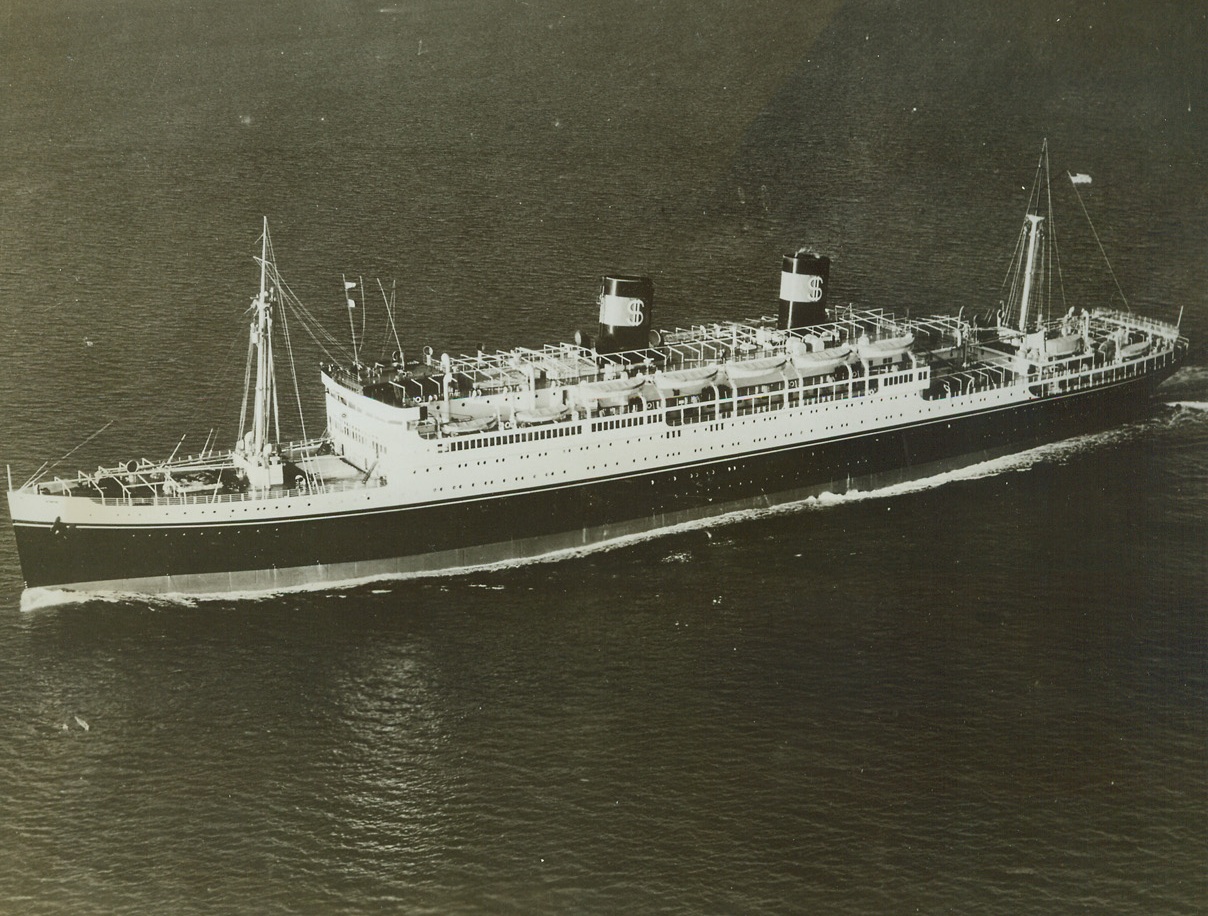
Troop Transport Sinks, 12/12/1942. Washington, D.C.—The Navy announced today that the U.S. Liner “President Coolidge,” transporting approximately 4,000 Army troops, struck a mine in the South Pacific and sank with a loss of only four men. The ship, the 10th transport to be sunk in this war, went down recently, but the Navy did not disclose the exact date or the part of the South Pacific in which the sinking occurred.Credit: ACME.;
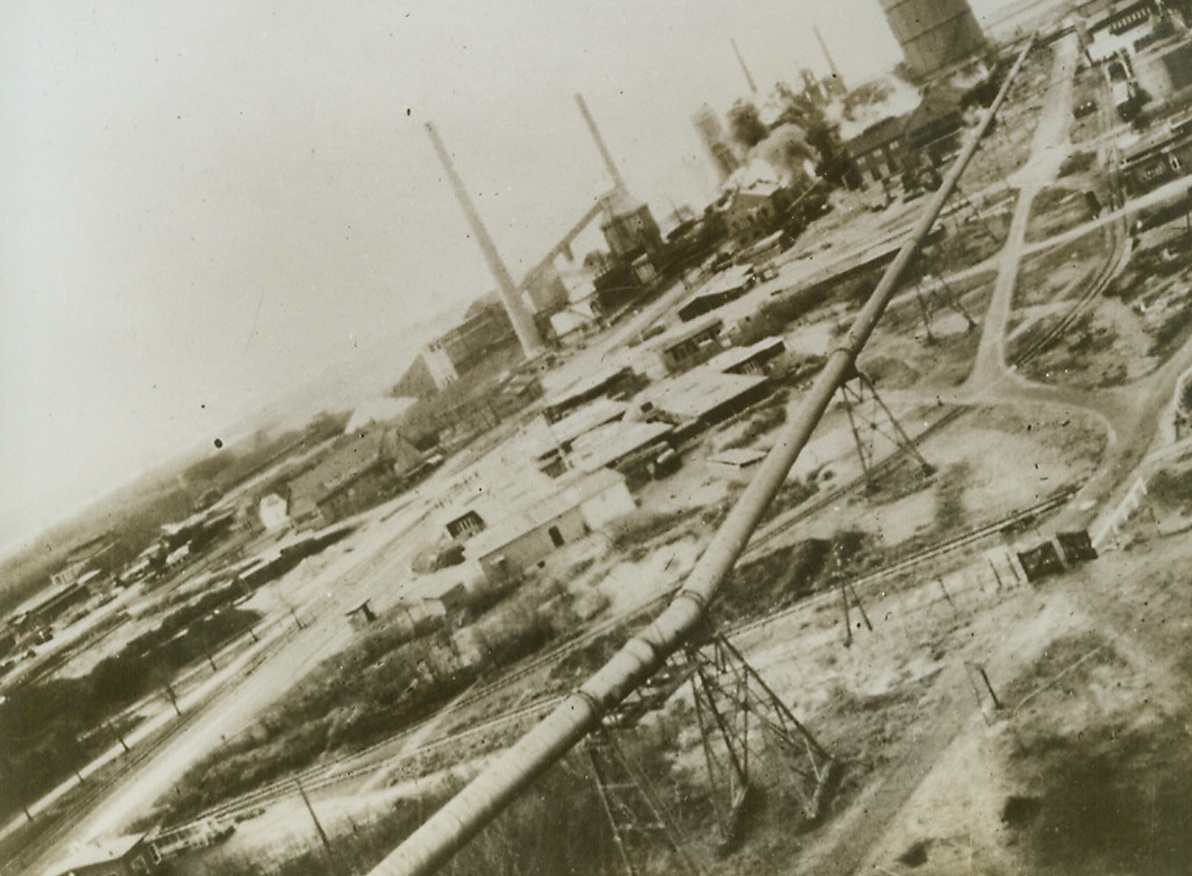
Boston Bombers Blast Dutch Works, 12/28/1942. Smoke wells up from the target area as the unescorted Boston Bombers that successfully attacked Nazi-controlled steel works in Holland fly away unharmed. The angle of the photo gives indication of how long the American made planes in the R.A.F. Bomber Command were flying in the daring daylight attack. It looks like a direct hit on the tanks of the Benzol by-product plant at the Royal Dutch Blast Furnace and Steel Works at Velsen.Credit: ACME.;
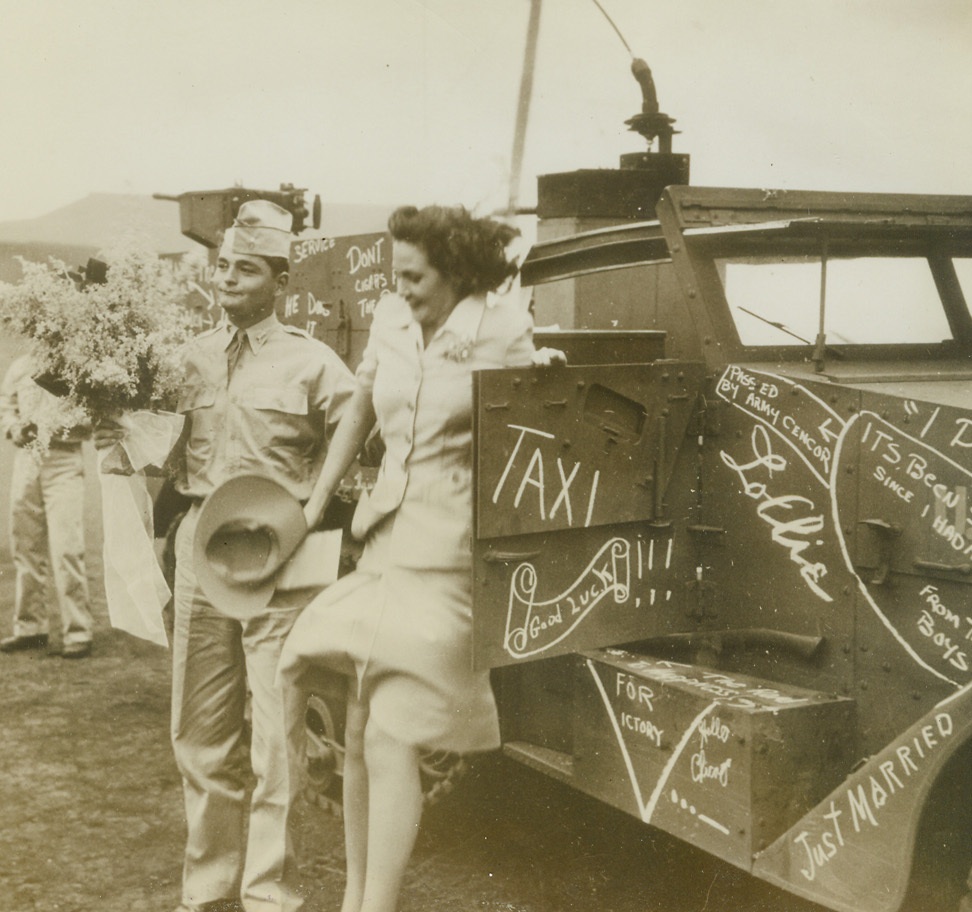
Transportation Free, 12/8/1942. Hawaii—First Lt. Donald Brattain wears a strange newly-wed smirk as he helps his bride out of the half-truck obligingly furnished—and decorated—by armored Force buddies. Young Lt. Brattain is the son of the Eastern Air Lines Vice President. His bride, Frances Masconellos, was a stenographer at an airfield in Hawaii. Now they’re man and wife and happy about the whole thing.Credit: ACME.;
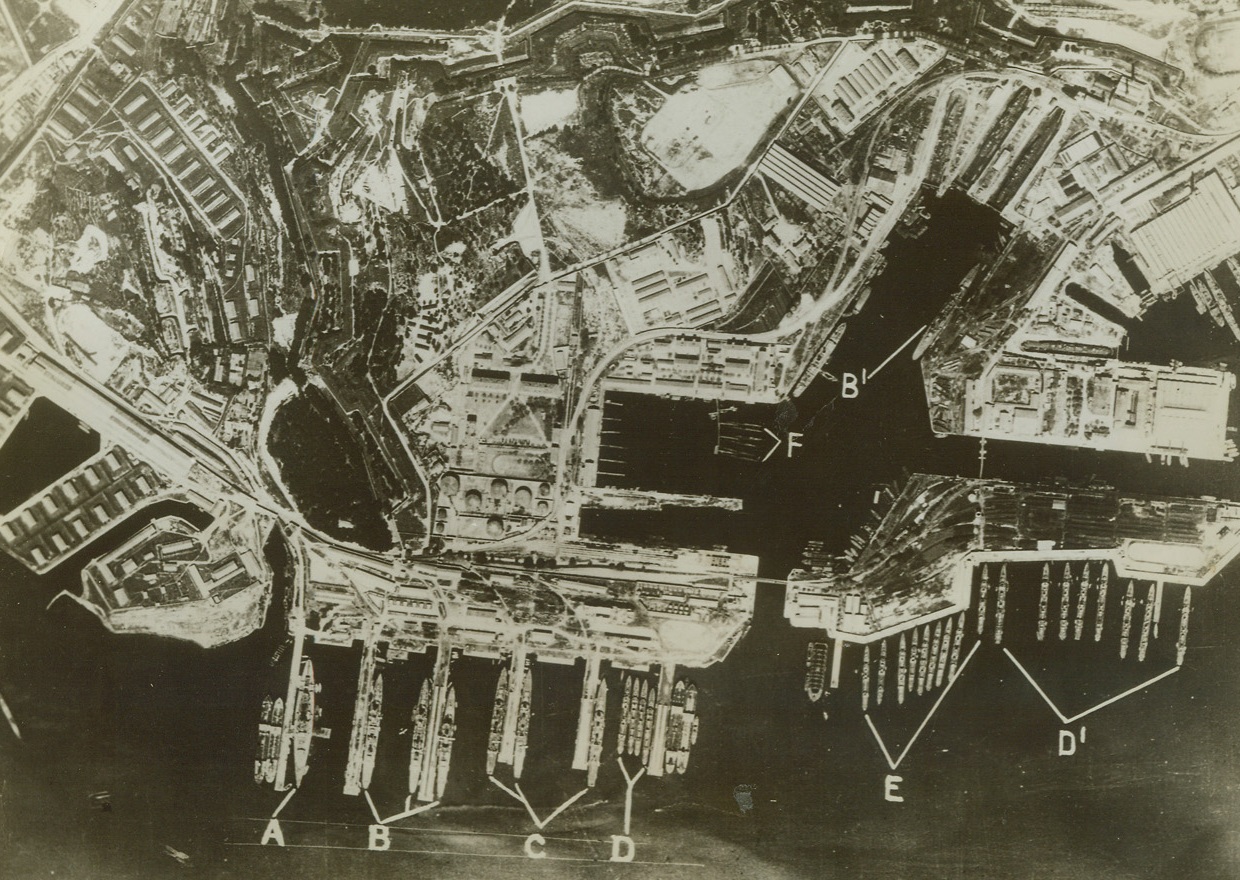
BEFORE THE SACRIFICE, 12/13/1942. TOULON – This aerial view of the inner harbor of Toulon, made before the German march into unoccupied France which caused the order to scuttle the warships, shows part of the lost and valiant French fleet. The 25,000-ton battleship Strasbourg, at “A” was among those scuttled. “B” and “BI” designate 8-inch cruisers; “C” marks 6-inch cruisers; “D” and “DI” point to Contre-Torpilleurs. A larger class of destroyer; “E” shows other destroyers and “F” points out submarines.Credit: Acme;
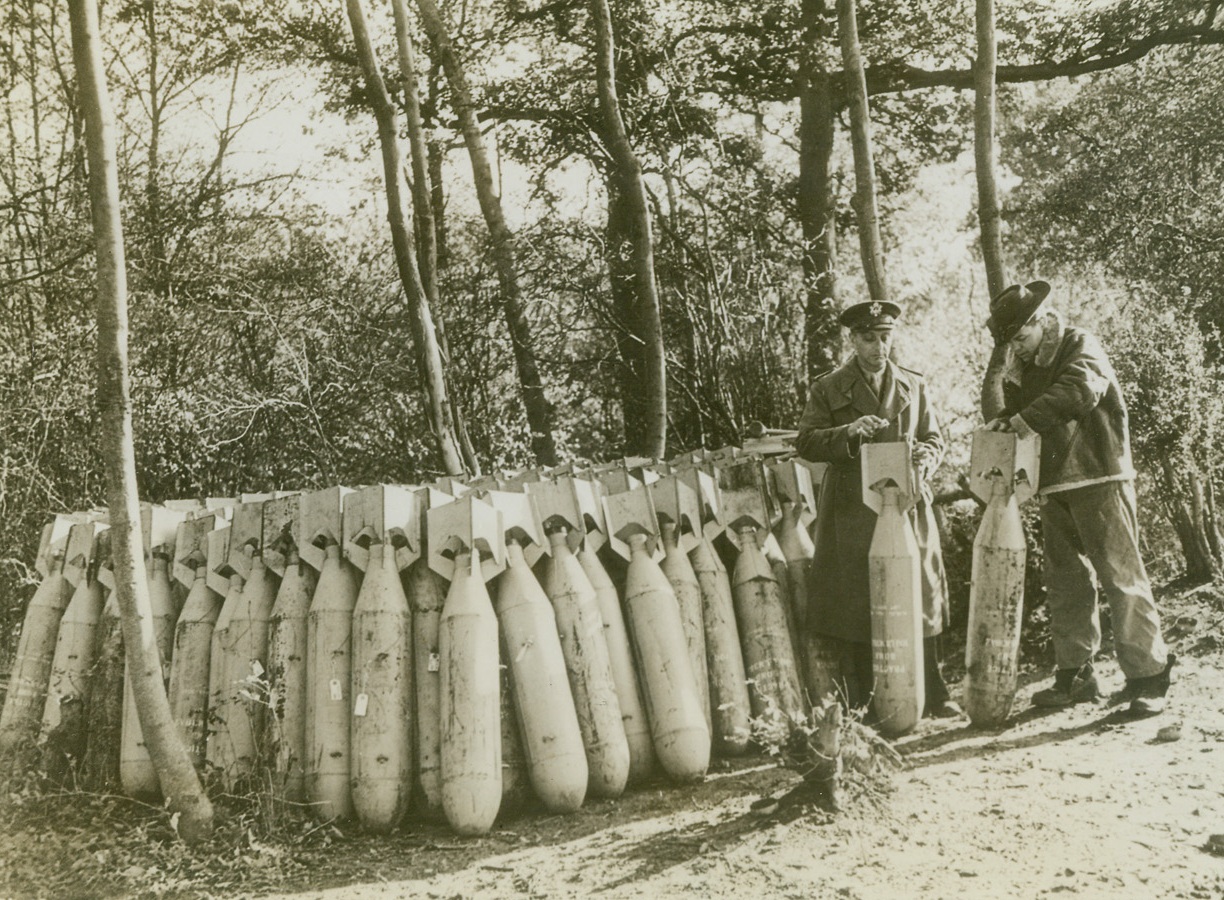
FIRST AMERICAN BOMBS IN ENGLAND, 12/11/1942. ENGLAND – The American air effort in England has progressed from U.S. pilots flying with the R.A.F., American bombers dropping British bombs, and finally American crews flying American bombers from their own stations in England to drop American-made bombs. Here are some of the first 100 lb bombs being readied for their trip to the axis on “Liberators”.Credit: Acme;
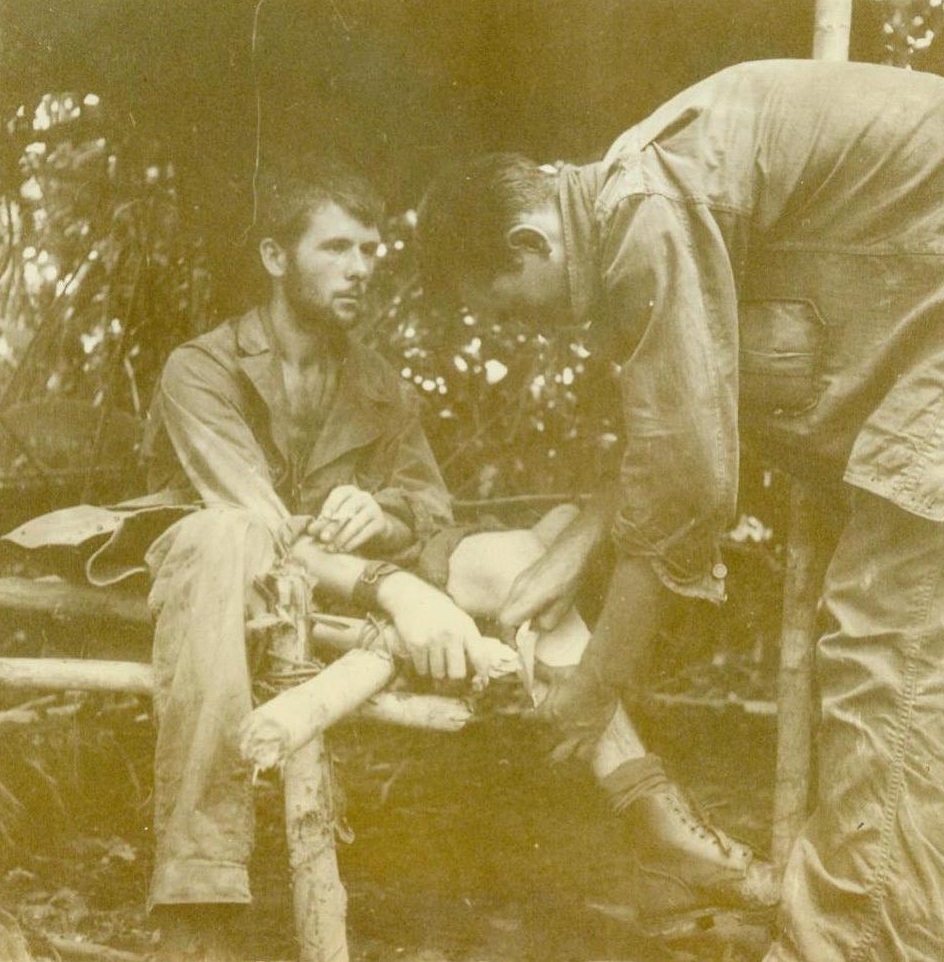
He Can Take it!, 12/15/1942. New Guinea – Described as a “wild man” by his buddies and credited with killing between thirty and forty Japs, as his unit crossed New Guinea on their way to strike at the Nips in the Buna-Gona area, Pfc. Orin Sutton, (left), of Charlevoix, Mich., couldn’t be worried by a mere Jap machinegun bullet. He was back in action in a few days. Pfc. Allie Poole, of Petersburg, Mich., is shown, (photo above), bandaging the wounded leg. This photo has just been released in Washington. CREDIT LINE (ACME) 12-15-42;
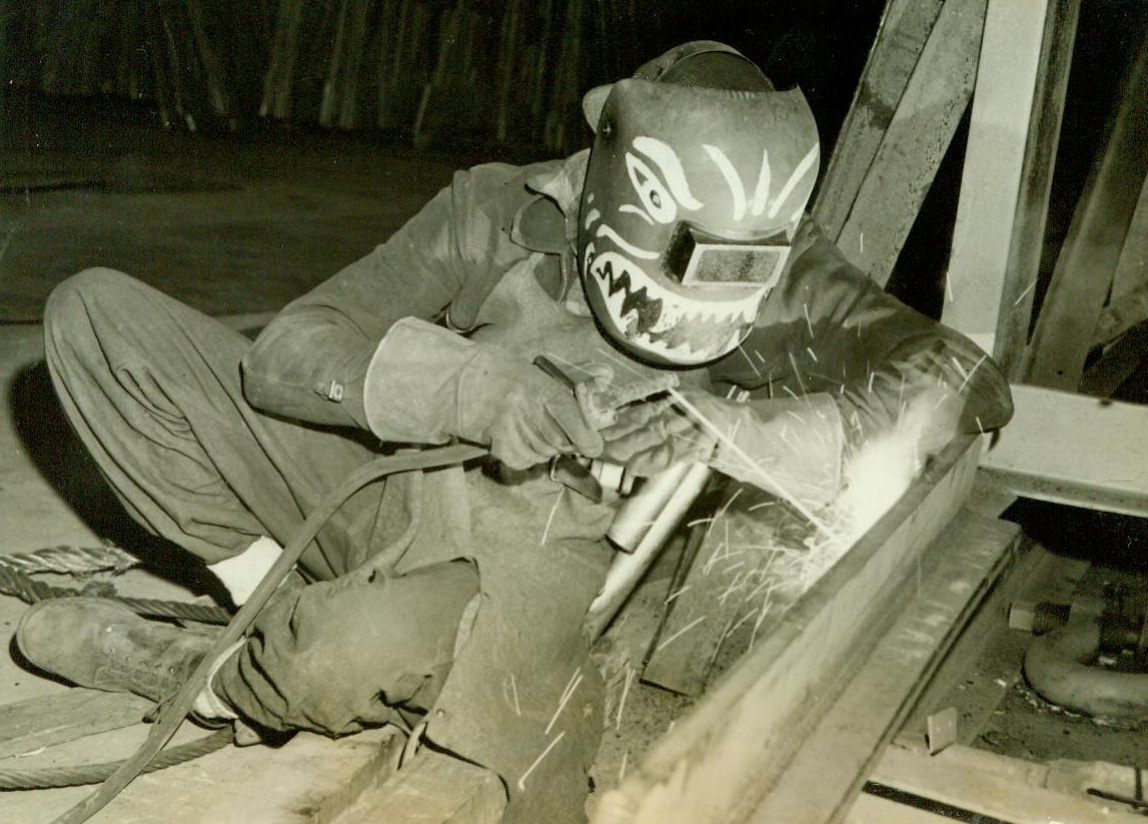
Pre-fabricated Ships Built 4 Miles From Ways, 12/12/1942. CHICAGO – Traditionally, laying of the keel marks the beginning of a new ship, but under a system developed by the Pullman-Standard Car Manufacturing Company, naval patrol bessels are being constructed in 14 completed sections simultaneously, the keel being a part of each section. Each of the 14 sections is assembled complete with deck plates, bulkheads, and much of the interior fittings, in a building of the Pullman Plant, Chicago, and carried on flat cars to the ways, four miles distant. At the ways, the center and stern sections are assembled first, because they require more interior fitting. This fitting is done while the bow sections are being put one time, have been built on reclaiming land at the end of Lake Calumet, on the far south side of Chicago. PHOTO SHOWS one of the welders his mask painted to resemble the Flying Tiger insignia, working on a pre-fabricated section. CREDIT (ACME) 12-12-42;
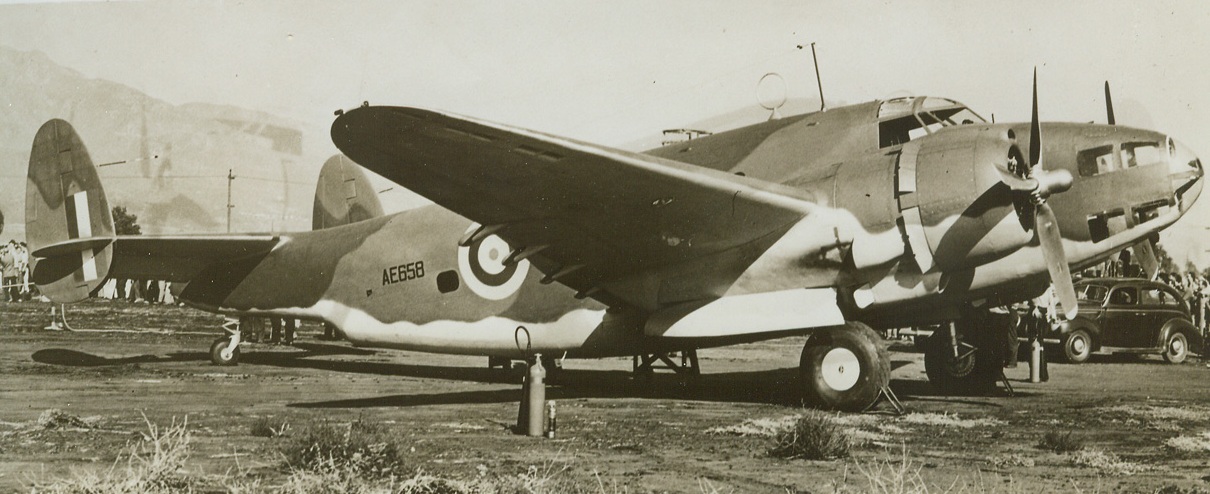
VENTURAS OPERATE OUT OF BRITAIN, 12/8/1942. LONDON:--The British Air Ministry revealed that the American-made Ventura bombers (one of which is shown here) participated in the devastating “zero level” raid on the Philips radio works at Findhoven, Holland. The Ventura is a twin-engined Lockheed-Vega plane, based on Lockheed Loadstar air liner design, with a quick takeoff and ability to climb swiftly at very sharp angle. Credit Line (ACME);
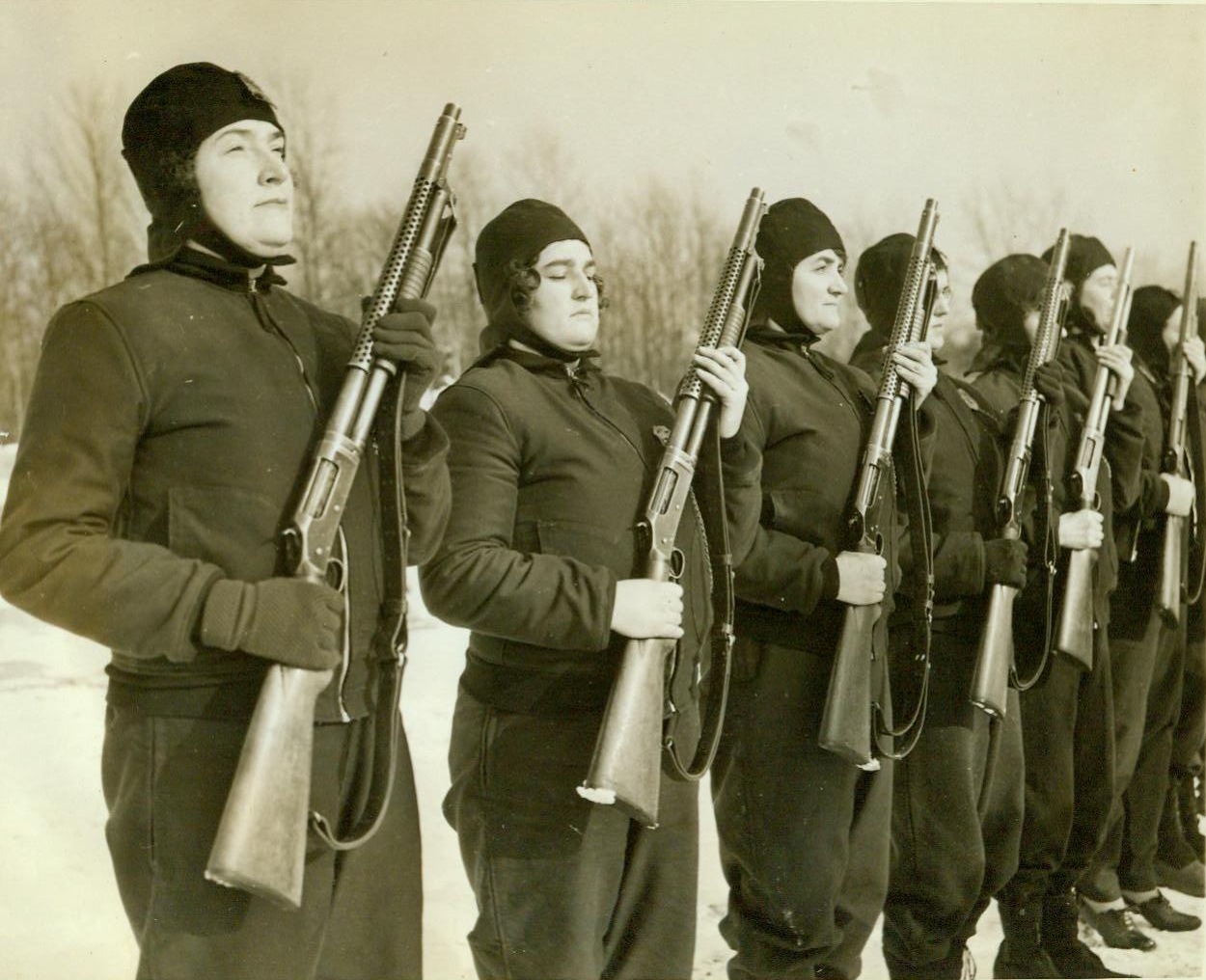
Guardians of Naval Air Station, 12/16/1942. South Weymouth, Mass:- Because they had the ability to pass a stiff civil service examination, these women were given the important task of Guarding the U.S. Naval Air Station at South Weymouth. They are the first civilian women assigned to such duties, and have released Marine and civilian male guards to more important tasks 12/16/42 (ACME);
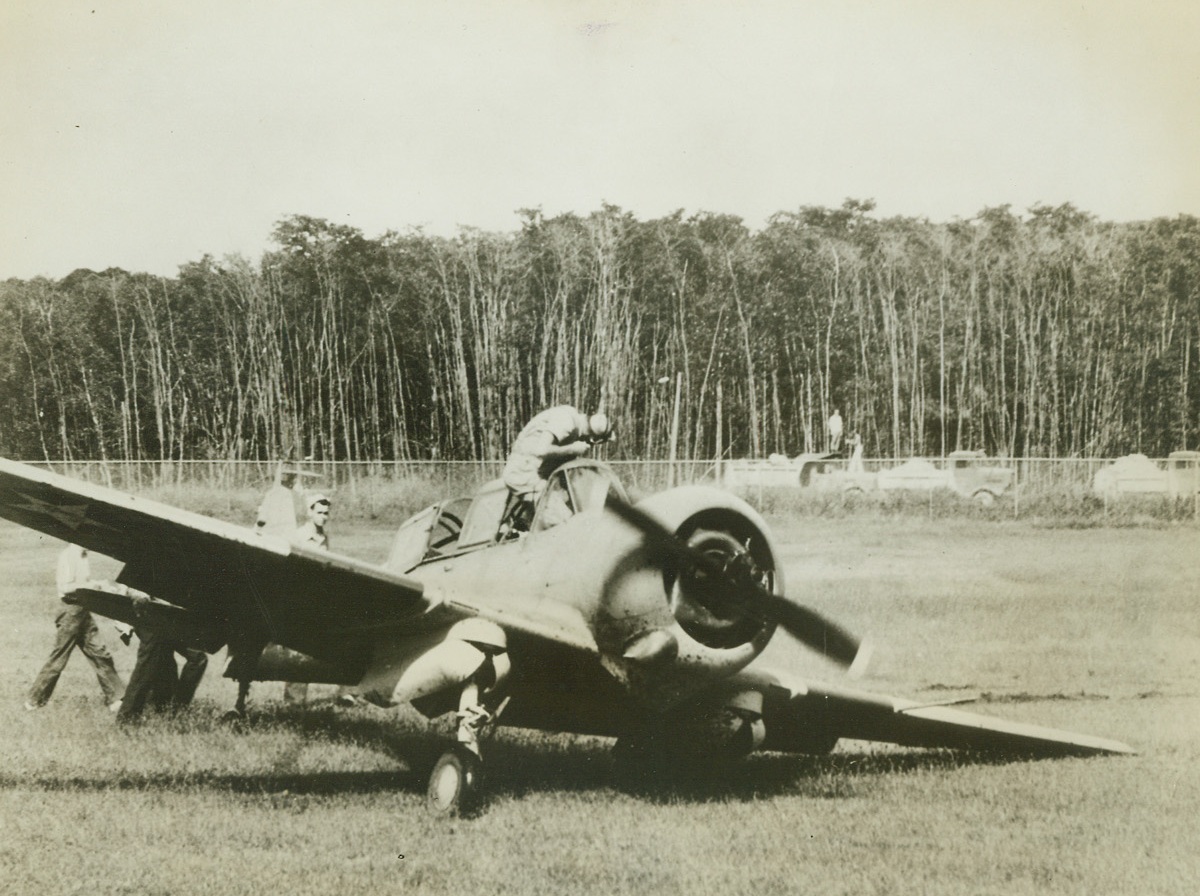
Ticklish Landing, 12/18/1942. After making a slanted, dangerous landing with one wheel up and the other down, the pilot crawls out of the cockpit of a Navy SNC plane. There are two tributes to the skill of the pilot in this picture—he is under his own power, and the craft is not badly damaged. The landing he made was almost impossible to execute without heavy damage. Credit: Official U.S. Navy photo from ACME;
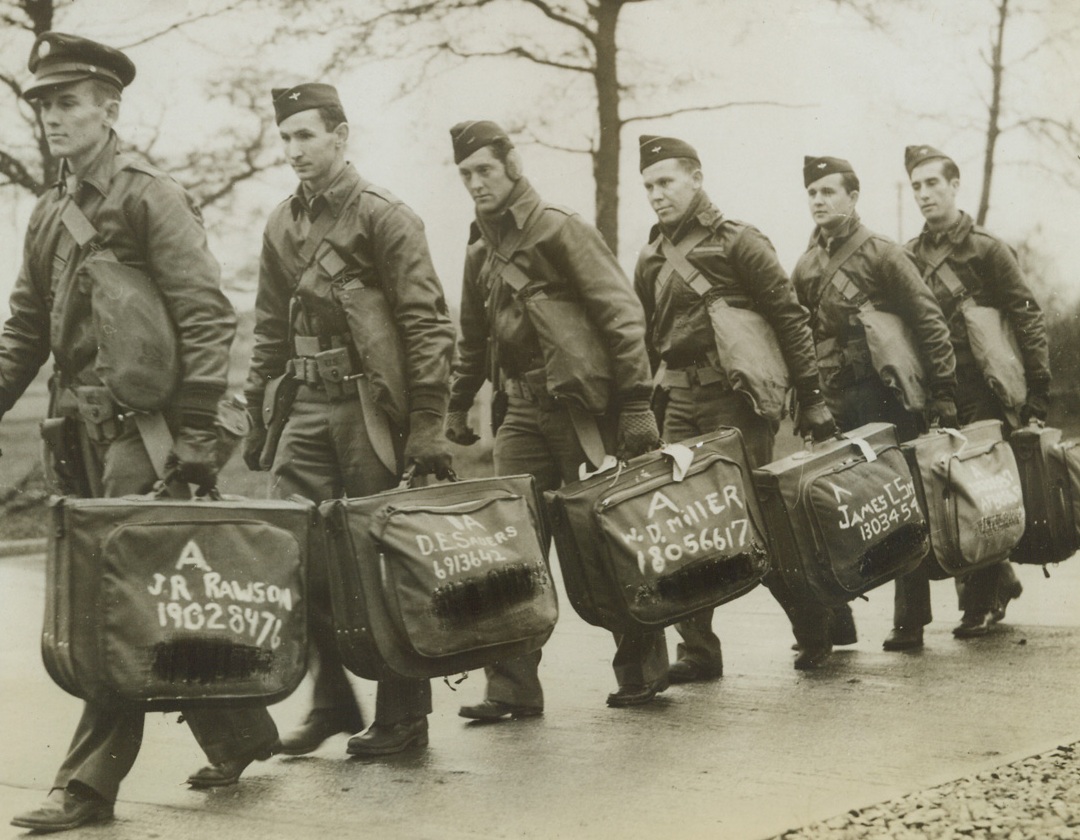
First American Sergeant Pilots in England, 12/26/1942. These American Sergeant Pilots were the first to go over to England. They are shown arriving at a replacement center. Passed by censors. Credit: ACME;
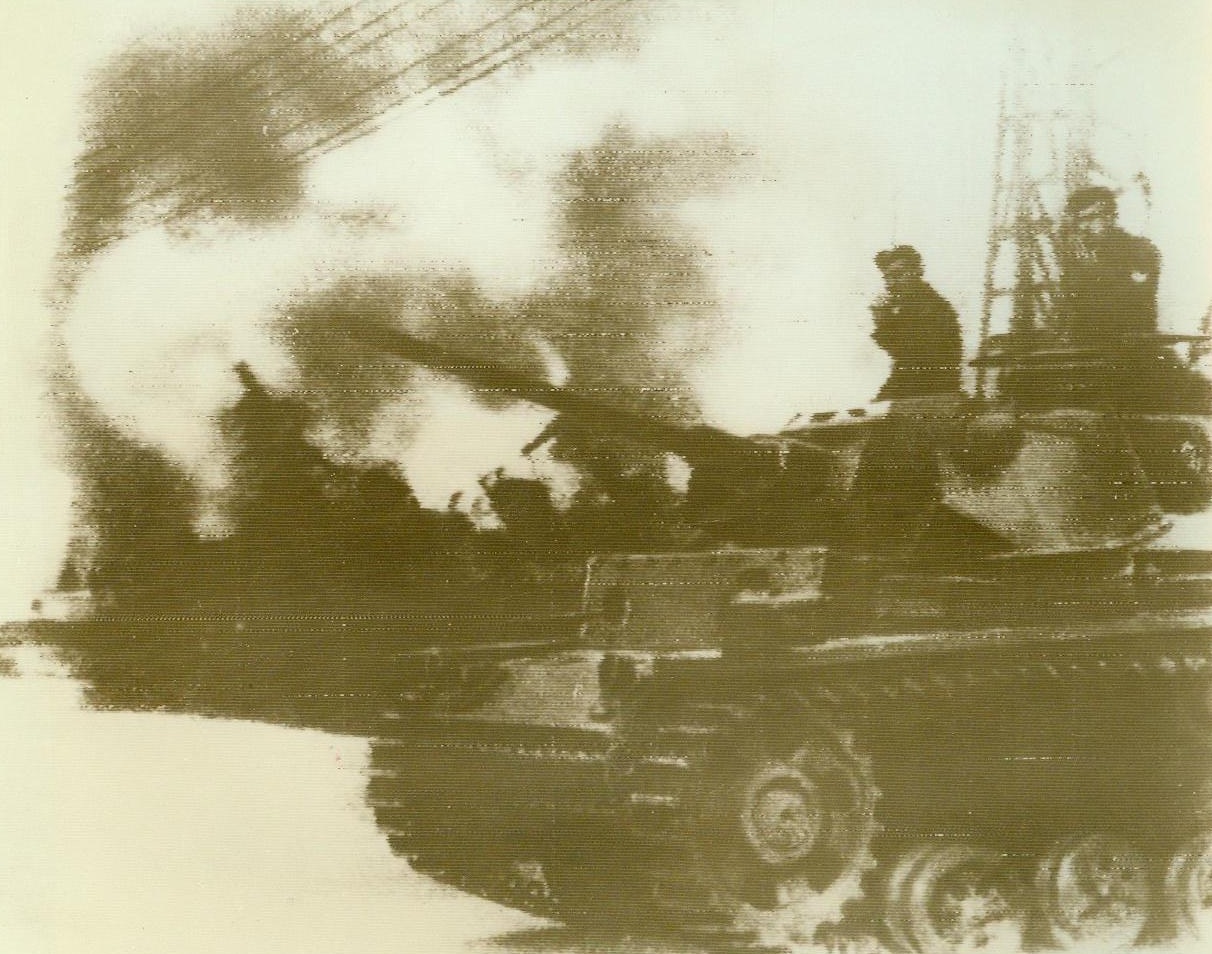
Toulon Scuttling Bared, 12/16/1942. Toulon, France – Exclusive ACME radiophoto shows a German tank arriving at the scene of the scuttling of the French fleet in Toulon harbor as a battleship burns in the background. RAF photos, taken on the day after the scuttling reveal that virtually the whole fleet was sunk. The battleship Strasbourg, although not sunk, has settled and grounded in the harbor. 12/16/42 (ACME Radiophoto);
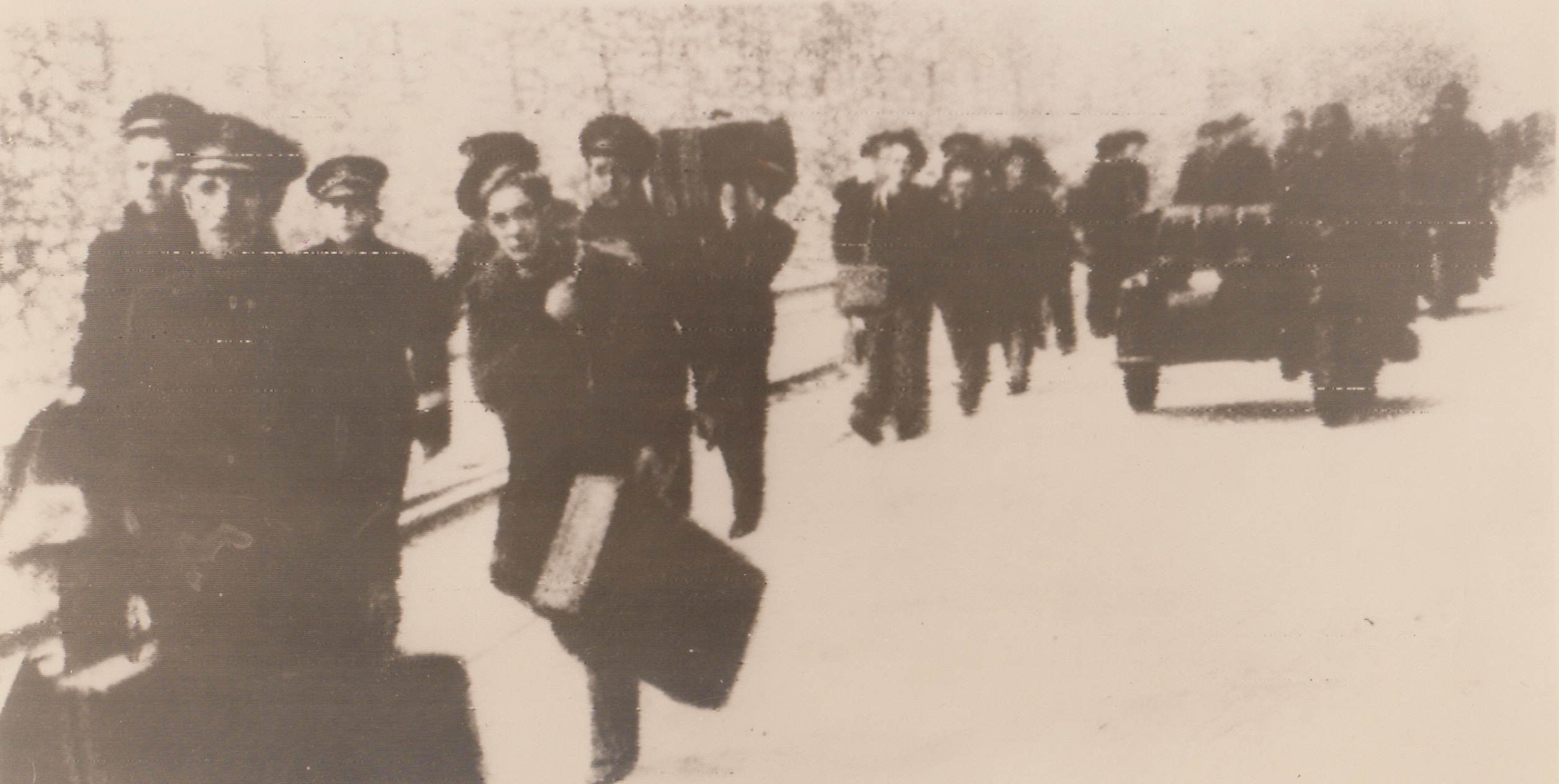
Under Arrest, 12/16/1942. Toulon, France – French sailors march away, under arrest, after the scuttling of the French Fleet at Toulon. Latest reports from London, based on photos taken by the RAF on the day following the scuttling, reveal that virtually the whole fleet was sent to the bottom of Toulon harbor. The battleship, Strasbourg, was not sunk, but aerial photographs show that she has settled and grounded. This exclusive Radiophoto was received from London. 12/16/42 Credit Line (Acme Radiophoto);





 Trash & Recycling
Trash & Recycling
 Online Payments
Online Payments
 City Documents
City Documents
 Parks
Parks
 Traffic Court
Traffic Court
 CITY PARKS
CITY PARKS
 Outdoor Recreation
Outdoor Recreation
 Volunteer
Volunteer
 Home
Home TRANSLATE
TRANSLATE
